
Admin
-
Posts
7,486 -
Joined
-
Last visited
Content Type
Profiles
Forums
Events
Store
Gallery
Community Map
Posts posted by Admin
-
-
Hello WheelieGoodTime,
Welcome to The Motorbike Forum. Please feel free to browse around and get to know the others. If you have any questions please don't hesitate to ask.
Why not tell us a bit about yourself too.
-
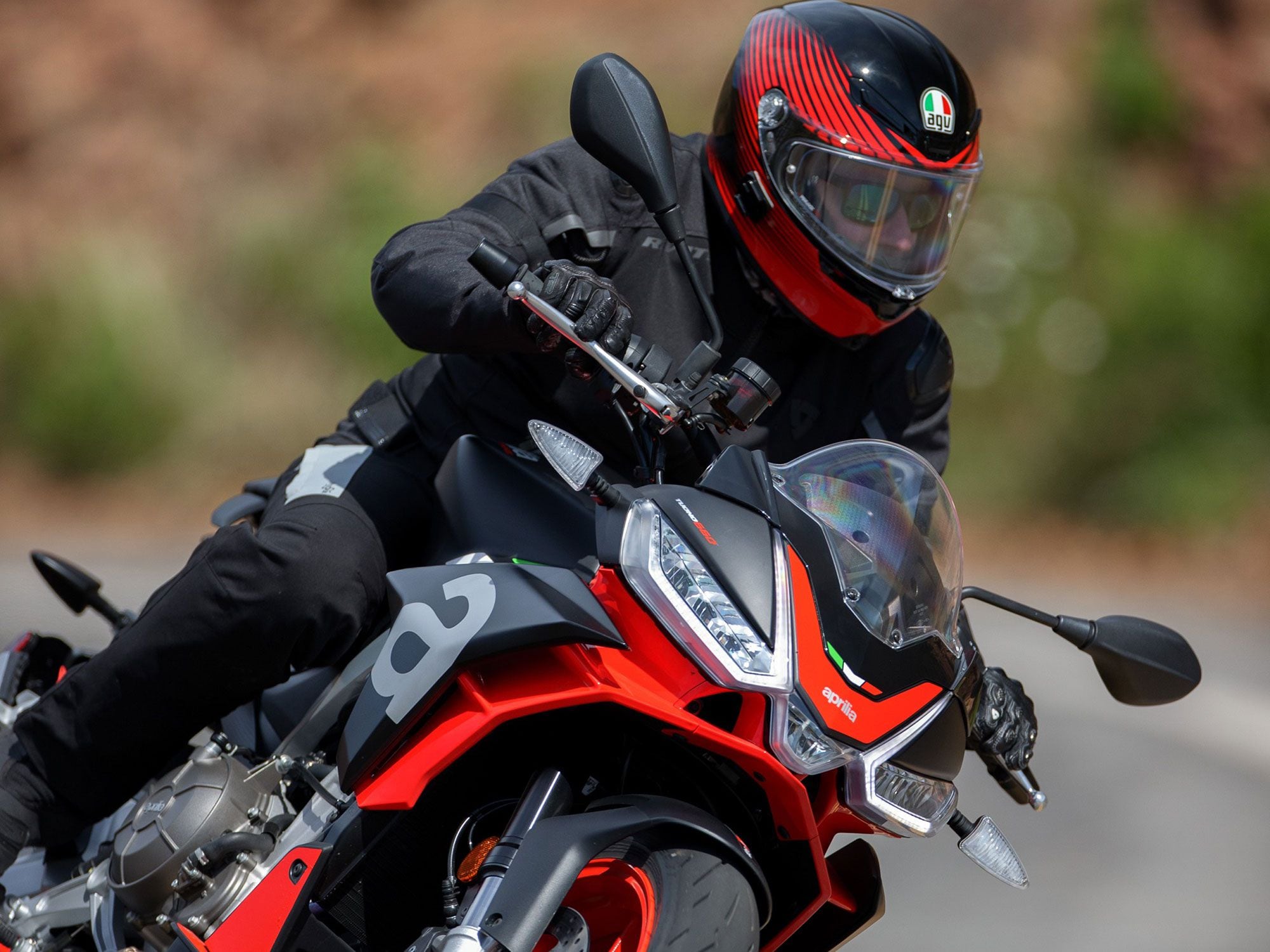
Aprilia’s new 2021 Tuono 660 is set to hit North American dealers sometime this spring. (Aprilia/)When Aprilia introduced its RS 660 middleweight sportbike last year, it was met with near unanimous praise from the motorcycling press, including our own Bruno dePrato. Billed as an affordable, capable tool for intermediate riders, the user-friendly sport model was hailed primarily as a streetbike with trackday capabilities, a welcome tool for aspiring racers on the hunt for a more versatile machine. Naturally we wondered if Aprilia would also present us with a more relaxed, street-ready version of the RS’s aluminum-framed, 659cc parallel-twin package. The company had put plenty of R&D, design, and engineering work into the new 660 platform, clearly planning to expand its product portfolio with an extended family of bikes. In other words, we guessed the firm’s rowdy RSV4 and Tuono V4s would be joined by more approachable middleweights, which would, in theory, appeal to a rider demographic with a border range of both skills and finances. Sure enough, Aprilia didn’t make us wait long. The more streetable Tuono 660 was officially announced as a new 2021 model just a few months ago, and an invitation to sample the bantamweight in Malibu came soon thereafter.
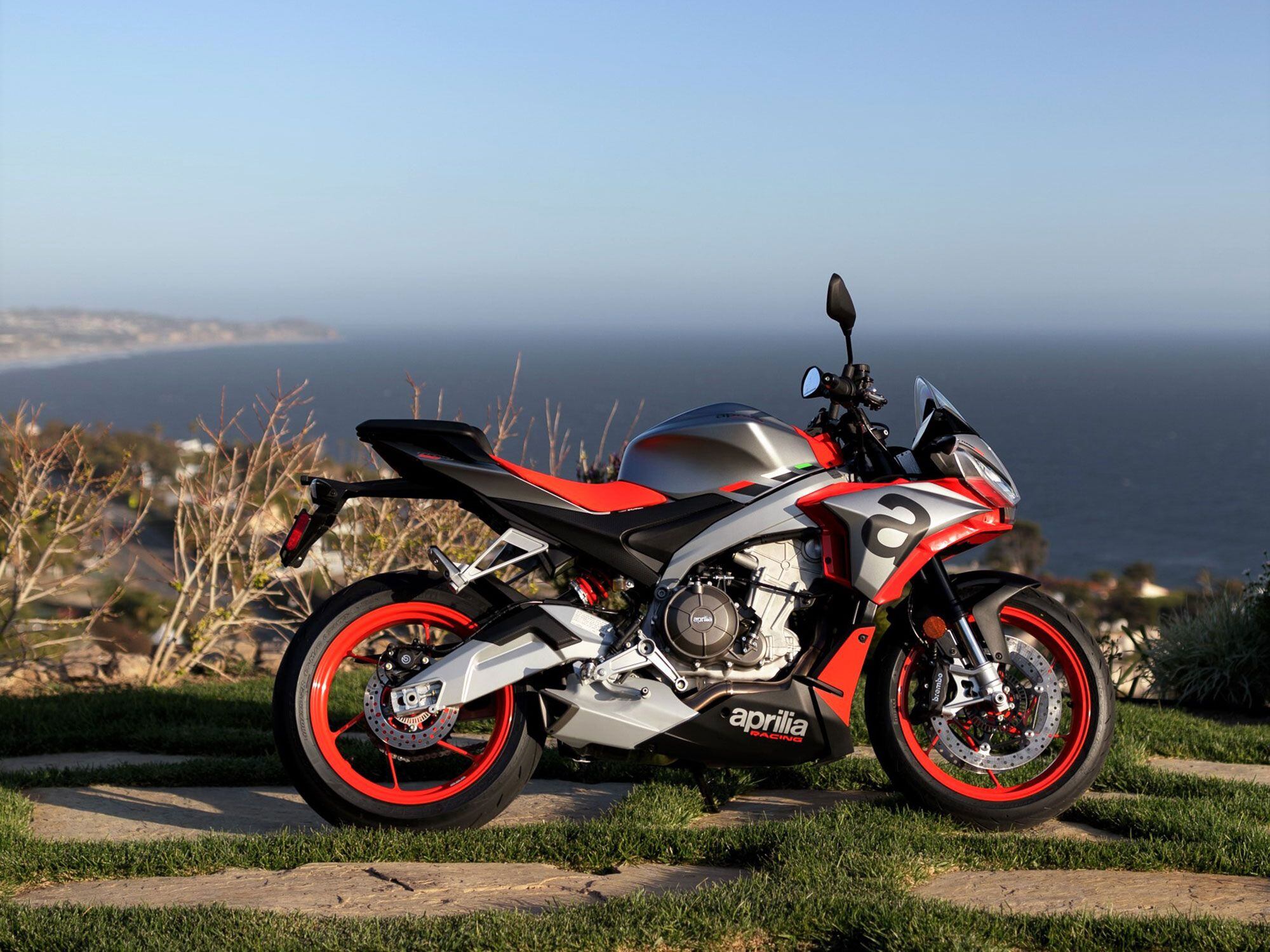
More upright than its RS brother, the Tuono 660 targets a different slice of the 600cc market. (Aprilia/)The plan, as the best plans are, was simple. The technical brief was an outdoor walkaround of the new bike followed up with several spec sheets and notes emailed to us. Our small group of moto press folk would then ride out from the remote base in the Malibu hills and strafe snaky canyon roads in the Santa Monica mountains for the day.
To hear Aprilia reps tell it, the Tuono 660 looks to fill the slot between laser-focused 600cc supersports and more sedate middleweight budget bikes. Its agile and powerful yet approachable foundation adds higher-end componentry to give it versatility the others don’t have. In Aprilia’s middleweight world, the RS would take up the sporting end of the spectrum while the Tuono would be tasked as a daily rider.
We noticed the Tuono’s resemblance to the RS right away, its crisp styling highlighted by a distinct triple beam LED headlight on the front face, though the stubbier windscreen occupies much less real estate and the fork is black. The Tuono shares much of its spec sheet with the RS 660, including the DOHC parallel-twin engine with 270-degree firing order bolted to a dual beam aluminum chassis, but there are subtle differences. The Tuono has two frame anchor points to the engine (the RS 660 uses three) for easier and more predictable behavior on the road, according to Aprilia, and the handlebar is a one-piece unit that’s taller and more swept back. The footpegs are positioned differently and wear rubber inserts. Dedicated yokes change the fork offset ever so slightly to tweak handling and stability. Also missing on the Tuono, though available as options, are the standard quickshifter and six-axis inertial measurement unit which come standard on the RS. Aprilia may call its newest 660 a naked bike, but the bodywork bolted to its front flanks begs to differ, though we will admit the double-walled side panels are trimmed down quite a bit compared to the RS.
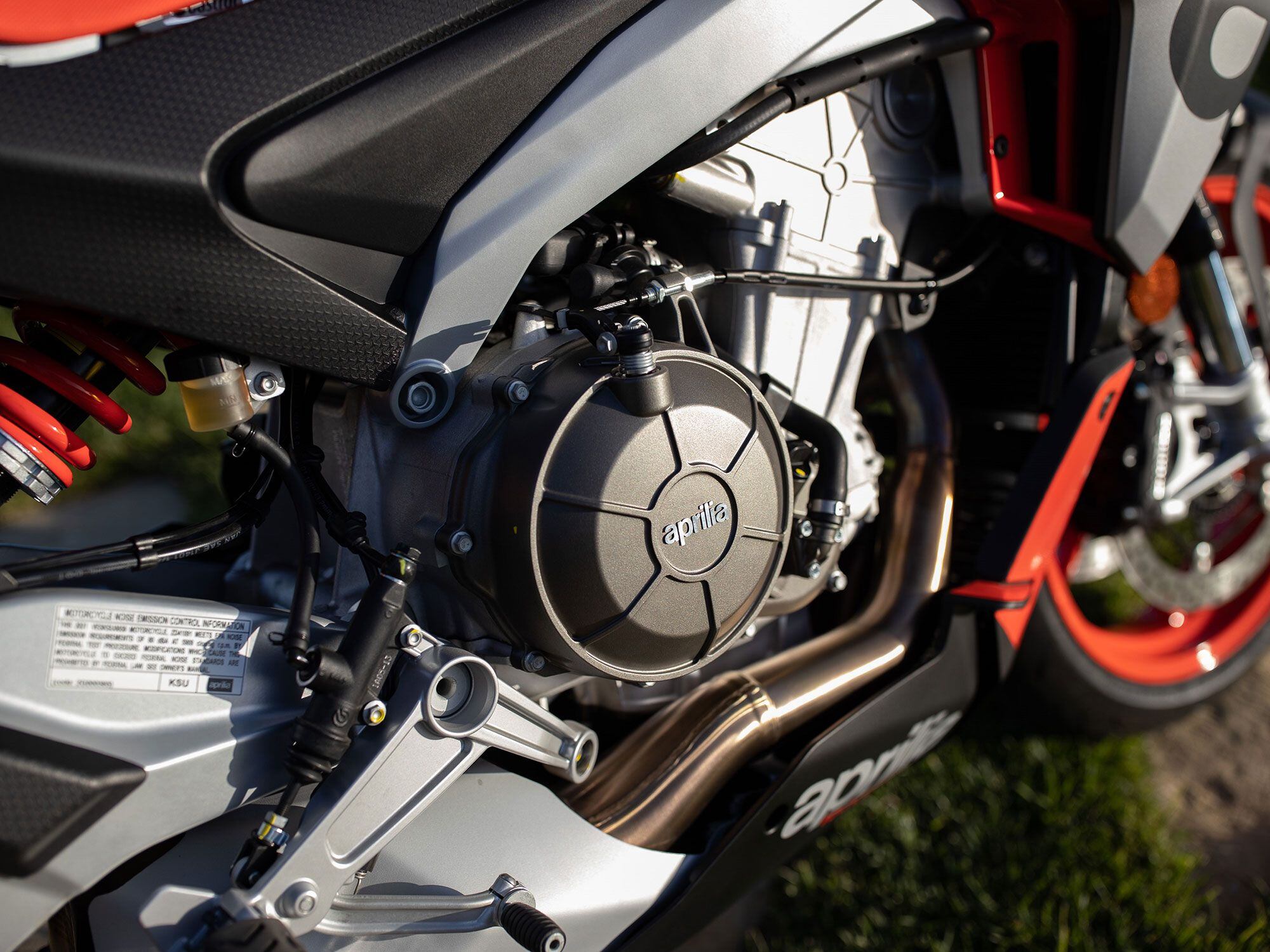
Engine-wise you get the same 100 hp parallel-twin engine, with a 13.5:1 compression ratio. (Aprilia/)However you want to spin it, the Tuono 660 was approachable the first time we swung a leg over the saddle, which sits 32.2 inches off the ground but feels much lower thanks to a narrow nose and sculpted shape. I stand 5-foot-6 with a 31-inch inseam, and with the suspension compressed beneath my 160 pounds, I could easily flat-foot boots on the pavement. The seat is nicely padded, and it’s an easy reach to the flat bar, with boots falling easily onto footpegs positioned under your hips where you want them. Toss in the fact that the Tuono claims a lightest-in-class wet weight of 403 pounds and you’ll understand why we had zero issues backing out of a bumpy downhill parking space.
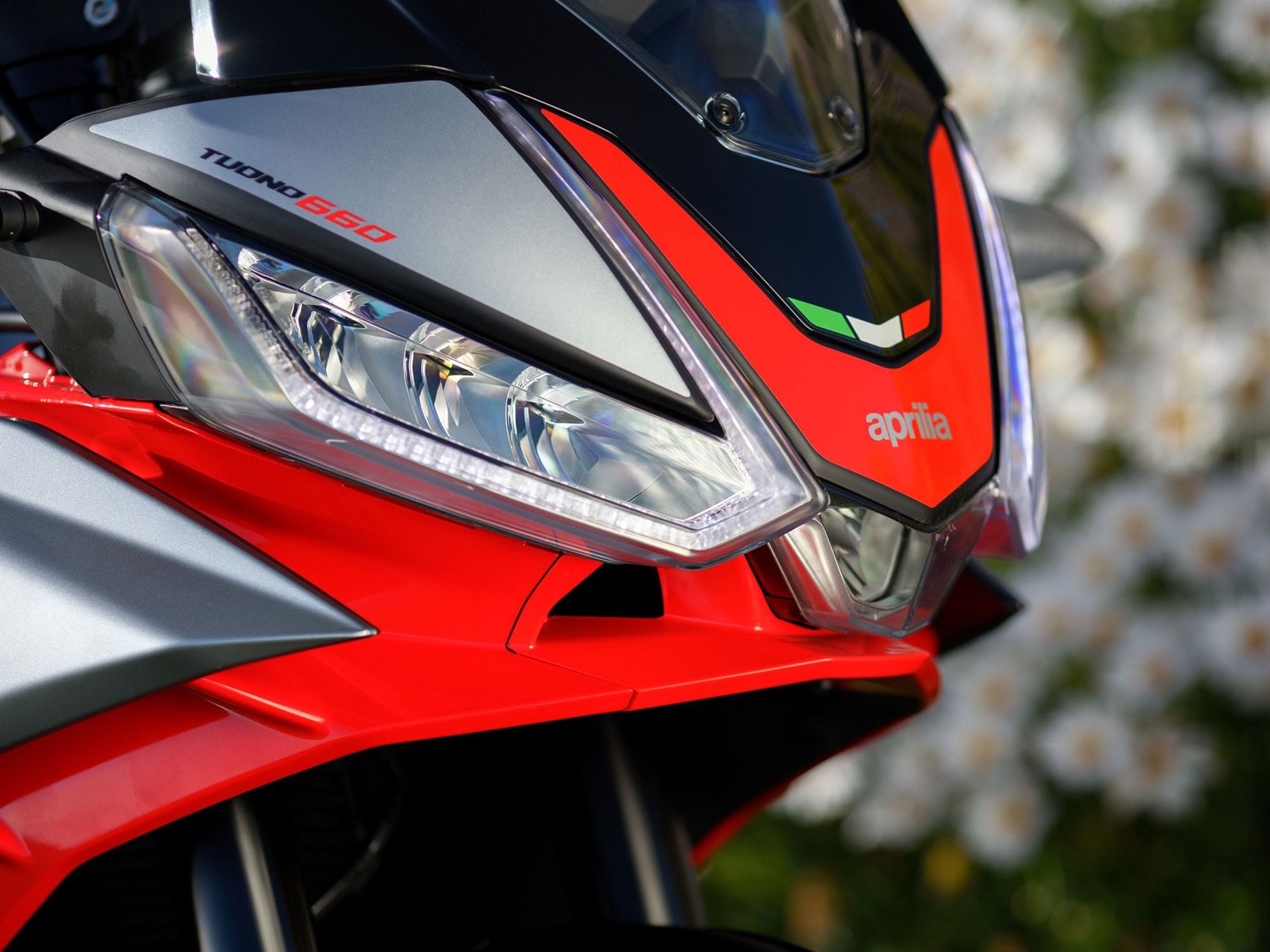
Crisp styling on the Tuono includes less cluttered triple beam LED headlight, keeping the family resemblance with RS on point. (Aprilia/)The day began with a short blast on the Pacific Coast Highway, where the liquid-cooled 659cc parallel-twin engine responded with ultrasmooth linear delivery from the bottom of its range to very close to its 11,500 rpm redline, flattening out near the top; we also sensed a slight flat spot in around 4,000–6000 rpm. The initial high-speed leg gave us a solid first impression of the bike’s neutral freeway manners, as throttle response was smooth and willing, fueling was drama-free, and the few vibes in the bars and footrests only became noticeable beyond 6,000 rpm, and then mostly in the lower gears. Unfortunately the mirrors also became a blur at those revs. More impressive was the Tuono’s torque character. The spec sheet claims a peak of 49 pound-feet at 8,500 rpm, but 80 percent of that punch comes at 4,000 rpm, allowing for a much more accessible powerband that’s tame down low, but wiling to get rowdy. Rev it out past that, and the engine gets even more responsive, pulling hard all the way to the 8,500rpm peak at which point it levels off. Another bonus you don’t often see on a 600cc middleweight? That would be cruise control, an easily managed one-button setup on the left bar.
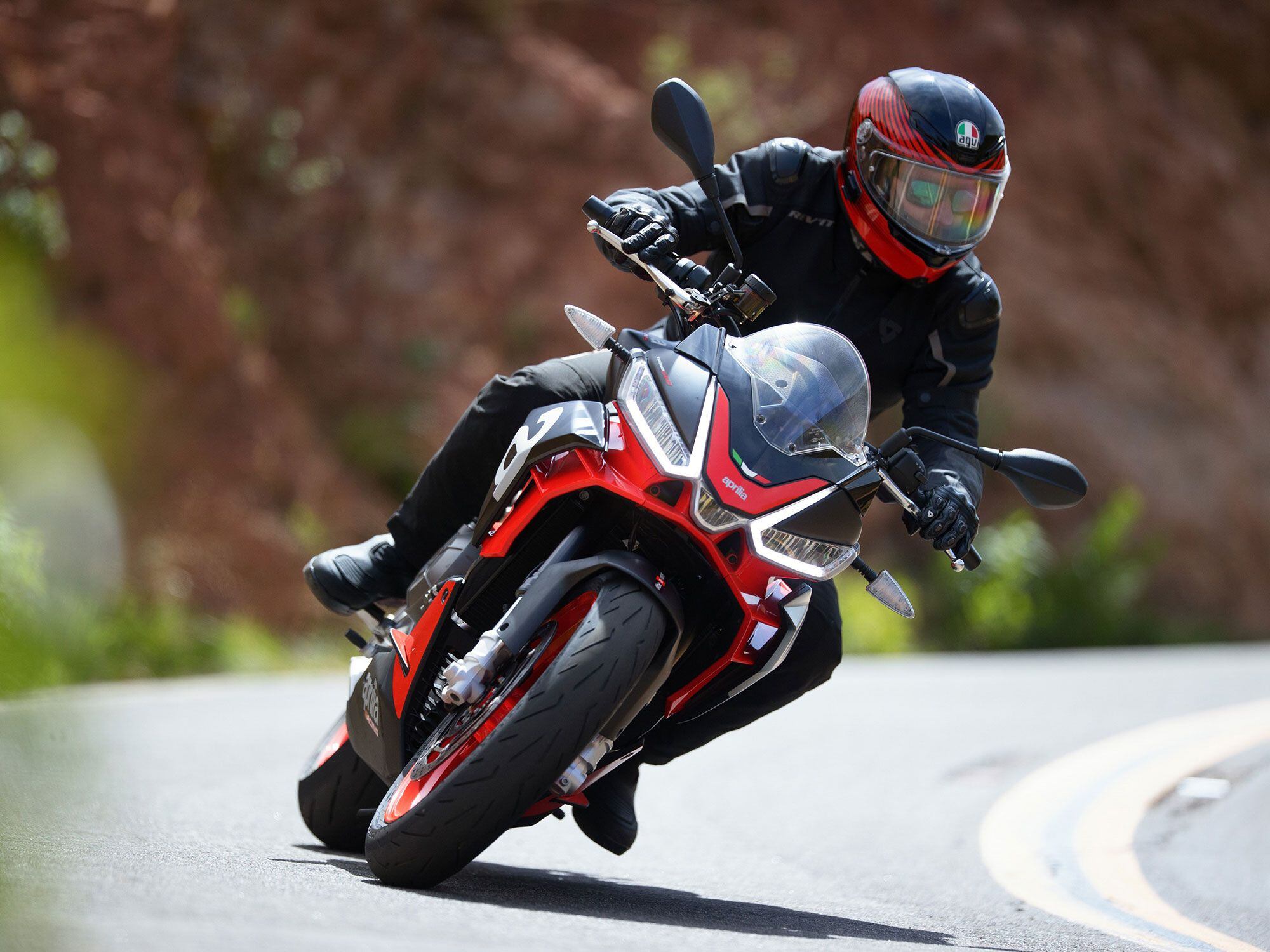
Neutral handling and a lightweight chassis makes for easy turn-in with minimal input. (Aprilia/)Venturing onto the winding backroad portion of our route gave the Tuono’s lightweight chassis a chance to show its stuff. Tipping it into corners came easily with just a touch of steering input, no exaggerated body movement needed to stick the line. The bike was nudged through the hairiest turns without complaint or stubbornness, sticking every ess with directional changes requiring only small inputs, body movement or not. Steering is light but planted, and the sticky Pirelli Diablo Rosso Corsa II rubber felt incredibly surefooted on the road. The light-effort clutch and slick shifting action made hitting the right gear a cinch (and with the equipped quickshifter, almost an afterthought), and with plenty of low-end torque available, we could quickly pull out of the lowest-speed situations.
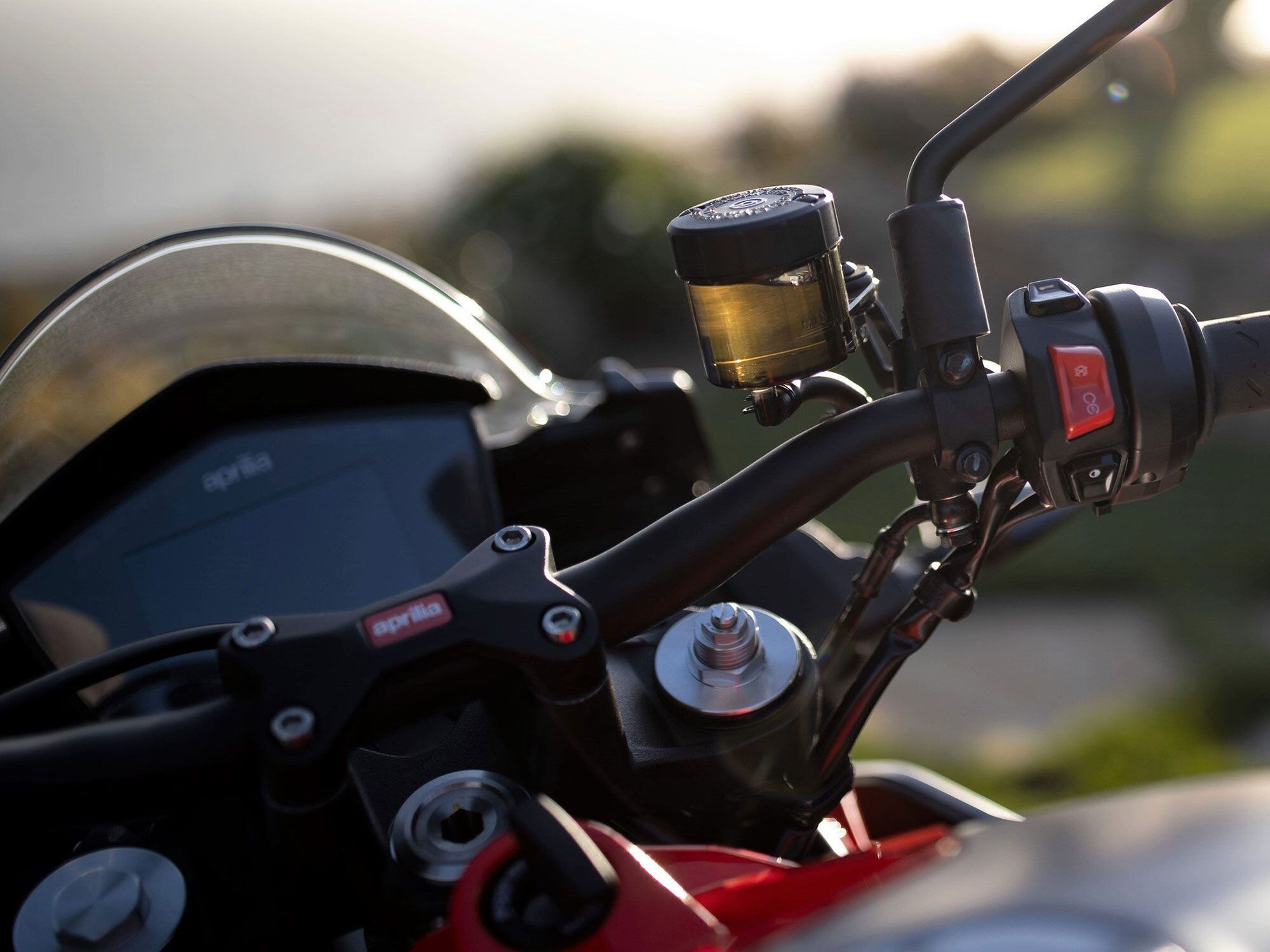
Lower-spec suspension means you’ll only have adjustability on the right fork leg of the Tuono 660. (Aprilia/)The Tuono’s suspension arrangement is virtually the same as on the RS, but the lower-spec 41mm inverted fork is adjustable for spring preload and rebound damping in the right fork leg only, and with 10mm (0.4 inch) less travel. The linkage-less single rear shock is also only adjustable for spring preload and rebound, but the settings suited me fine as they were with good damping control and overall stability over everything but the biggest depressions, which could upset the chassis if you hit them at speed. Heavier riders would want to add a few clicks of rebound for rougher roads, but as it came, the suspension felt extremely composed without being overly plush.
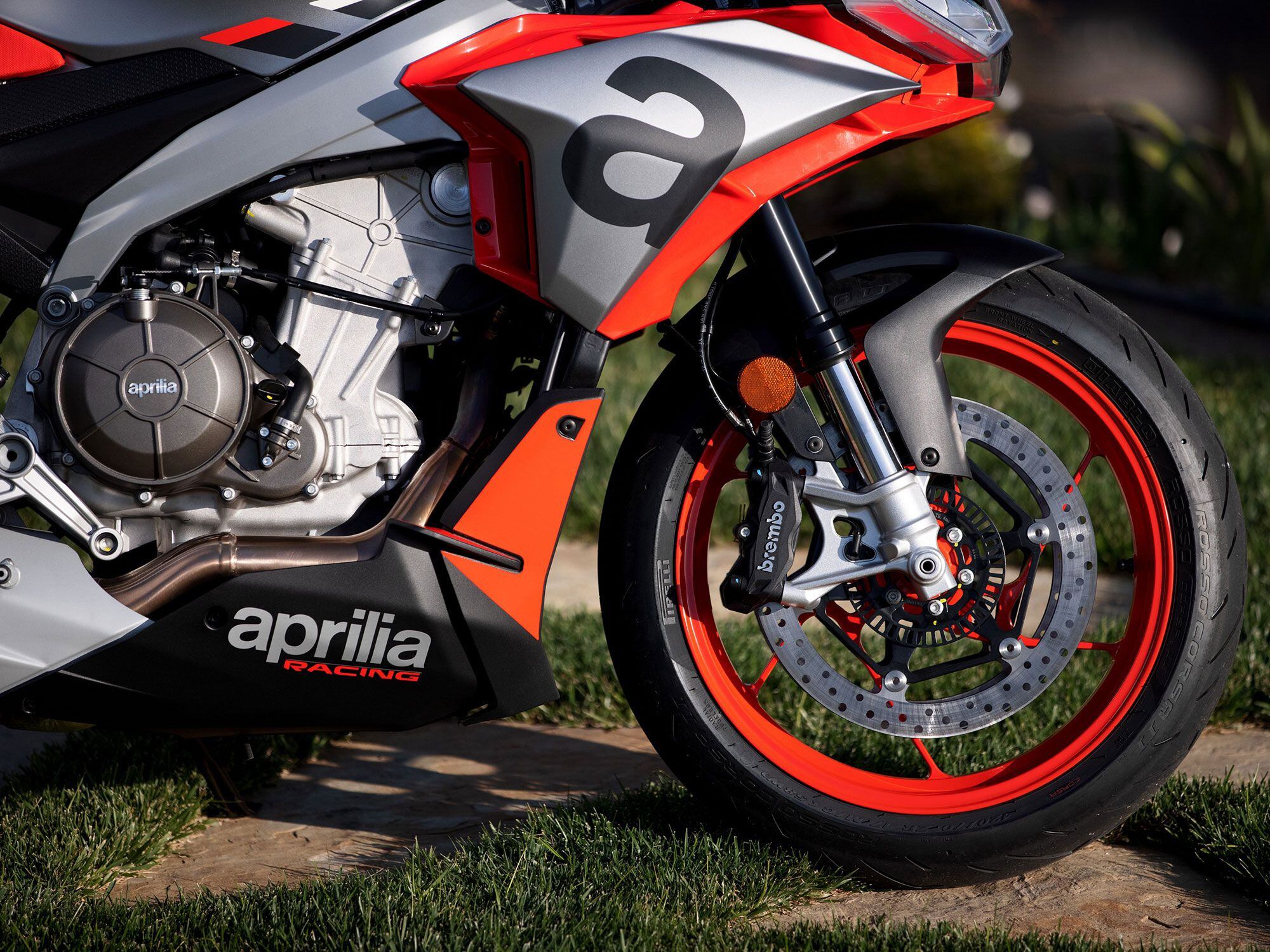
The Tuono 660′s brakes offer superb stopping power without any abruptness, plus they’re easily actuated. (Aprilia/)With an engine this easy to ride, you’re invariably going to have to scrub speed off quickly at some point. We’re pleased to report the Brembo arrangement fitted to the Tuono is more than up to the task. Even in consecutive quick stops, there was no fade. Braking performance is consistent and without abruptness, and is only ever an easy two-finger pull away. The rear brake, on the other hand, had much less feel; it felt mushy and didn’t have nearly as much bite.
There’s still plenty of power on tap here, but even when you goose it exiting a turn, the Tuono never feels like it’s riding you. There’s a complete feeling of control with this engine-chassis combo. The silky six-speed tranny lets you access as much performance as you’re looking to twist out of the engine’s more than capable 659cc. That’s further enhanced by a full suite of electronic rider aids including five ride modes, three presets for the road and two custom options for the track. We barely scratched the surface of possibilities here, keeping it mostly in the Commute or Dynamic presets, with maximum traction control and ABS at level 2, but suffice it to say that you can also tailor traction control, wheelie control, engine-braking, and select engine mapping. Experienced riders looking to get their drift on may want less intervention, and they can easily tweak the parameters to match their riding style. It’s all accessible via a color TFT display, further underscoring the Tuono’s robust feature set, though that display can be a bit difficult to read at speed. As mentioned, there’s also a bidirectional quickshifter option ($200) as well as a six-axis inertial measurement unit allowing even more precise management of the control parameters; it also enables cornering ABS and the Bending Lights functionality (also a $200 option).

Trickle-down tech from Aprilia’s bigger models includes the premium TFT dash, which allows you to access a full suite of electronic rider aids. (Aprilia/)After a full six-hour day we can confirm the Tuono’s upright riding position, relaxed feel, and nicely padded seat added up to a comfortable and extremely rider-friendly cockpit arrangement. The sound of that intake honk coupled with the 270-degree crank also meant that Tuono just sounds dead sexy, almost on par with its bigger V4 brothers, even at idle. And the stubby windscreen above the headlight even gave us some measure of protection from airflow, but let’s face it, you’re gonna feel the wind at speed on this setup. What’s more impressive is just how much versatility the Tuono, and by extension its 660cc platform, brings to the 600 class in terms of performance, engine character, and handling. Commuters can spend their days burbling around at sub-6,000 rpm and feel thoroughly inspired and yet totally comfortable, especially with cruise control as a standard feature. Meanwhile, track jockeys can rip into another level over six grand and feel some real juice. The Tuono 660′s $10,500 price tag might be off-putting to some. I thought it was a bit steep until I rode it. But the bike’s versatility and feature set could be just the right fit for certain riders caught in the space between full race mode and casual canyon enthusiast. In any case, it seems like Aprilia’s serious about being more than just a superbike manufacturer.
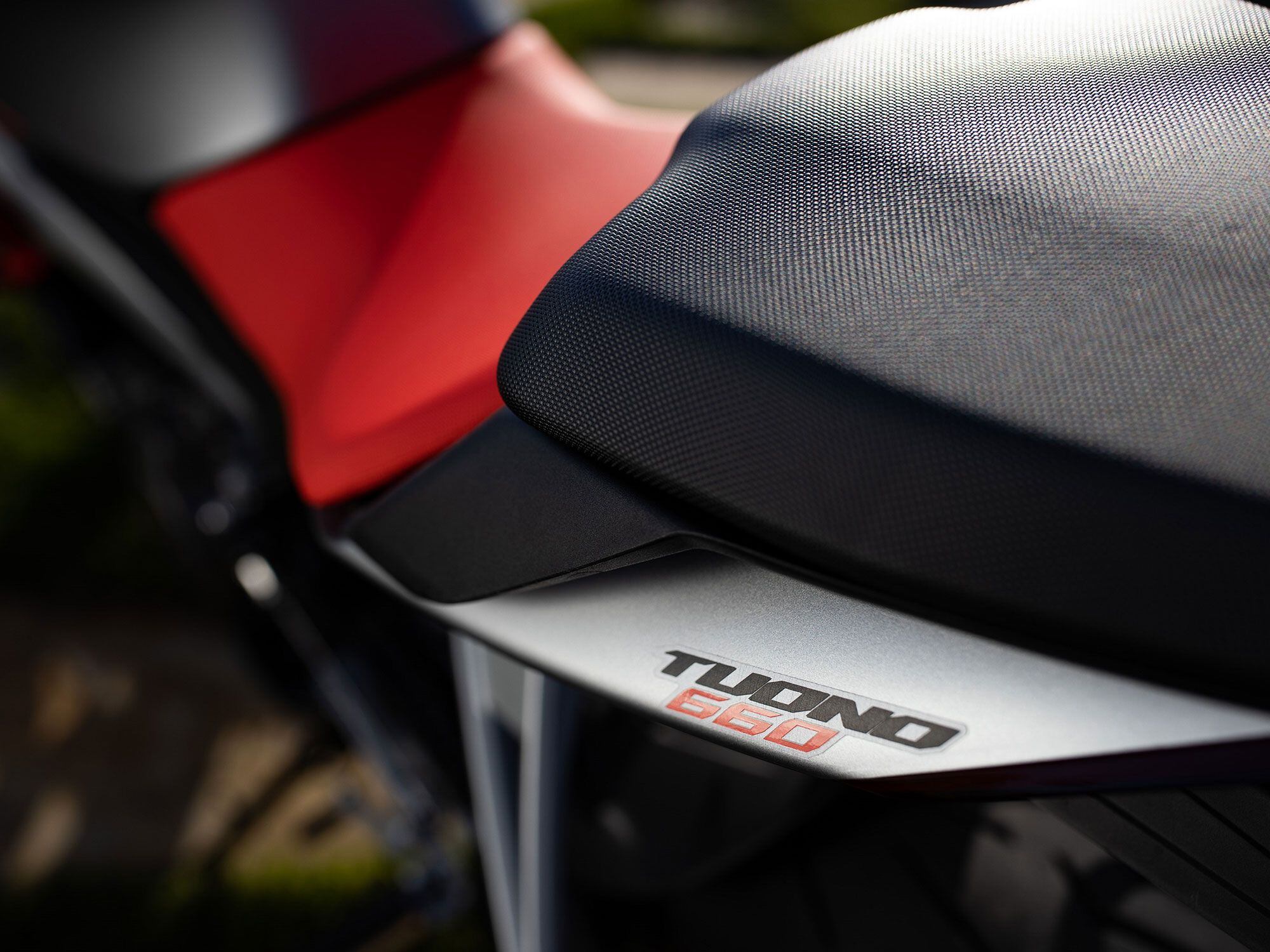
Nicely padded seat is all-day comfy with a narrow profile that allows even shorter riders to reach the ground. (Aprilia/)The 2021 Tuono 660 will be available in dealers in April in three colorways. For pre-booking, check out storeusa.aprilia.com/us_EN/, which also includes a $250 accessory credit.
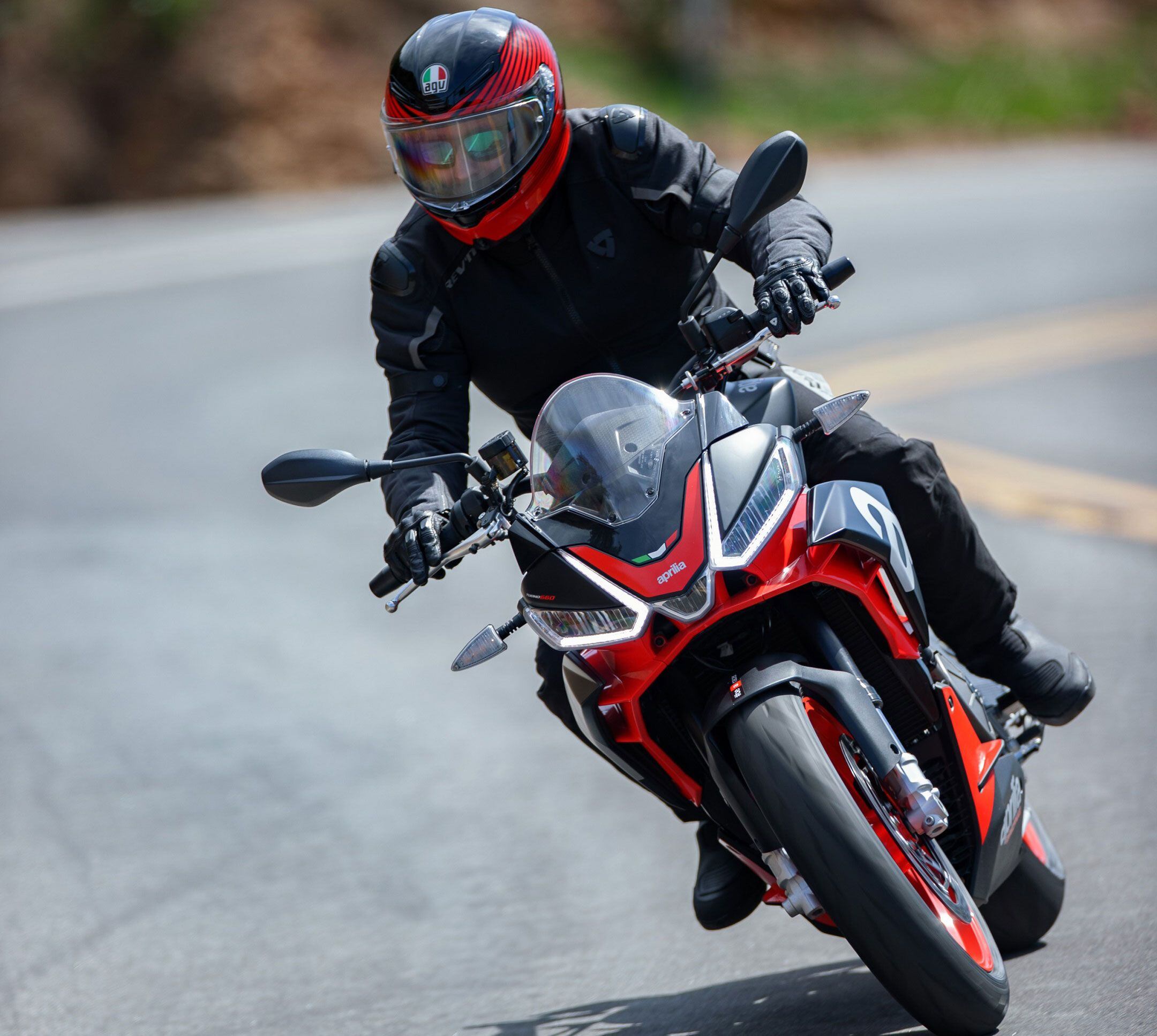
Well thought out and upright ergonomics mean the Tuono can accommodate a variety of body types. (Aprilia/)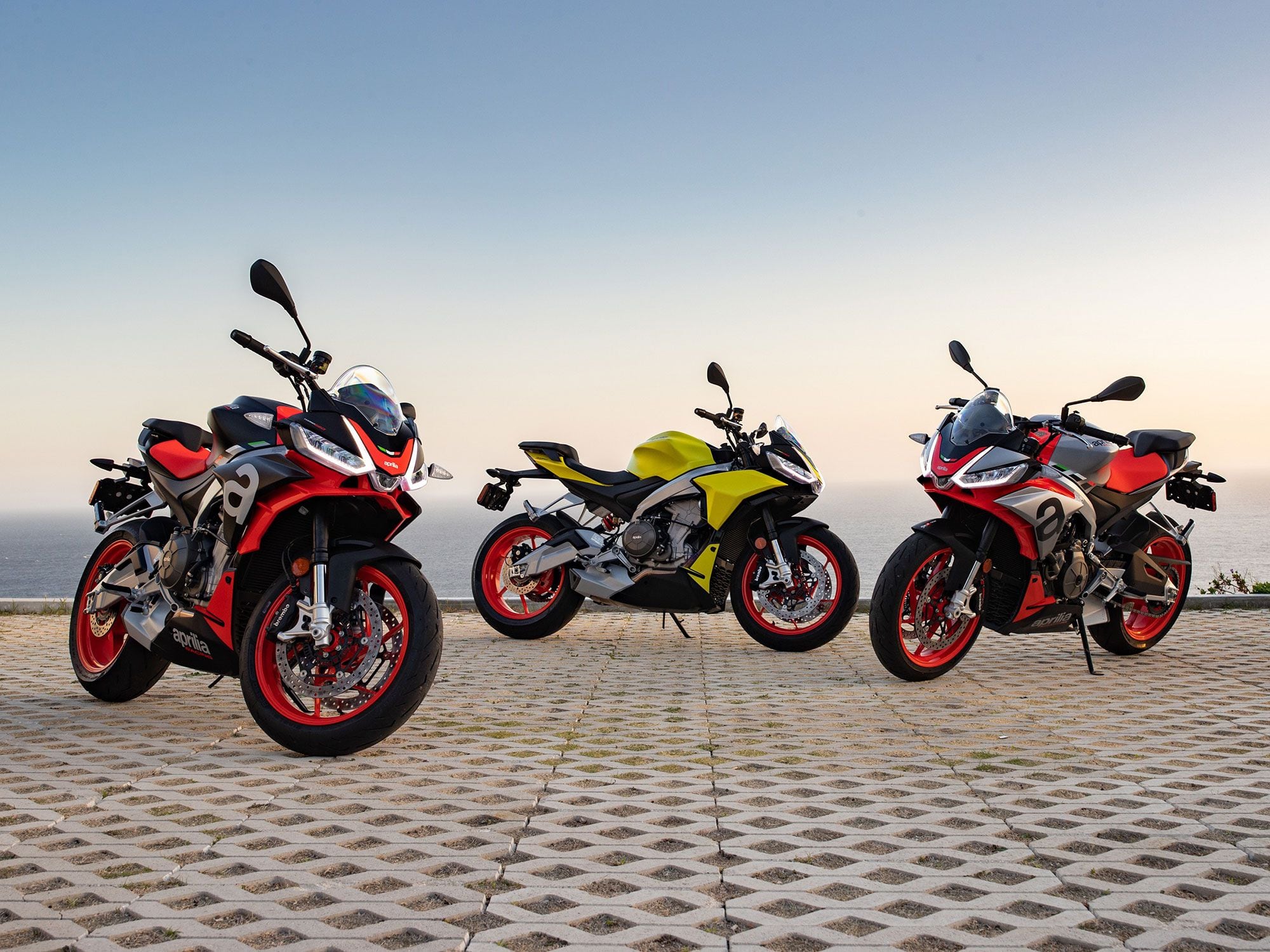
The Tuono 660 will be available in Concept Black (left), Iridium Gray (right), or for a $200 premium, the juicier Acid Gold (middle). (Aprilia/)
The trippy Acid Gold colorway will cost you an extra $200 over the base model. (Aprilia/)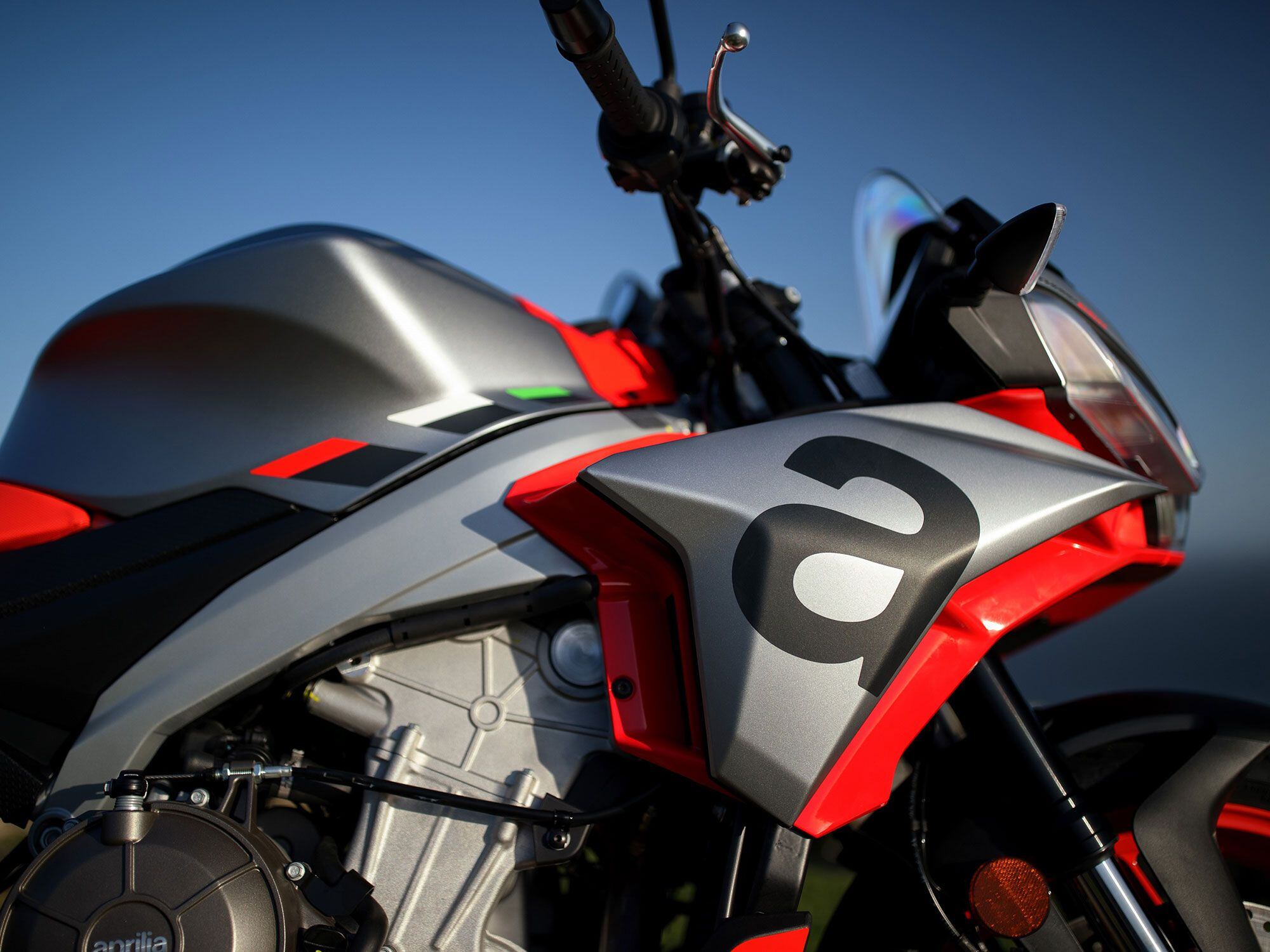
They call it a “naked,” but this bodywork suggests otherwise. Then again, it does push heat away from the rider as well as offering some aerodynamic benefits. (Aprilia/)2021 Aprilia Tuono 660 Specifications
MSRP: $10,499–$10,649 (Acid Gold) Engine: 659cc DOHC liquid-cooled parallel twin; 4 valves/cyl. Bore x Stroke: 81.0 x 63.9mm Transmission/Final Drive: 6-speed/chain Claimed Horsepower: 100 hp @ 10,500 rpm Claimed Torque: 49.5 lb.-ft. @ 6,000 rpm Fuel System: 2, 48mm throttle bodies, ride-by-wire Clutch: Wet, multiplate, with slipper system Front Suspension: 41mm USD fork; spring preload and rebound damping adjustable; 4.7 in. travel Rear Suspension: Single shock; spring preload and rebound damping adjustable; 5.1 in. travel Front Brake: 4-piston radial calipers, dual 320mm discs w/ ABS Rear Brake: 2-piston calipers, 220m disc w/ ABS Wheels, Front/Rear: Aluminum alloy, 17 x 3.5 in. / 17 x 5.5 in. Tires, Front/Rear: Tubeless radials; 120/70-17, 180/55-17 Rake/Trail: 24.1°/4.1 in. Wheelbase: 53.9 in. Seat Height: 32.2 in. Fuel Capacity: 3.9 gal. Claimed Wet Weight: 403 lb. Availability: April 2021 Contact: aprilia.com -
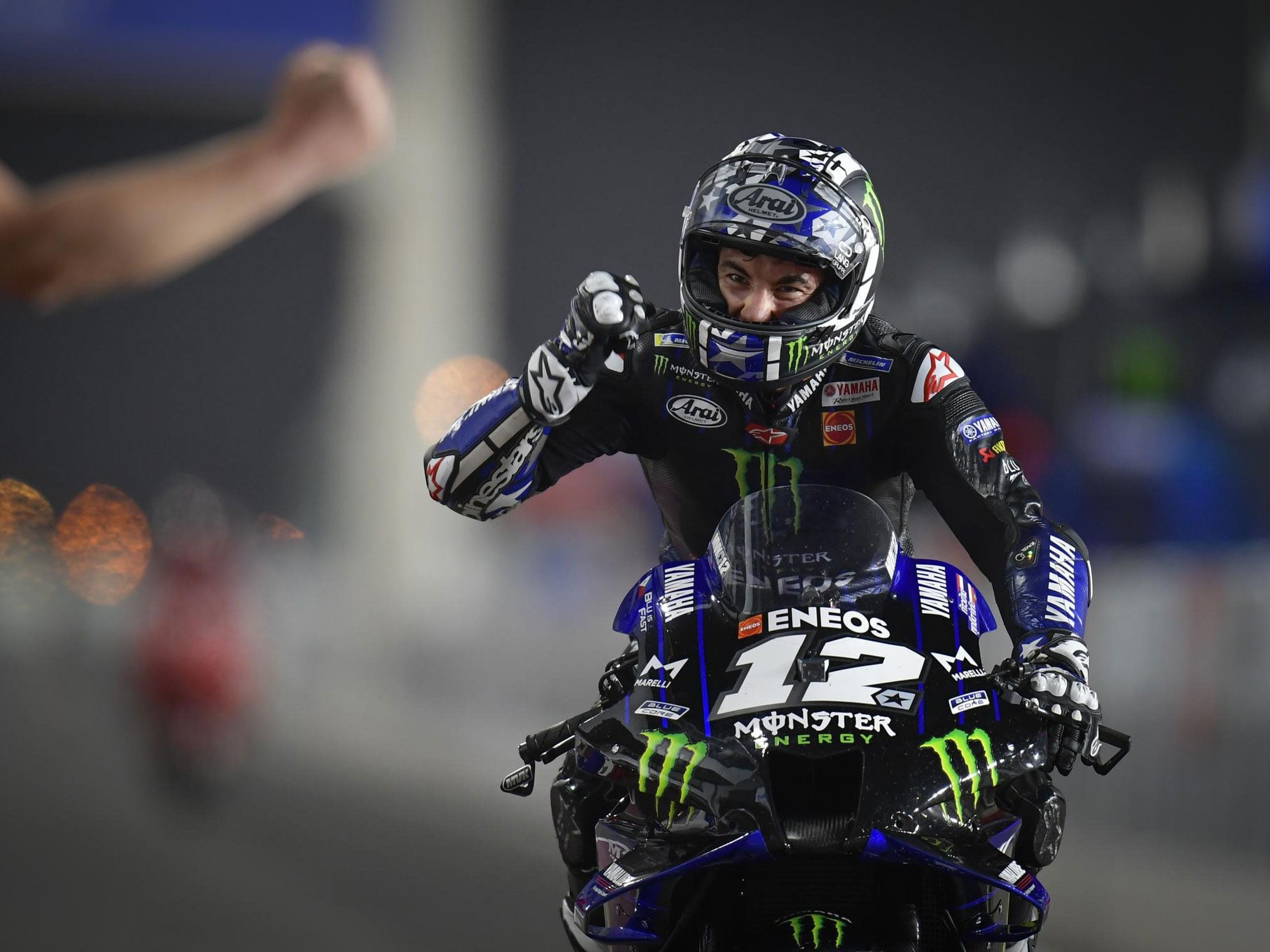
Maverick Viñales takes the first MotoGP of 2021. (MotoGP/)Maverick Viñales has won the first MotoGP event of 2021 on a Yamaha, in a well-planned and well-managed weekend. The Ducatis were impressively fast (Andrea Dovizioso won this event on Ducati in 2018 and 2019) and at the start, their front-and-rear-lowering holeshot device and great power put them 1-2-3-4 by turn 2. One of their riders—first-timer Jorge Martin on a Pramac Ducati—came from 14th starting position.
Viñales said, “Actually (my) start didn’t go so well—I had a lot of wheelies.
“After that I felt the potential, I was taking everything with calm and saving the tires for a good moment.
“Finally I opened a gap and I was trying to control the tire and manage the power.”
Yamaha, at the start of recent seasons, has shown promise only to return to its recent reputation for lacking tire grip in the last third of races. Yamaha team management had on Saturday expressed the view that the Ducatis, although very fast through practice, would be unable to use their power in the second half. So it turned out.
Francesco Bagnaia, pole-sitter on factory Ducati, led the race for 14 laps while the usual deck of tire surprises was dealt. He would finish third. He noted in practice, “Yamaha is very strong in sector two and three but we can close the gap in sector four with our top speed. The balance is very close.”
So it would turn out, with Viñales winning by just 1.092 second over Johann Zarco’s Pramac Ducati.
Jack Miller, Ducati factory star of practice and the favorite, was third for five laps before tire problems moved him back to finish ninth.
“We had a really good start and were able to push as I liked, not too hard in the beginning, but when Viñales came past (on lap
 I thought, ‘Now it’s time to start upping the pace,’” Miller said. “But then bang, I hit a wall and started losing the rear on the midcorner.”
I thought, ‘Now it’s time to start upping the pace,’” Miller said. “But then bang, I hit a wall and started losing the rear on the midcorner.”
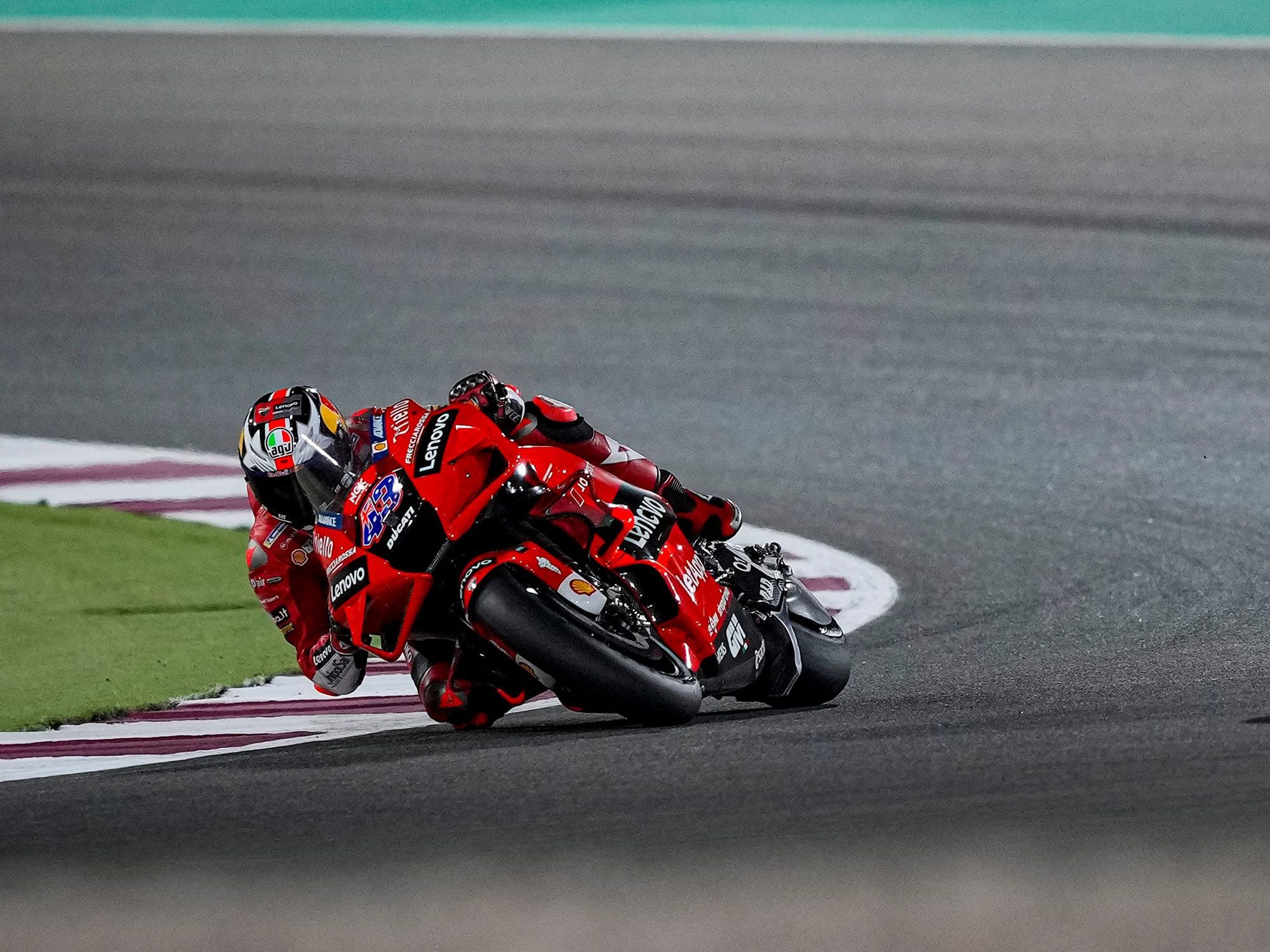
Jack Miller started strong, but rear tire issues saw him dropping positions after lap 5. (Ducati/)In the five days of preseason testing, Miller had been very upbeat about the 2021 Ducati. Asked to explain this, he said, “Just my confidence I feel in the front end… How I’m really able to let the brakes off and let the bike…roll and carry some decent corner speed.”
Corner speed—the very thing that former factory Ducati rider Dovizioso had been asking for over several years—midcorner grip.
Miller continued, “I haven’t really had that confidence in this thing ever, and especially through the faster corners, 12, 13, 14, 15, just letting the brakes off and really letting the bike hook in and turn. It feels fantastic.”
Riders have to be able to accept the highs like this, and also the terrible moments when they realize the tire is fading and nothing can be done about it.
Behind early leader Bagnaia were Zarco and Fabio Quartararo (factory Yamaha). Quartararo said, “I was feeling so strong in the beginning of the race.
“But then I noticed a big drop in the rear tire, which we didn’t expect because I didn’t have that during the test or the practice sessions.”
That would eventually drop him from third (from lap 6 to lap 10) to a fifth-place finish.
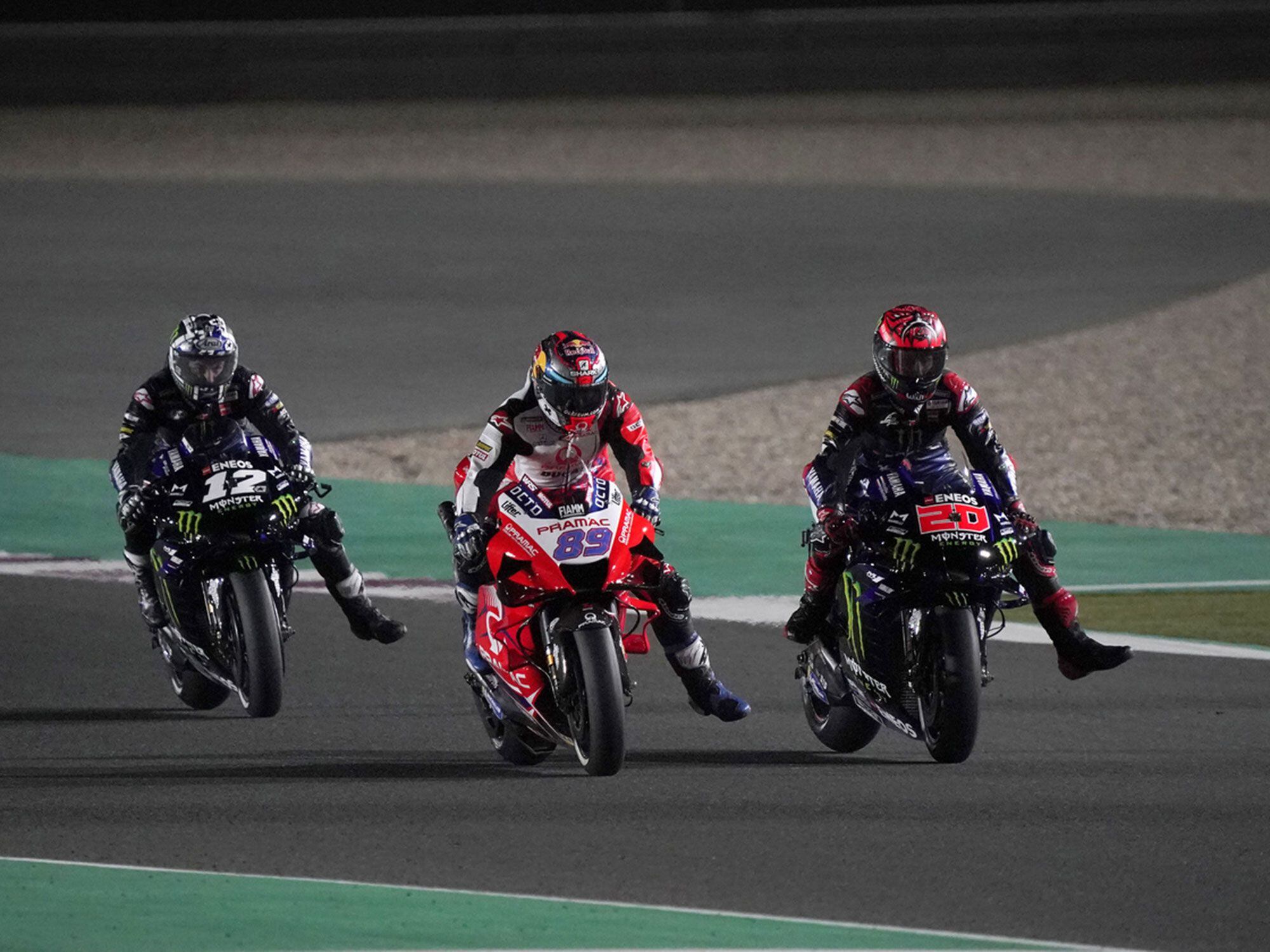
Fabio Quartararo finished fifth while also battling a loss of rear tire grip. (Monster Energy Yamaha/)Zarco said, “In the moment (when) Maverick could lead he had this strong advantage in second and third gear… So in second and third he was gaining on us.”
In other words, despite the power of the Ducatis, Viñales’ Yamaha had rear grip when they had not.
And what about 42-year-old Valentino Rossi, lately moved from Yamaha factory status to the Petronas satellite team? Through practice he was hardly noticed, but bang, he qualified fourth.
Franco Morbidelli said of this, “…he showed he can never be trusted and that he is always ready to surprise. I was practically always in front (of him) both in the tests and in free practice, but today, when it counted, he was faster.”
Rossi in the race would be relegated to 12th.: “After a few laps in the race,” he said (never higher than seventh, he slowed after lap 9), “I was struggling with the tires. Unfortunately this had already happened during the tests, with the rear. For some reason it seems like I stress it a lot, so it loses performance.
“Strange, because it was colder.”
The other Petronas Yamaha rider, Morbidelli had a mechanical failure that was attended to on the grid but immediately sent him to the rear once the race started:
“Basically the rear end of the bike starts to feel empty, like I have no damping in the shock.”
Speculation pointed to Yamaha’s version of the “holeshot” starting device, which lowers only the rear in order to raise the bike’s acceleration “wheelie limit” for the start. At present Ducati, Honda, Aprilia, and KTM have holeshot devices that lower both ends of the bike. Suzuki’s system lowers only the front.
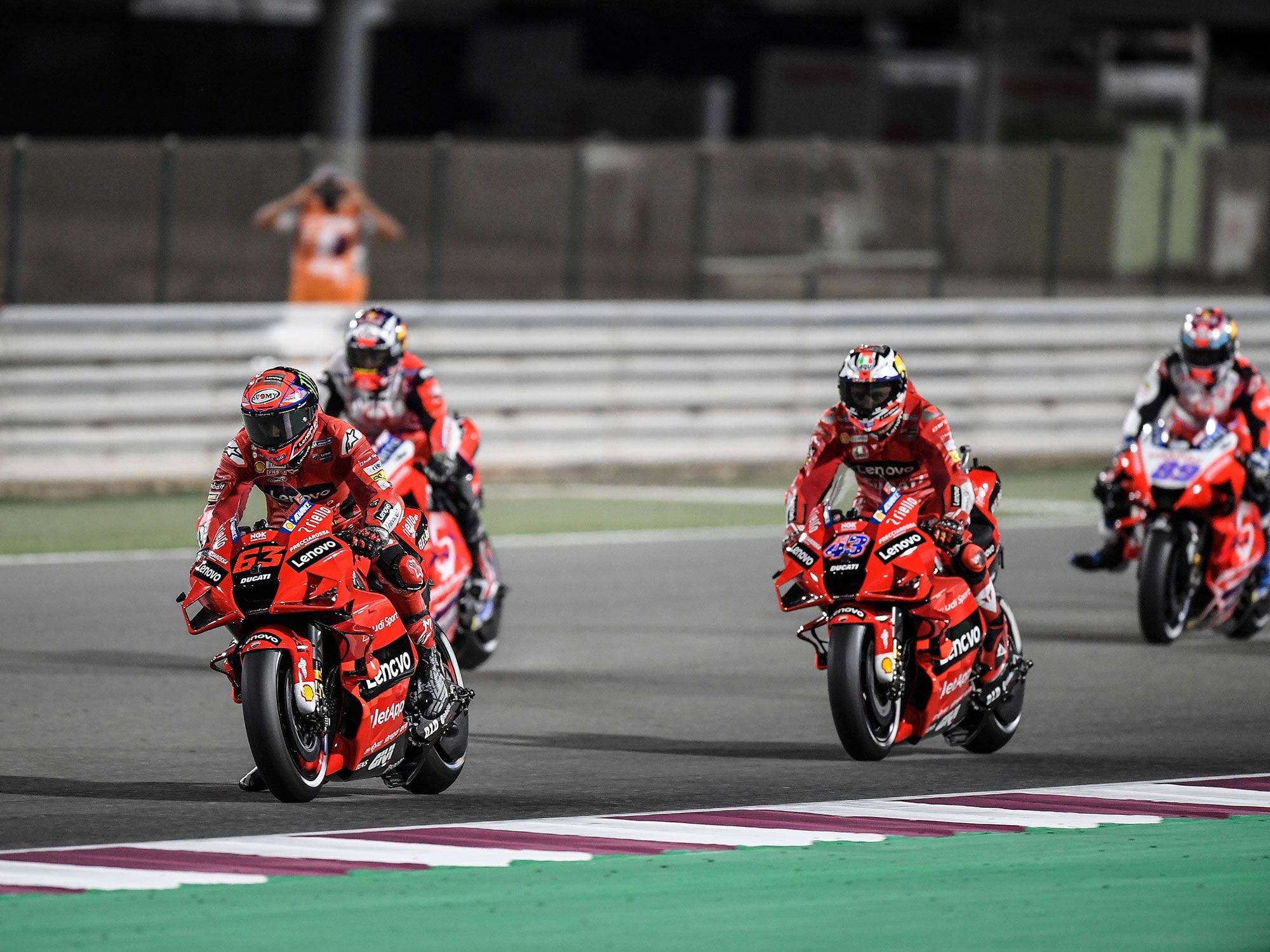
Ducati’s holeshot device was effective, putting four Ducatis at the front on the start. (Ducati/)What about Suzuki, which in the hands of Joan Mir last year displayed such consistency that he was able to become world champion, having won only one GP? The Suzukis raised no eyebrows through practice, but in the race Mir started 10th and had moved up to sixth by lap 6, then held station until lap 14 when he again advanced.
“I finally found the sensations of last season on the bike,” Mir said.
“I tried to manage the tires as best I could and then push in the final part.”
By lap 20 (of 22) he was third and looking like a podium finisher. Having passed Zarco for second, he then lost time in taking a wider line off the last turn, last lap.
“At the last corner I tried to widen to get more speed at the (beginning) of the straight, but it didn’t help much. I expected one Ducati in the sprint (to the line) but Bagnaia was there all the time.”
With no more need to conserve rubber, the Ducatis smoked Mir to the line and his tantalizing podium evaporated.
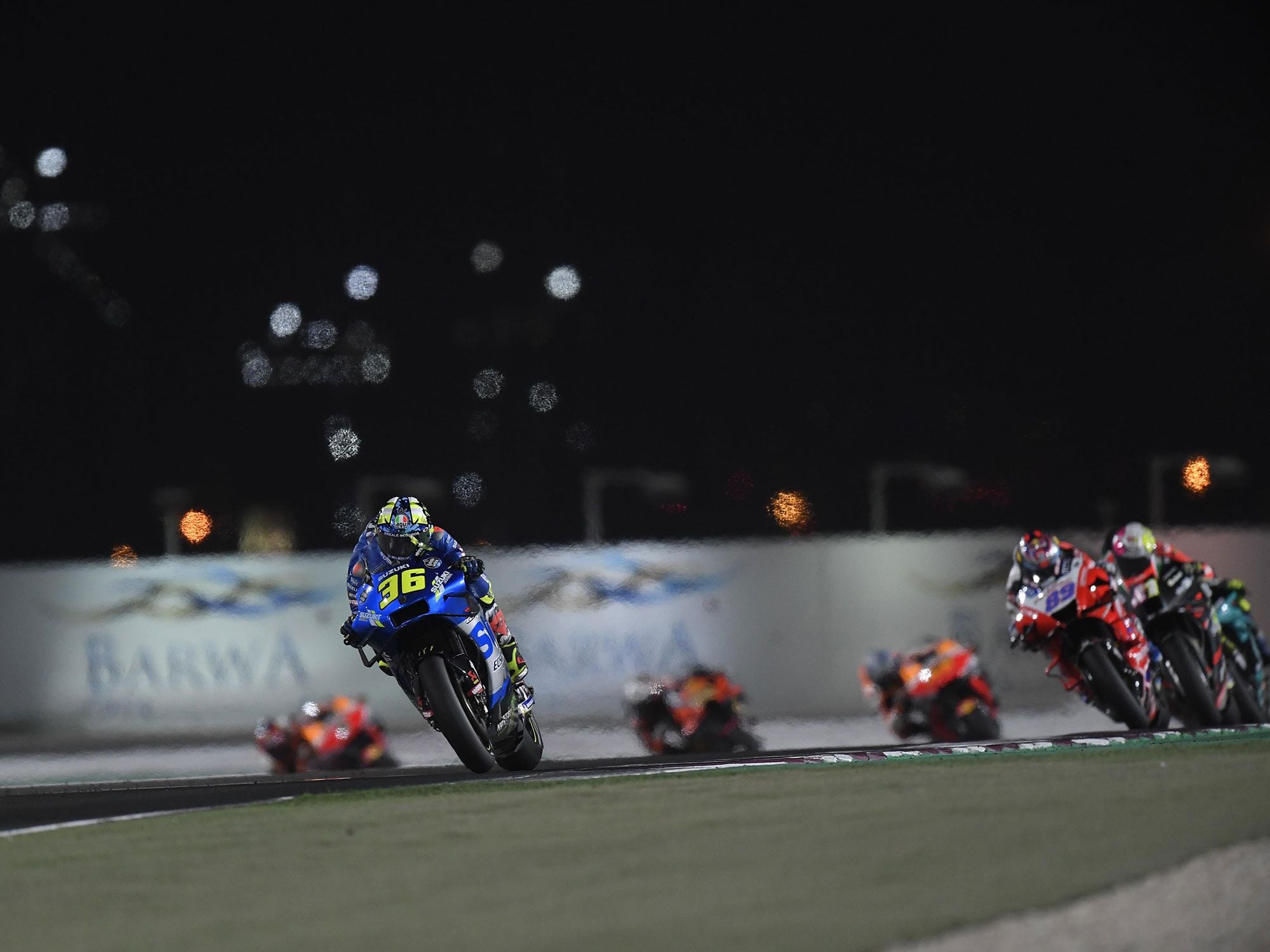
Joan Mir pushed from a tenth-place start and moved to second on the last lap, but the Ducatis of Johann Zarco and Pecco Bagnaia powered past on the front straight relegating Mir to a fourth. (Ecstar Suzuki/)Dear reader, I am sorry to have to show racing as the crapshoot it so often is, but with tires now looking a lot more like luck than like science, even the most experienced of riders rolls those rubber dice with little more chance of getting it right than a first-year novice.
On the other hand, it was Viñales who came the closest to figuring out the tires this time. In FP2 he ran four sessions, two with soft/medium and two with the eventual universal choice, soft/soft. The results said soft/soft. In FP3 he did eight consecutive laps on hard/hard, the best four being one minute 55 seconds—not so hot. Then in FP4 he ran ten laps, six of them in the minute-54s. Other riders were as fast but none as consistent. There isn’t time in practice for a thorough study of the tire problem, but some can get a glimmer—maybe enough knowledge to be useful
Fortunately everyone gets a second chance at the windswept and sandy Losail circuit in Qatar next Sunday.
And in case you didn’t know, Marc Márquez is sitting out these two Qatar GPs to be sure his arm is properly healed but is expected on the grid at Portugal’s Algarve International Circuit, weekend of April 18.
Just for fun, let’s consider just two novelties now available to the rubber compounder, whom I have always imagined as living atop a mountain and wearing a tall conical hat adorned with purple stars.
First is an instrument that now enables trackside measurement of tire tread rubber hysteresis. It basically vibrates a small hemispherical piston that is pressed against the tread, and software derives information from it, quantifying one of the basic mechanisms of rubber friction.
Second is a possible substitute for the classical sulfur cross-links between rubber chains that Charles Goodyear used to transform a sticky glop into a durable elastic solid. Goodyear’s method comes down to us as “vulcanization” or “curing” of rubber.
Not all of the elastic polymer chains that make up rubber consist of identical molecules, joined end to end. Some consist of blocks of different kinds of molecules, and are called “block copolymers.”
What if we add a small number of a kind of polymer that bonds strongly to itself? A short string of those in one rubber chain could line up with and stick to others of the same kind in an adjacent chain, cross-linking them in a manner similar to that of the usual sulfur bonds.
Let’s imagine further that this polymer that we add, in bonding selectively to its own kind, displays behavior very like a melting point. Get rubber made this way a little too hot and the chain-to-chain bonds weaken and separate.
What could we do with this material? We might not want to rely entirely on this form of cross-linking, but could supplement it with some traditional sulfur bonds. When this rubber reached a certain temperature, our trick copolymer blocks would let go of each other, causing the rubber to lose whatever of its properties depended on their form of cross-linking.
Could we, in this way, make tires that slow down the faster riders, making racing more “exciting” for spectators? I’m sure that a rubber compounding chemist could, if he or she were free to speak openly, entertain us endlessly with such possibilities.
-
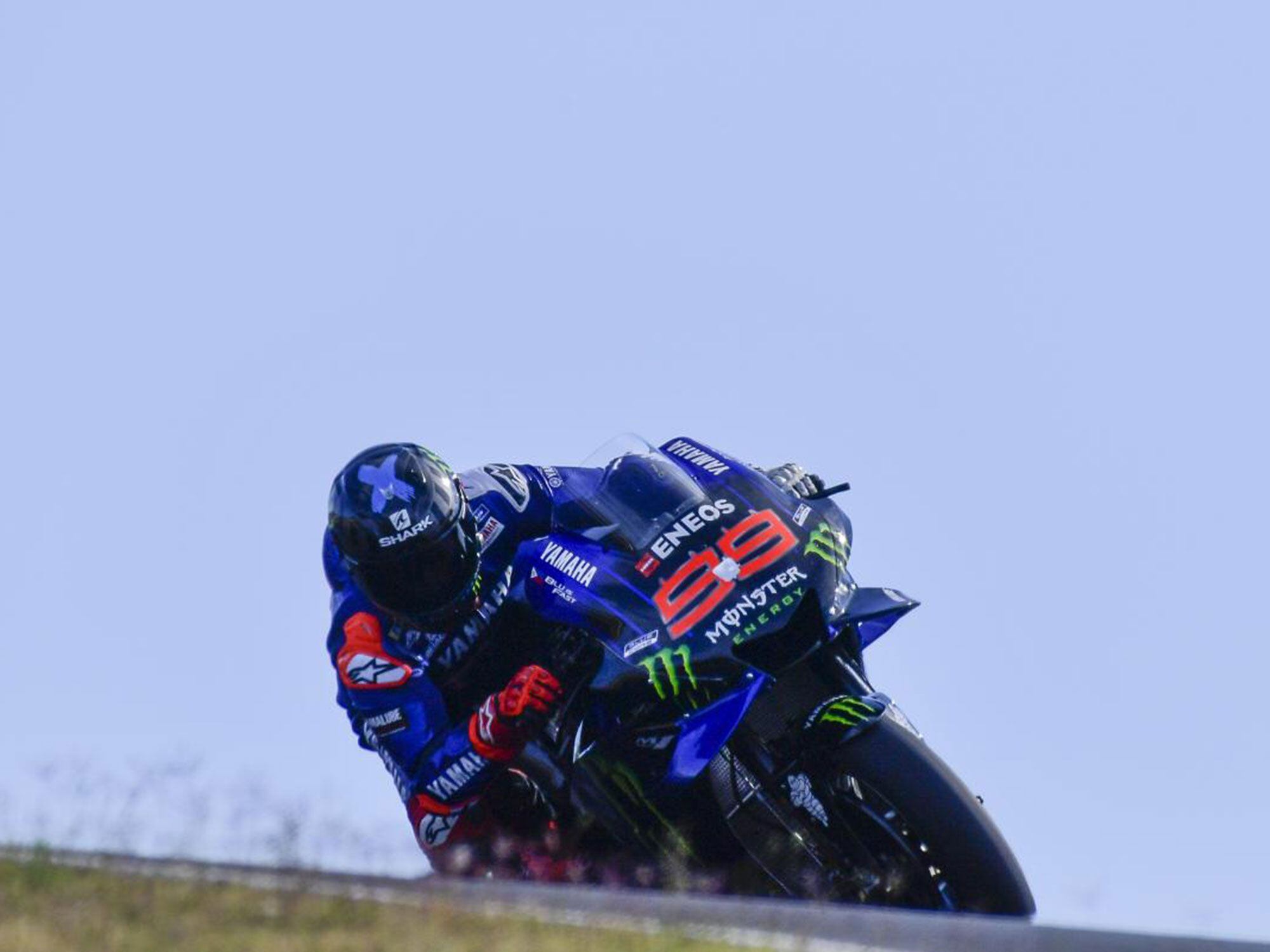
What makes a champion? Speed? Guts? Talent? Yes, all of that, but most importantly: consistency. (MotoGP/)Consistently placing a motorcycle at a desired spot at a precise speed is at the heart of rider safety. Do that on every street ride and you will arrive at destinations while your confidence and skills grow due to consistent rider health. Think “I’m having fun.” Place the bike consistently around the racetrack at track-record speeds and they call you champion. Some riders can run those speeds, some can run consistent laps, but doing both is the secret to glory, cash, titles, and health.
Meet Racers Like Jorge Lorenzo
While following Jorge Lorenzo at the front of the MotoGP field on his Yamaha at the 2016 Australian GP, the MotoGP.com producers posted his lap times, see pic below.
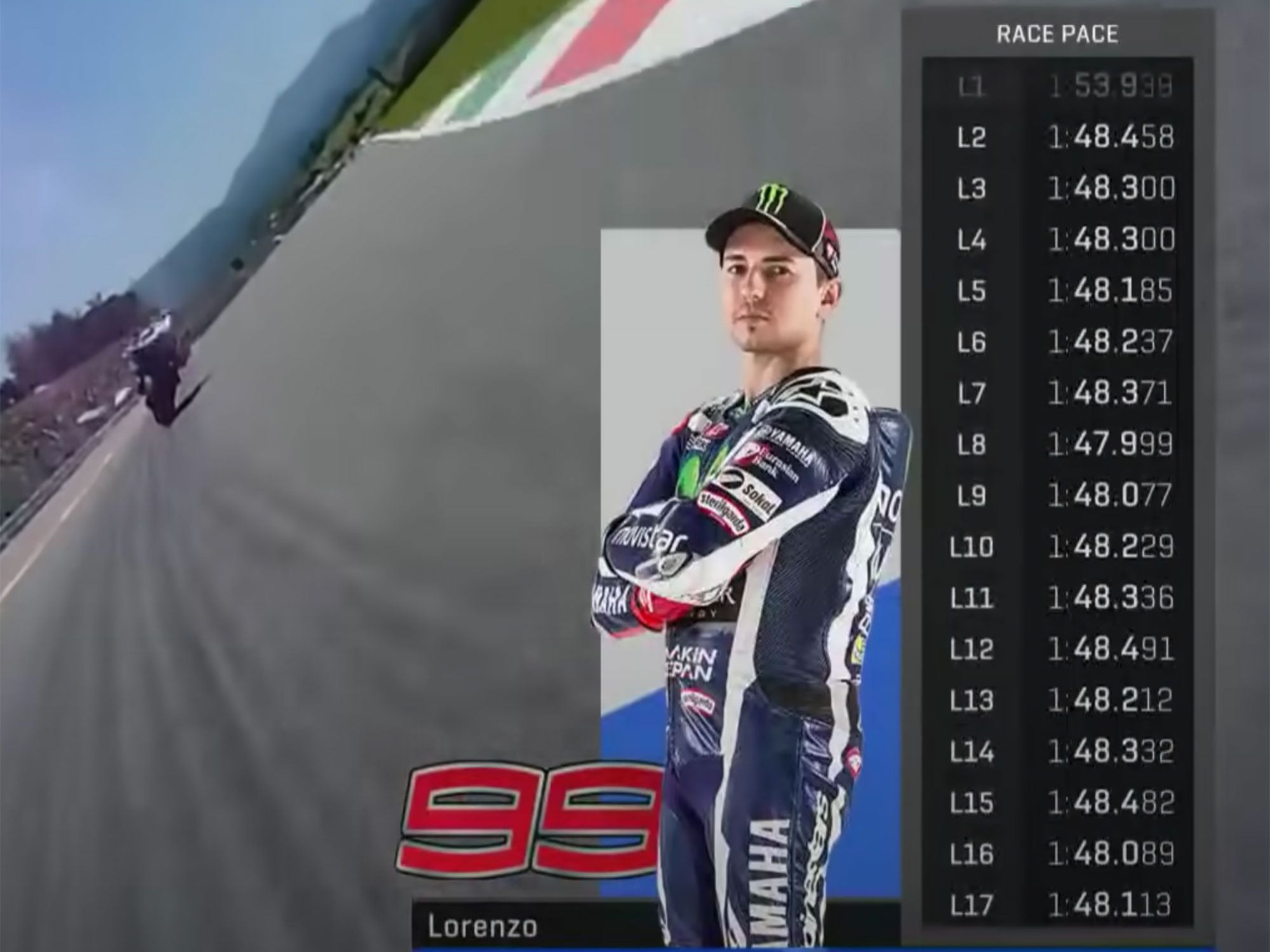
Consistency is the mark of a skilled rider and racer—look at the similarity of Jorge Lorenzo’s lap times. (MotoGP/)Note that I chose Lorenzo because that was the race I was watching; most championship-winning riders produce lap charts like the Spaniard’s, knocking out laps within tenths of a second of each other all race long. It’s a focus level beyond many people’s imagination, but also a specific process.
How?
How a racer like Lorenzo can run a 2.5-mile track lap after lap with only a few tenths of a second difference between laps is often explained several ways:
- He has memorized the track and knows exactly where to steer into the corner, where to apex, and where to exit.<br/>
- He has run enough laps to know exactly how his bike will feel and react every lap of the race.<br/>
- He has practiced the exact throttle settings, brake pressure, and steering quickness to place the bike perfectly throughout the race.
Those three explanations of consistency are wrong, yet widely believed. Many track riders feel that all they need is “more laps.” Students arrive at YCRS wanting exact points of braking and steering; they want to know when to do what and how much. “Give me the recipe, the silver bullet to speed.”
RELATED: Trail-Braking’s True Purpose
I understand these desires in a sport that is so challenging and risky, but in fact, the consistency of Lorenzo and his ilk has little to do with braking makers or turn-in points or exact throttle percentages at exact places, and all to do with consistent bike direction.
Consistent Direction
The beautiful thing about a champion’s consistency is that we can replicate it on our own rides, at our own speeds. But first, let’s agree on a few things:
- A champion circulates the track as fast as he consistently can.<br/>
- Crashing out of practice, qualifying, or a race is a major fail.<br/>
- The champion’s bike changes lap to lap: losing weight as it burns fuel and losing grip as tires degrade.<br/>
- Each corner on the track challenges the champion to run that corner at the maximum speed their lean angle and track width allow.<br/>
- Corners are usually slower than the adjoining straights.
Are we good with those five points? Nothing earth-shattering, but they lead to why Lorenzo and company knock out consistently fast times all race long: They consistently get their bikes slowed to the maximum speed the corner will allow, at their chosen lean angle.
That, riders, is the secret to consistency: Get your bike to the corner’s slowest point, corner after corner, at a lean angle you are comfortable with. That is the secret to lifelong healthy riding, and if your bike and tires are near their performance limits, but not over those limits, you win a bunch of stuff on the track.
RELATED: Simple And Frequent Trail-Braking Practice
Traverse the corner well below your bike and tire limits and you stay safe. Traverse the corner shockingly above your bike and tire limits and you crash—again remembering that lean angle is factored in as a relatively steady number: what you’re comfortable with or what your bike will allow.
Again: How?
Here is another lap chart from a Lorenzo race:

Over 14 laps at Mugello in 2017, Lorenzo’s race pace varied by only 0.3 second. (MotoGP /)It isn’t that Lorenzo does exact things at precise moments on the track. It isn’t that his bike is predictably perfect all race. What brings this title-winning consistency is that Lorenzo gets his bike to the speed each corner allows (at his lean angle) corner after corner, lap after lap.
And riders, consistently getting your bike to exact cornering speeds is impossible without trail-braking, or trailing brake pressure into the corners. Lorenzo and gang use their brakes to the slowest point of the corner. They don’t close the throttle and hope deceleration gets them slowed to this exact mph at his exact location, they close the throttle and use the adjustable slowing component, the brakes.
Engine-braking is an inefficient way to slow your motorcycle when compared with engine-braking plus braking. Our bikes decelerate at different rates when at different rpm. They decelerate at different rates uphill versus downhill. More weight onboard means longer deceleration distances. We can’t rely on a slowing device that is un-adjustable and hard to replicate.
If we believe in releasing the brakes at the turn-in (straight-line braking only), we have given up our best speed control well before the slowest part of the corner, and this gets especially tough in blind corners that tighten or have debris to avoid. If Lorenzo tried this, he would be just another unknown racer who crashed themselves out of the sport or slowed down enough to lose the joy of track riding. “Crashes” and “this isn’t much fun” are at the heart of the ex-rider.
No Trail-braking Equals Less Comfort and Consistency
This enormously important statement must be read carefully. It doesn’t say we can’t ride along twisty roads using deceleration or straight-line braking only, but by not braking or by releasing the brakes early, we are “hoping” our speed will be correct for the slowest part of the corner.
When meandering easily along a backroad we are well under the limits of our bike and tires and have plenty of lean angle available to make the corner. The problems come when a surprisingly tight corner presents itself and we are suddenly 25 mph too fast, or when we are enjoying the “motor” in our motorcycle and accelerate a bit too much prior to the corner. Then we add our names to the statistics of “running wide in a corner” because we aren’t doing what Lorenzo does.
Lorenzo learned early that “hope” is a poor racing strategy. He knew that his corner entries would be affected by a wide variety of factors, such as bike placement, fuel load, other riders, going to the brakes too late or too early. What Lorenzo used to cover those variables and mistakes was his ability to modulate trail-braking pressure to arrive at the slowest part of the corner, the direction change, at the precise speed his mind, bike, and tires would allow.
We can ride with Lorenzo-like consistency at our own speeds when we adopt Lorenzo-like trail-braking habits.
More next week!
-
Hello Kyle2495,
Welcome to The Motorbike Forum. Please feel free to browse around and get to know the others. If you have any questions please don't hesitate to ask.
Why not tell us a bit about yourself too.
-
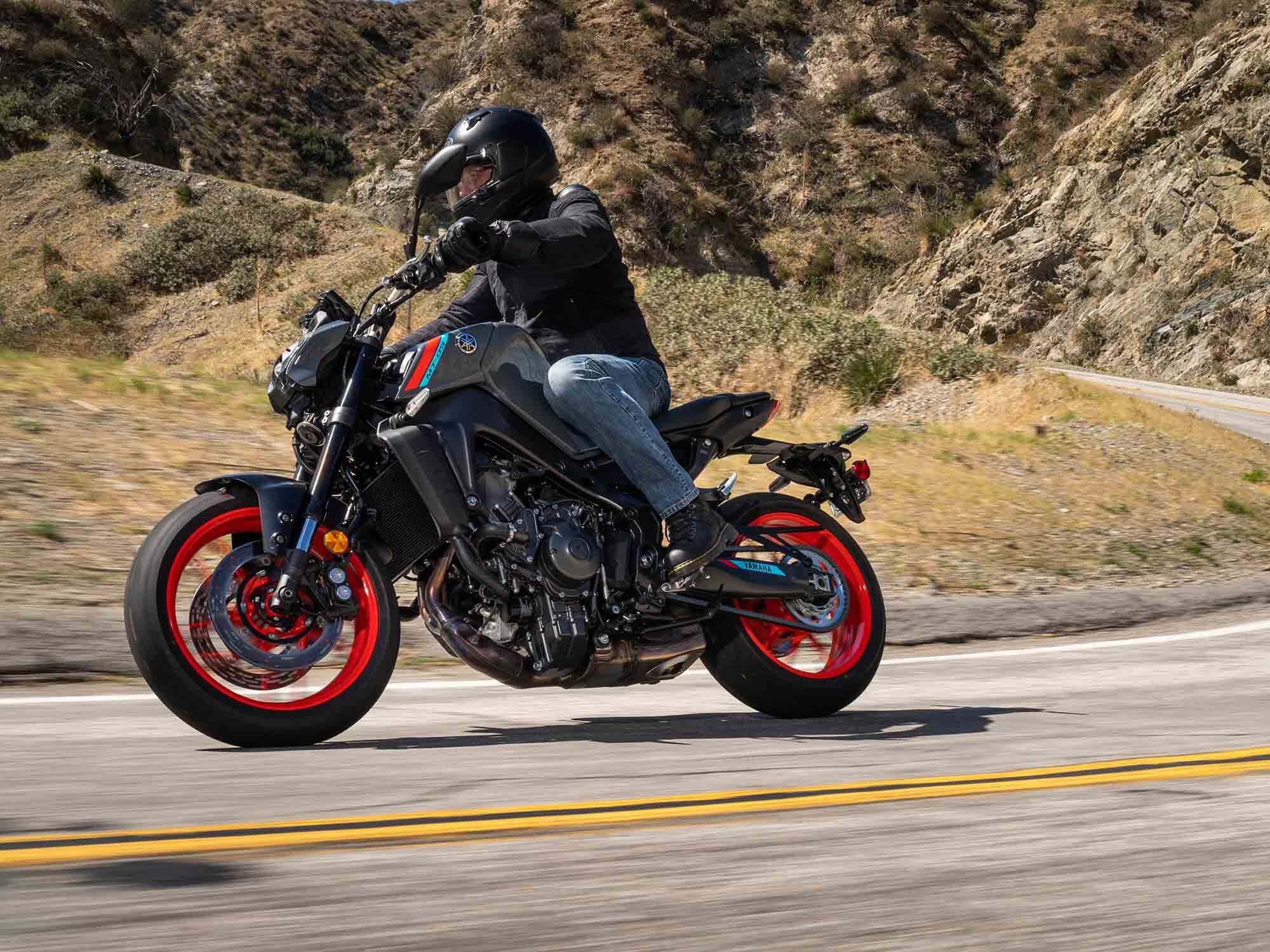
Yamaha has refined its MT-09 for 2021. (Yamaha/)When you have a good thing going, you don’t change it unnecessarily. Yamaha Motor Corporation, USA has sold 24,000 MT-09s between its introduction in 2014 as the FJ-09 and the end of 2020. In the modern motorcycle world, where some iconic models move under 1,000 units a year in the US market, that makes the 09 a mammoth hit. Sure enough, it’s one of Yamaha’s more popular models, selling well and continually. Yamaha USA Product Planner Aaron Bast attributes the MT-09′s previous success to its three strengths: torque, agility, and value. Especially value; the original 2014 model sold for $7,990, an amazing price then; six years later, it has only climbed to $8,990. Bast also says the whole point of the new version is to offer more: more torque, more agility, more value.
So the 2021 MT-09 is much more than an update, even if it’s just slightly less than an absolutely complete redesign. Its three-cylinder engine is obviously based on the original 847cc powerplant, but has more new parts than old. Yamaha, as all other manufacturers, has to meet stringent Euro 5 emission rules with the new bike, even though they want to increase performance. Lower emissions have traditionally meant less power, so the engineers gave the bike a new crankshaft with a 3mm-longer stroke, taking the displacement up to 890cc. Additionally, the new crank has 15 percent more inertia, slowing engine response slightly while increasing the engine’s perceived smoothness. To keep deck height the same even with the longer stroke, the connecting rods are 1.5mm shorter. New forged pistons with concave tops maintain the 11.5:1 compression ratio of the outgoing 847cc engine.
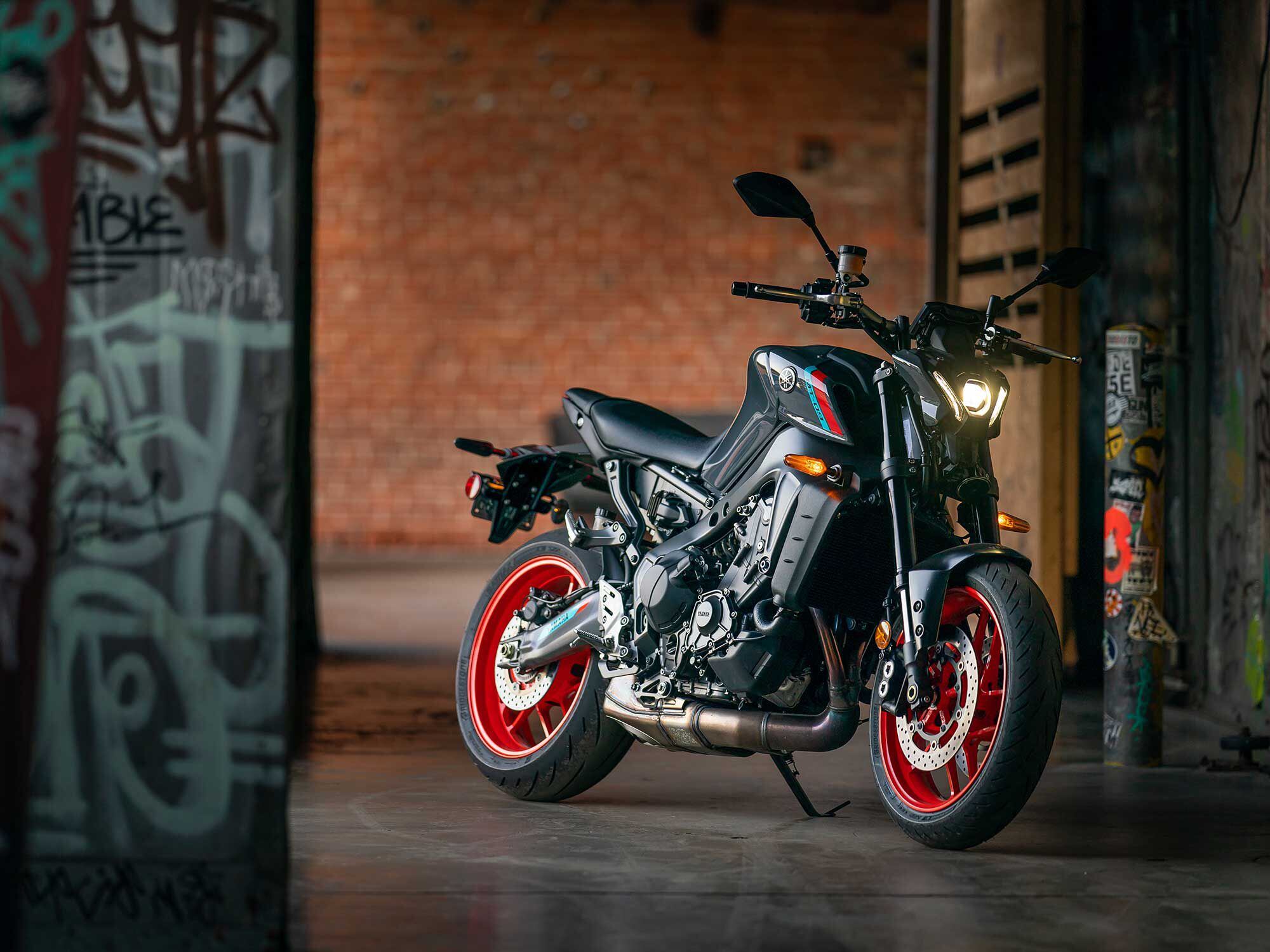
Yamaha has sold 24,000 units of it’s CP3-powered naked since its US introduction in 2014. (Yamaha/)A new cylinder head was created for both emissions and performance. It was given 12 percent less coolant volume for faster engine warm-up; most hydrocarbon emissions are created while an engine is still warming, while the fuel mixture must be rich and the exhaust catalyst isn’t yet up to temperature. For better performance, the new cooling passages completely encircle each exhaust valve seat, eliminating the potential hot spot between the valves. Intake ports were redesigned with reduced volume for faster flow, and the injectors were repositioned and re-aimed to hit the backs of the intake valve. All these changes lead to better fuel vaporization and mixing, improving both emissions and drivability. New camshafts have reduced timing, with 30 percent less overlap; there is now only a 20-degree period during which both intake and exhaust valves are open simultaneously. Shorter timing and less overlap generally favor emissions and torque over top-end performance, but the engineers gave the cams notably steeper ramps, so the curtain area under the whole lift curve stays relatively high. The new ramps are so steep that the entire cam drive had to be redesigned with a wider and stronger cam chain and an oil-pressure-powered cam-chain tensioner added. The tensioner provides more tension when the engine is spinning fast, when the cam chain is more likely to whip around, and less drag at lower rpm.
The intake and exhaust systems also were retuned and redesigned. Three unequal-length runners poke up into the airbox, a design that delivers more torque, a smoother powerband, and a delightful intake note. The exhaust system is pieced together from stainless steel stampings with beautiful robotic welds that look as good as those on some high-end race pipes. It’s an all-new design that places the catalyst forward in the conical header portion of the pipe for quicker warming (emissions again) and tucks almost all the muffler under the engine for better mass centralization. The increased displacement and new engine tuning is claimed to increase torque by 6 percent while further broadening the band. Fuel economy is said to be 11 percent better than with the previous model.

Displacement on the MT-09 has been bumped up to 890cc with a claimed 6 percent increase in torque and an 11 percent increase in fuel economy. (Yamaha/)Other details were seen to as well. A double-acting, ramp-style slipper clutch, similar to the one in the YZF-R1, releases on back torque and tightens on acceleration, allowing substantially lighter springs and reduced clutch effort. First and second gear ratios were raised by about 3 percent, because of the increased torque and crank inertia. The engine and exhaust system in combination is 3.8 pounds lighter than that of the 2020 model.
While the engine can be considered an update, the ’21 MT’s frame is all new. It follows the brilliant pattern of the previous bike with a construction nearly unique in motorcycling. There are no welds in the MT-09 frame. It comprises two frame halves made from a super-high-vacuum, high-pressure die-casting process that produces higher-strength parts than typical HP die-casting. (Ducati has used the same process for Panigale V-twin crankcases.) The parts come from the dies fully formed, needing only a facing operation before they can be bolted together permanently with tamper-proof fasteners. Then the steering-head bores are machined for bearings, and the frame is done. The three-cylinder motor, when it’s bolted in, reinforces the structure. Beautiful and inexpensive, the frame has always been one of the reasons that Yamaha can offer the MT-09 at an attractive price. This year the construction remains the same, but all the details have changed. The steering-head tube is lowered by 30mm, reducing bending leverage from the fork and allowing a straighter side beam layout. Yamaha claims the lateral stiffness is improved by 50 percent.
The swingarm used to be constructed similarly, in two halves, but the new one is a welded box-section design that’s 0.6 pound lighter. But the two-piece bolt-together die-cast aluminum construction now makes its way to the subframe, replacing what was previously a welded steel part and achieving a 3.3-pound weight reduction. Wheels are also lighter, with the rim section of the cast wheels spin-formed with heat and rollers after casting to improve material strength, allowing a thinner section there. The wheels have 11 percent less rotary inertia, a change that lightens steering and improves acceleration.
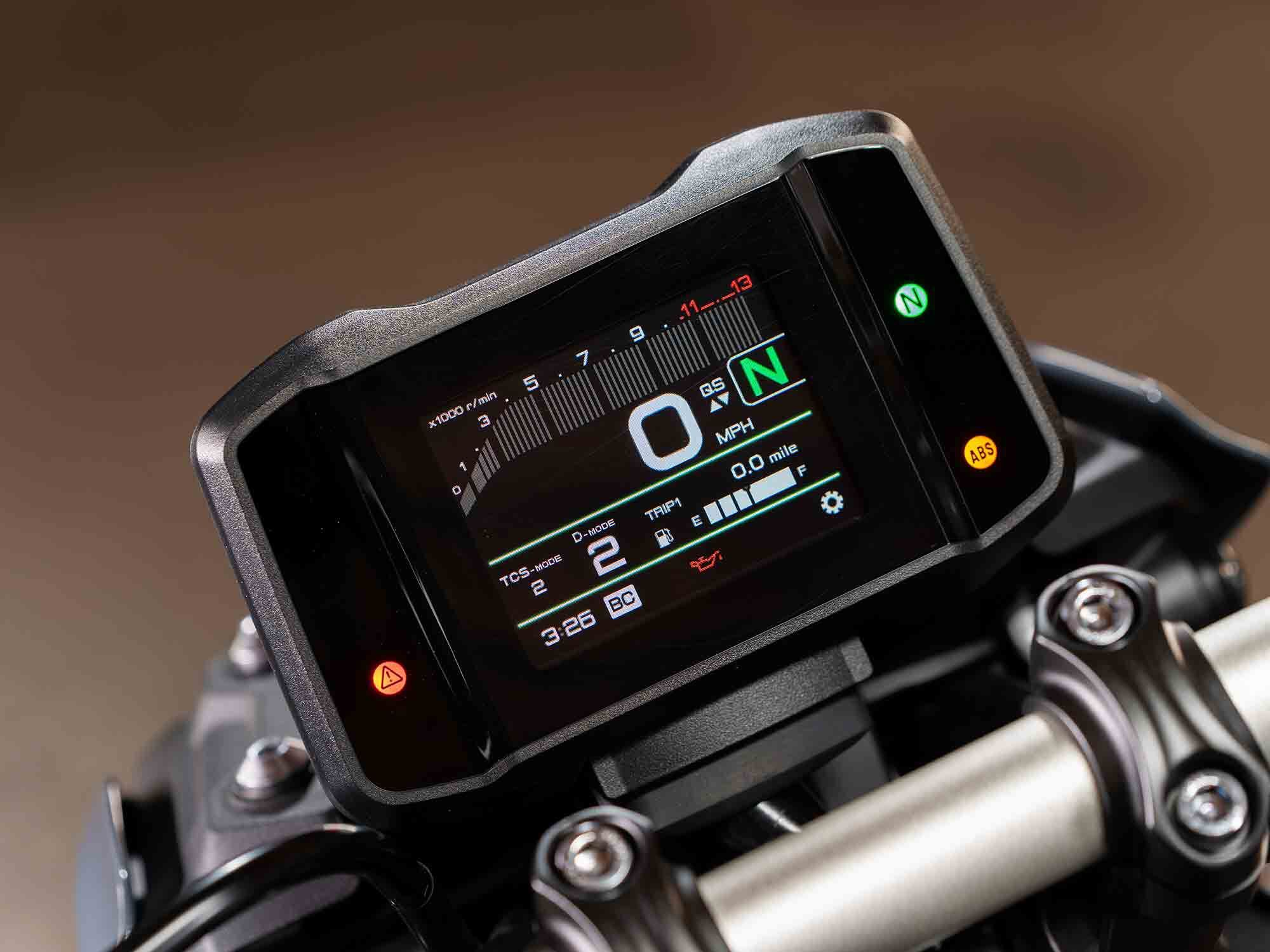
The new suite of electronic rider aids and rider modes is controlled via a handlebar switch and the full-color TFT dash. (Yamaha/)Along with chassis and engine changes, the new 09 gains an impressive array of new electronic riding aids that Yamaha says were directly derived from those of the R1 superbike. A new six-axis IMU (Inertial Measurement Unit) tracks exactly what the bike is doing in 3-D space, allowing very sophisticated traction control, lift control (anti-wheelie), and slide control systems to be implemented by the 09′s ECU. This is helped by a new electronic ride-by-wire throttle system that allows the control system to work at multiple levels: spark, fuel, and throttle, depending on the exact need. A new full-color TFT display and dedicated handlebar buttons allow the rider to select from four different throttle maps and three different levels of each of the other control systems, with the additional option of disabling any one or all of them altogether. The IMU also feeds data to the ABS system, allowing it to be mapped to respond appropriately to rider lean. Before starting a ride, you can select either this mapping or a conventional ABS map that ignores the IMU; but unlike the other rider aids, you can’t switch the ABS off. Yamaha also included a quick-shifting system with a shift sensor that allows clutchless up- or downshifts, and allows the rider to turn the system off if desired.
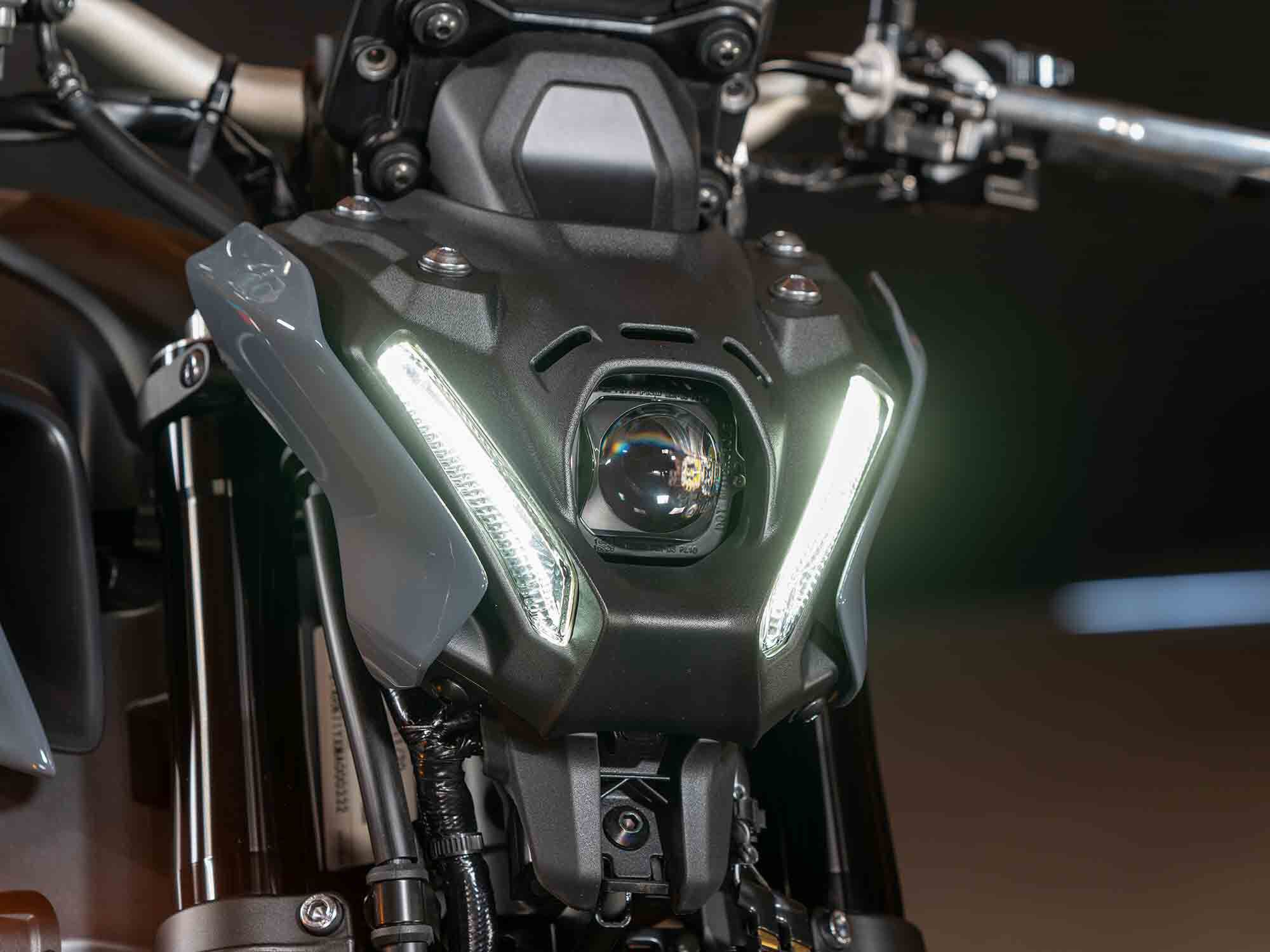
The MT-09′s headlight is a bold design to say the least, but the LED and dual-lens-in-series headlight is effective. (Yamaha/)Probably the most controversial feature of the new bike is the new and extremely compact dual-beam LED headlight, which allows everything carried on the fork to be pulled back closer to the bike. Whether you like the looks or not, you’ll likely appreciate the bright and well-defined light pattern provided by multiple LEDs and a dual-lens-in-series projector design.
Yamaha introduced us to the 2021 MT with a ride covering about 140 miles of urban roads, freeway, and mountainous rural twisties. First impressions upon sitting on the new machine are that it’s still an MT-09, all right, a sporty street machine that requires only moderate forward lean and pegs planted right under you. And it’s light; Yamaha claims a 417-pound wet-ready-to-ride-full-tank weight, which would place it at 394 pounds empty. Shifting it side to side, you can believe that.
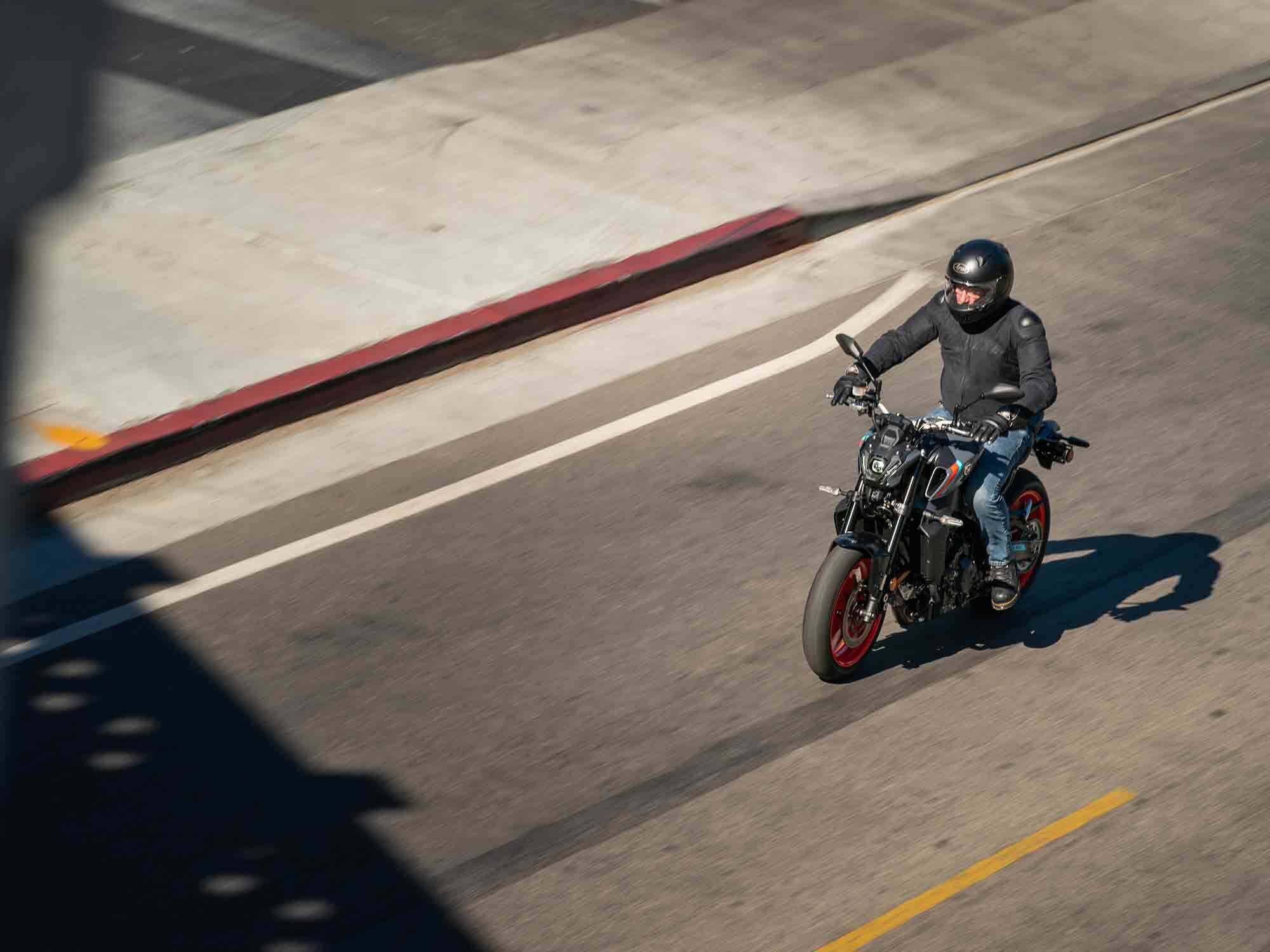
Just a slight lean forward to the bars and pegs right beneath you give the MT-09 a sporty feel. (Yamaha/)The three-cylinder whirrs to life with a button push, and with a notably light pull on the clutch and a snick of the gearbox, you’re off. The engine is still the three-cylinder torque monster it always was, with a powerband as wide and flat as an ocean horizon. But it’s notably more refined, with a precision to the fueling and throttle response that was never quite there on its predecessor. Throttle maps 1 and 2 are almost identical, with 2 just very slightly calmer, perhaps easier for everyday riding. Maps 3 and 4 are for the valet or rain, and won’t be used much. Snap the throttle open in first gear and in the middle of the rev range, and the front end starts to come up quickly, but the lift-control system smoothly drops it back after it elevates a few inches. Try an aggressive standing start from a stop, and it’s easy to skim the front wheel for all of first gear to beyond 50 mph. With the relatively low gearing, the light weight, and the torque, the MT-09 remains a wheelie monster, only now tamed by the lift control instead of the perhaps less perfect discipline of your right hand.
Handling, too, feels more refined and solid than ever. This is a machine that can run with pure sportbikes on a mountain road, turning well and easily but with a more planted and solid feel than ever. Suspension in this standard version is a balance between comfort and sportiness, leaning slightly toward the former. The ride is smooth, and the bike stays controlled even when hitting midcorner bumps. An SP version will be available later this year with a more advanced KYB fork and Öhlins rear damper if you’re looking for something sportier.
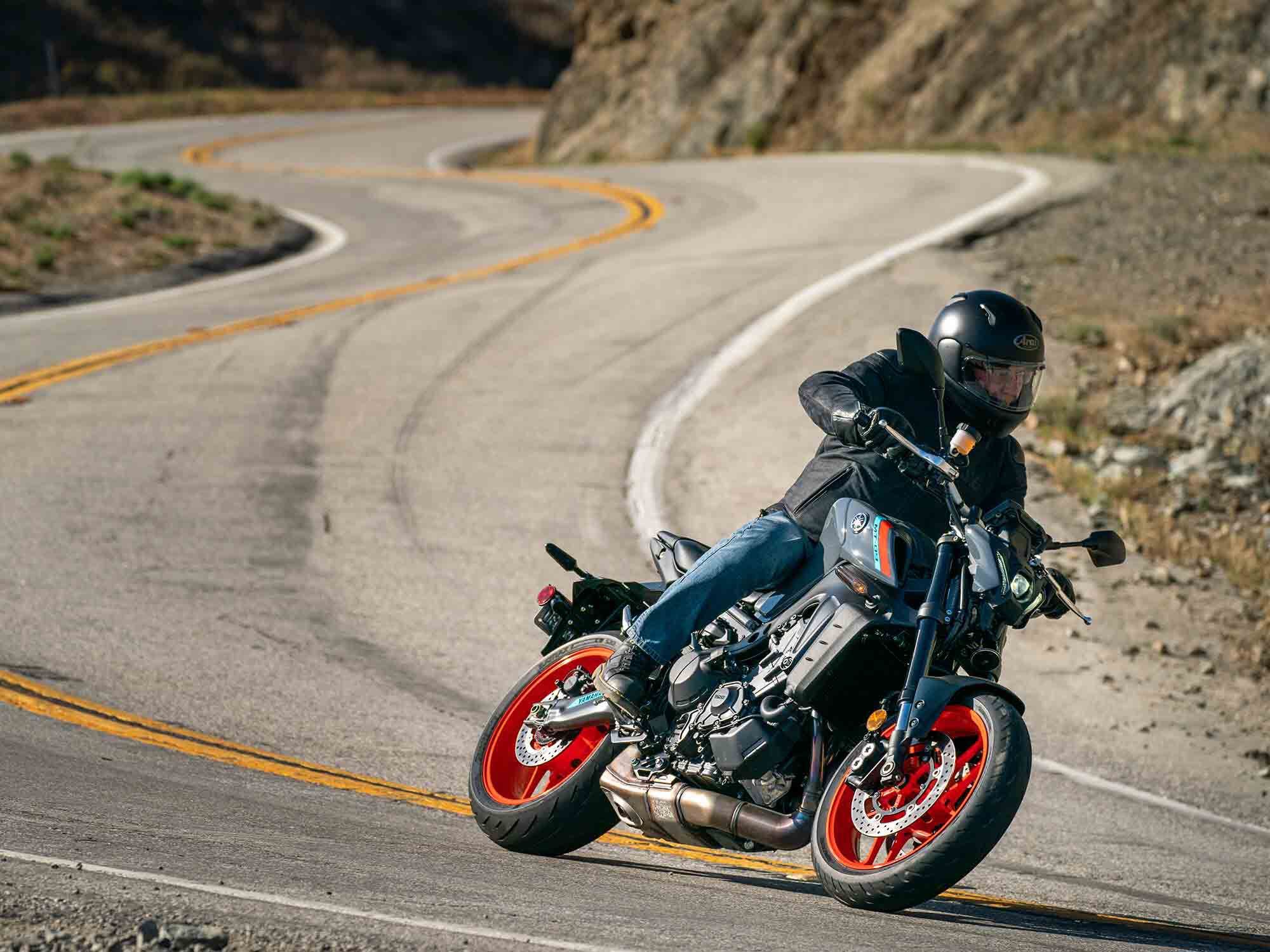
Midcorner bumps don’t upset the MT-09′s well-balanced suspension and chassis. (Yamaha/)Brakes are smooth and powerful, though only a brave rider will test the cornering ABS. In a straight line, even a hammering grab of the front brake lever stops the bike quickly without drama or rear wheel lifting.
But perhaps the thing you notice most while riding the MT-09 is the pure visceral sensation delivered by one of motorcycling’s great engines. It’s smooth and responsive and communicative, with a thrilling intake and exhaust roar that meets sound laws and still sounds exciting. It’s an engine that seems to pull as hard at 4,000 rpm as it does at 9,000; it has something for you every time you ask. The older FJ/MTs never had the perfect injection map or cycle-to-cycle combustion variation, but this new bike is smooth and refined in a way that Yamaha fuel system engineers never managed to quite achieve on the older generation no matter how much they tinkered.
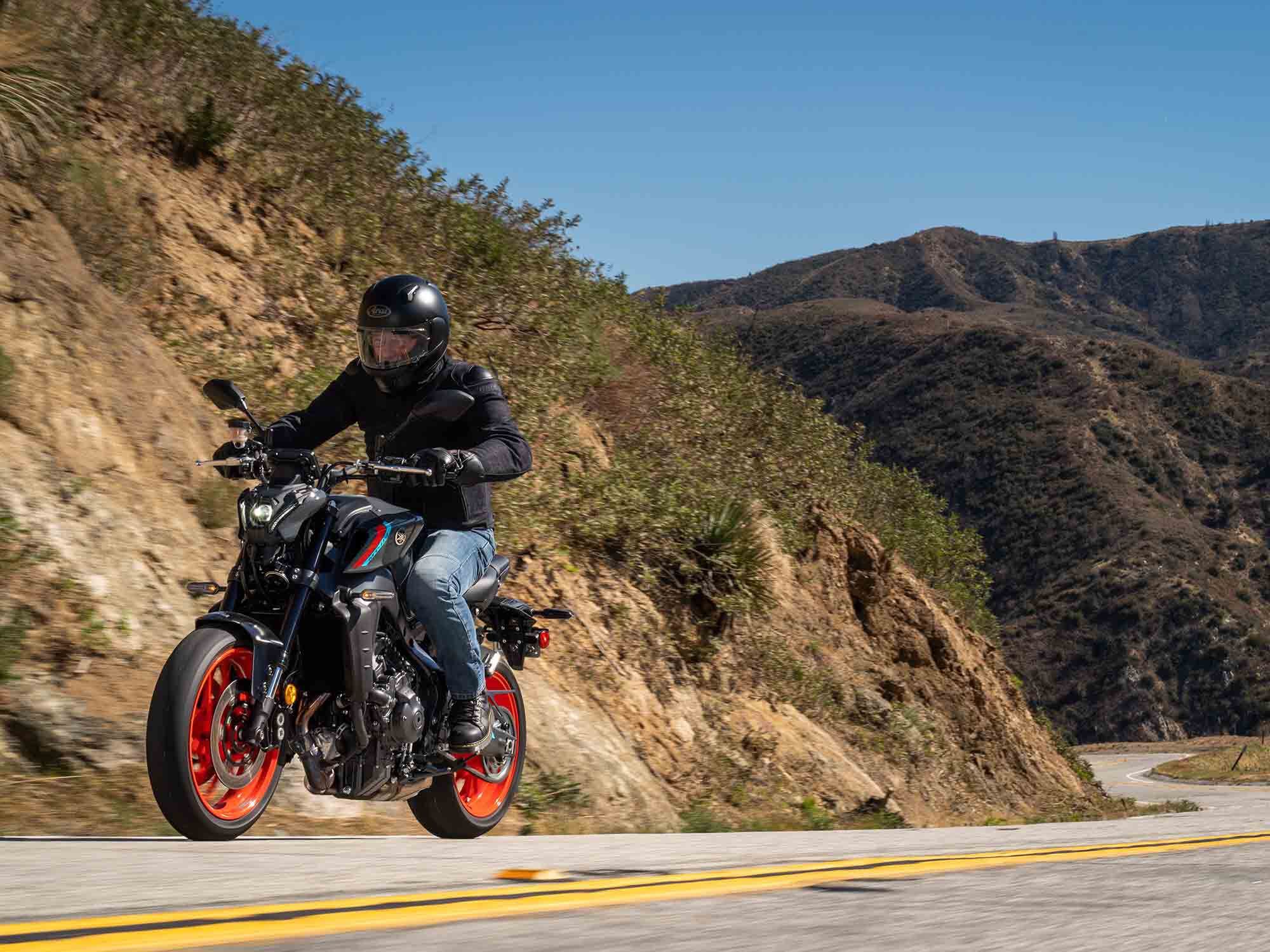
A small price increase of $400 is trivial compared to the value and performance that has been added to the 2021 Yamaha MT-09. (Yamaha/)The price has gone up, of course, with all the new features: it’s now $9,399, $400 more than for last year’s bike. But so has the value, with refinement and electronic aids no amount of money could have added to last year’s model. Yamaha is not going to have to worry about this one.
2021 Yamaha MT-09 Specifications
MSRP: $9,399 Engine: 890cc, DOHC, liquid-cooled, inline 3-cylinder; 4 valves/cyl. Bore x Stroke: 78.0 x 62.1mm Transmission/Final Drive: 6-speed/chain Fuel System: Fuel injection w/ YCC-T ride-by-wire Clutch: Wet, multiplate; assist and slipper Engine Management/Ignition: TCI (Transistor Controlled Ignition) Frame: Cast aluminum Front Suspension: 41mm inverted fork; preload, compression and rebound adjustable; 5.1 in. travel Rear Suspension: Single shock; preload and rebound damping adjustable; 4.8 in. travel Front Brake: Dual 298mm hydraulic disc w/ ABS Rear Brake: 245mm hydraulic disc w/ ABS Wheels, Front/Rear: Cast aluminum Tires, Front/Rear: 120/70ZR-17 / 180/55ZR-17 Rake/Trail: 25.0°/4.3 in. Wheelbase: 56.3 in. Ground Clearance: 5.5 in. Seat Height: 32.5 in. Fuel Capacity: 3.7 gal. Claimed Wet Weight: 417 lb. Availability: Spring 2021 Contact: yamahamotorsports.com -
-
Hello FatinaG,
Welcome to The Motorbike Forum. Please feel free to browse around and get to know the others. If you have any questions please don't hesitate to ask.
Why not tell us a bit about yourself too.
-
-
Hello rayzo82,
Welcome to The Motorbike Forum. Please feel free to browse around and get to know the others. If you have any questions please don't hesitate to ask.
Why not tell us a bit about yourself too.
-
Hello SFM,
Welcome to The Motorbike Forum. Please feel free to browse around and get to know the others. If you have any questions please don't hesitate to ask.
Why not tell us a bit about yourself too.
-
Hello Chris from Totnes,
Welcome to The Motorbike Forum. Please feel free to browse around and get to know the others. If you have any questions please don't hesitate to ask.
Why not tell us a bit about yourself too.
-

Kevin Cameron has been writing about motorcycles for nearly 50 years, first for Cycle magazine and, since 1992, for <em>Cycle World</em>. (Robert Martin/)In the modern era motocross was the leader in the adoption of aluminum chassis members, putting aluminum swingarms on factory bikes in the mid-1970s as part of the long-travel and single-shock revolution. For GP roadracing Yamaha, in 1980, produced an otherwise conventional chassis made from square extruded aluminum tubing. In both cases, the aluminum used was equivalent to forged, as the high pressure of extrusion has the effect of refining grain structure and closing up any voids or porosity in the material, thereby greatly increasing its resistance to fatigue.
What is metal fatigue, and how does it work? If we pull out the textbooks we find fatigue failure has three stages:
- Crack Initiation: As the material is strained by cyclical applied loads, gradually the atomic bonds under greatest stress relax by breaking, cumulative damage is done to the coherence of the material, and eventually here or there an actual detectable crack forms.<br/>
- Crack Propagation: Any microcrack grows perpendicular to applied tensile (pulling) stress.<br/>
- Rupture: As the crack grows, the intensity of stress rises because part cross-section is being reduced. Eventually the part breaks.<br/>
Now the really interesting part. Whereas Stage 1 (initiation) can take a very long time in steel, it was found that in cast aluminum Stage 1 was either quite short or even completely missing—crack propagation began as soon as stress cycling was applied to a cast test specimen.
Fairly recently researchers looked into why cast aluminum parts have behaved this way. They knew that a film of aluminum oxide forms on the surface of molten aluminum, but what they didn’t realize for a long time was that bits of this film are entrained in liquid aluminum when it is poured rapidly, from above, into conventional casting molds.
Anyone who has made pudding on the stovetop knows that as pudding cools, a fairly tough skin forms on its surface (hence the expression “My bike’s too weak to pull the skin off a pudding.”).
Stir the cooled pudding and the skin disappears as it absorbs water, ceasing to be a skin.
The same does not happen in the case of aluminum oxide films carried into metal poured into a casting mold. The oxide is not soluble in aluminum, and does not transmit stress well. Therefore every bit of aluminum oxide entrained into an aluminum casting becomes a pre-existing crack once the material solidifies. The existence of such cracks is why Stage 1 in the fatigue process in cast aluminum has been either very short or nonexistent.
RELATED: Everything You’ve Ever Wanted To Know About Aluminum
To avoid the need to employ castings, Yamaha and other early adopters of aluminum chassis for roadracing used extruded tubes or beams formed from rolled sheet, joined to very expensive, machined-from-solid wrought stock steering-head and swingarm uprights (the vertical members at the rear of the frame, between which the swingarm is located). This was perfectly acceptable for factory racebikes but far too expensive a construction ever to be adopted for production motorcycles.
I was therefore greatly surprised when I flew to England in the late ’90s to see the Al Melling-designed “Norton-of-the-moment.” It had a cast chassis! How could this be?
Soon thereafter, Yamaha began to produce cast parts for chassis by its “CF” or controlled fill casting process. Miguel DuHamel’s longtime mechanic Al Ludington complained to me around the year 2000 that suddenly Yamaha’s 600 Supersport bikes were more than 30 pounds lighter than Honda’s CBR. And later again, Ducati adopted the Ritter Vacural casting process for its major castings.
Yamaha’s description of its CF process reveals that it can cast thicknesses one-half those of previous methods—1.7mm rather than the previous 3.5mm (0.070 inch versus 0.138 inch). That’s really thin! In addition, and quite unlike extruded tube or sheet fabrications, local part thickness could be made infinitely variable in proportion to applied stress.
RELATED: What About Different Motorcycle Chassis Materials?
A major advantage of the new casting processes was that they were deliberately designed to prevent the entrainment of surface films of aluminum oxide into the flow of liquid metal entering the mold. By filling from the bottom at low metal velocity, oxide films would remain floating on the upper surface of the hot metal, eventually to be lifted out the vents at the top of the mold. Vacuum could also be applied to make less oxygen available to the hot metal.
Previously, researchers had learned something by filtering aluminum through porous ceramics before it entered molds, discovering that this somewhat improved fatigue performance. That stimulated further research.
Now that the fatigue performance of bottom-fill, low-turbulence casting systems has been well established, Stage 1 of the fatigue process has been greatly extended, making cast aluminum chassis the most economical way of producing production bike chassis. Little or no welding is now required—some chassis are one-piece and others consist of right and left halves, bolted or otherwise fastened together (as in Harley’s LiveWire and Aprilia’s 660).
RELATED: The Origins Of Metal Alloys
When an English engineer put me on the spot a few years ago by asking, “What is the greatest engine design innovation of the 21st century?” he took pity on my hesitating ignorance and said, “Modern casting methods, which have so greatly reduced engine weight without reducing strength.”
There is more to the new methods than just their great reduction in oxide entrainment, but that is the largest contributor to the result, which are cast parts with near-forged fatigue properties. Twenty-first century methods for casting aluminum have brought to production the advantages of aluminum chassis formerly too costly for any application but factory racing.
-
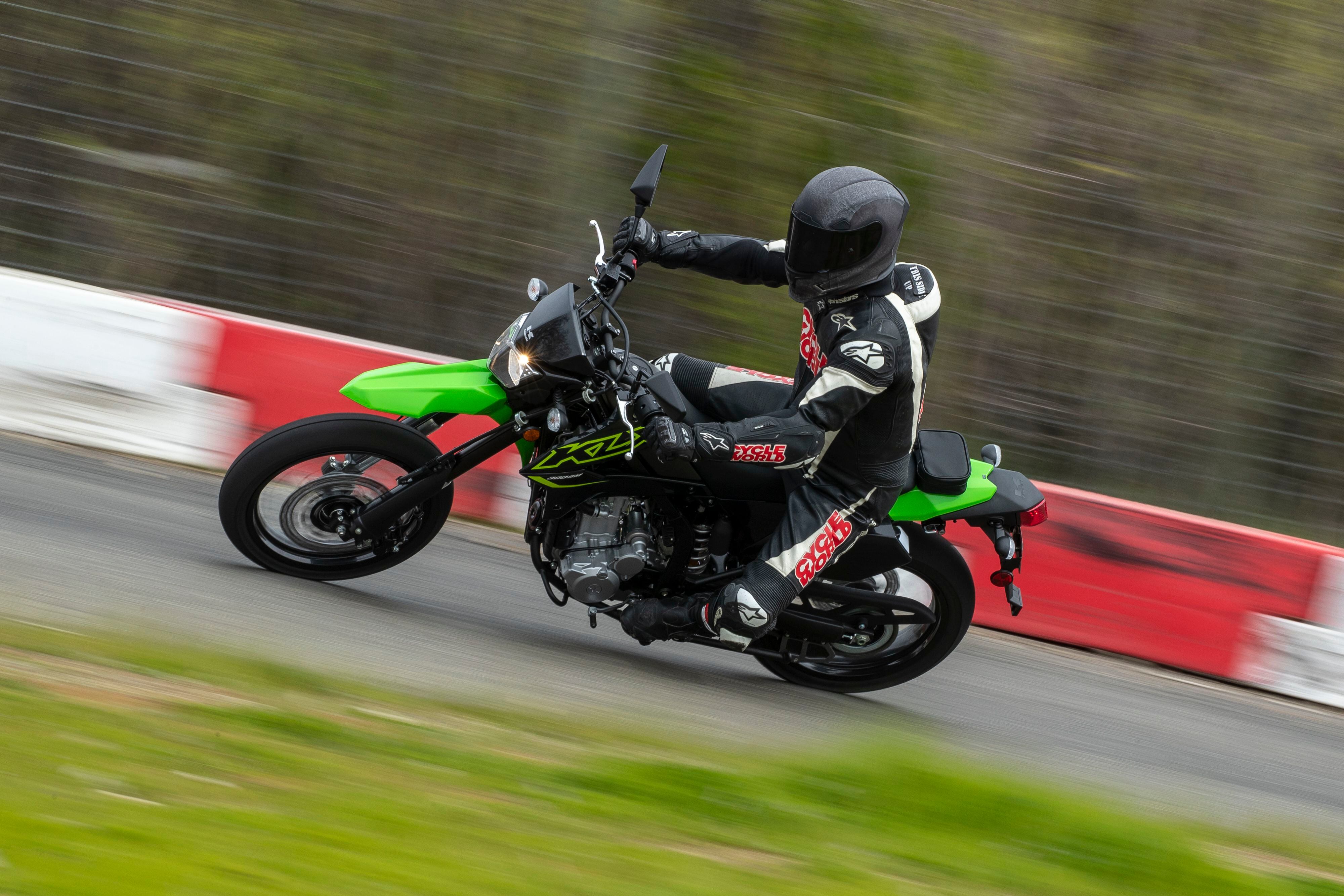
Kawasaki has two choices for street-legal small-bore fun based on the KLX300R: the supermoto-syled KLX300SM shown here and the KLX300 dual sport. (Kevin Wing/)A year ago Kawasaki introduced its KLX300R, an affordable user-friendly off-road enduro model appealing to dirt riders of all ability levels. At the time it was only natural to ponder the possibility of a road-legal dual sport version to follow. We didn’t have to wait long. Kawasaki has introduced a pair of road-legal KLX300 models for 2021. Offered alongside the on-and-off-road-capable KLX300 dual sport is the KLX300SM, a supermoto version for pavement-pounders seeking an affordable and ultra-agile urban scraper with roomy ergonomics and thrilling backroad potential.
There’s a chance you may have already seen or sat astride the KLX300, as both versions have been available in dealerships for some time now. With COVID restrictions beginning to lift, Kawasaki recently invited members of the motorcycle press to Folsom, California, for two days of play aboard its fun-evoking KLX300 duo. As to be expected, the event was conducted in adherence to social-distancing protocol; to this end, the technical brief was held via a Zoom conference call a few days before the ride, and once on-site in Folsom, a face mask was to be worn when not wearing a helmet. Seems helmets can reduce the spread of the virus somewhat; who knew? Anyway, despite there being no group meals or broin’ at the hotel bar, it was great to get out and bump elbows with fellow enthusiasts.
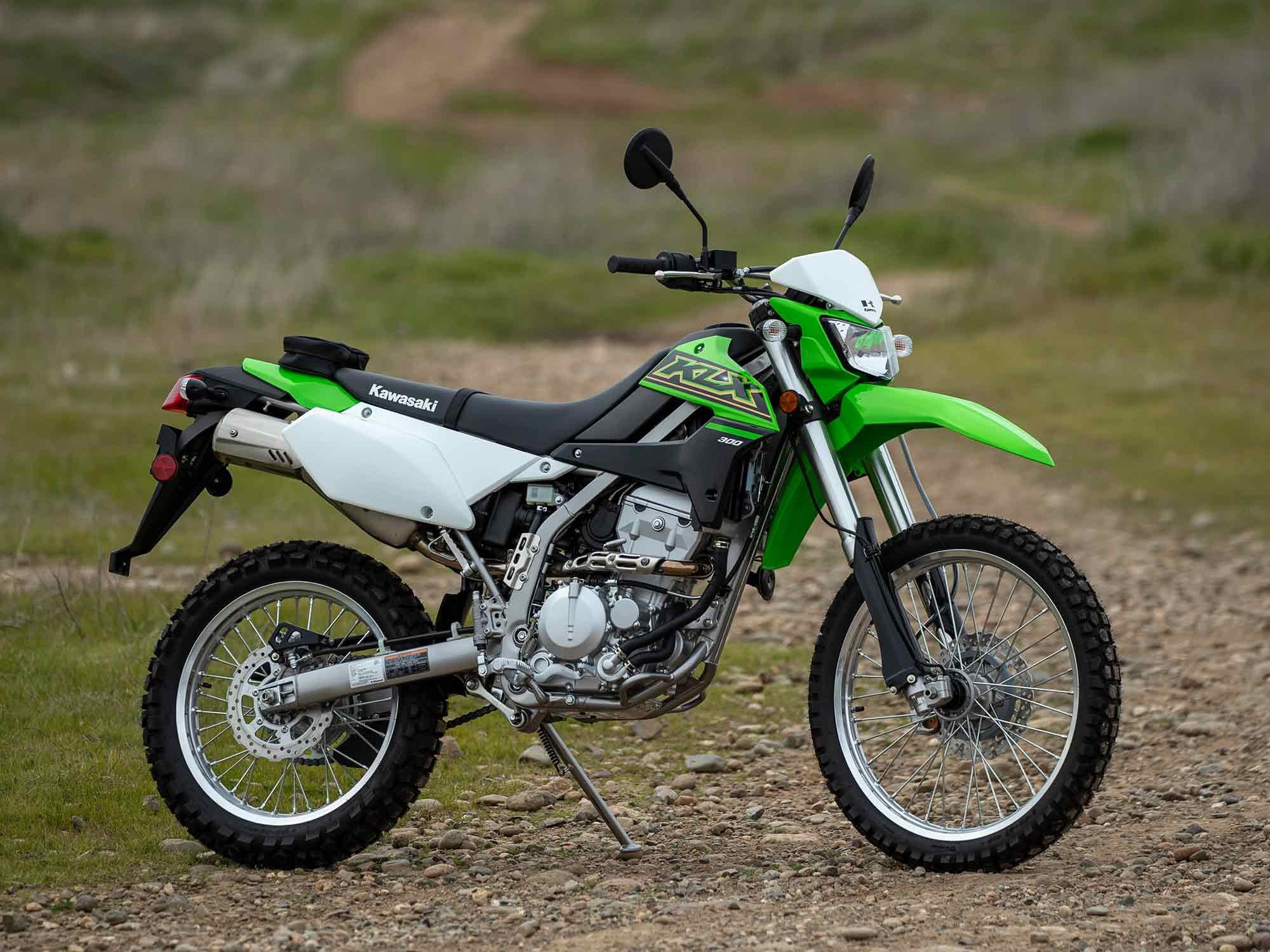
The dual sport KLX300 is fit with a 21-inch front tire and 18-inch rear. (Kevin Wing/)Our first day began with us riding a varied route incorporating freeway, winding pavement, and dirt backroads threading through the Sierra Nevada foothills aboard the dual sport KLX300. We spent the later part of the day trail riding at Prairie City SVRA off-road park. The next day found us tracing a similar route, sans dirt roads and trails, aboard the KLX300SM, once again arriving later at Prairie City for an afternoon hot-lapping the facility’s paved kart track.
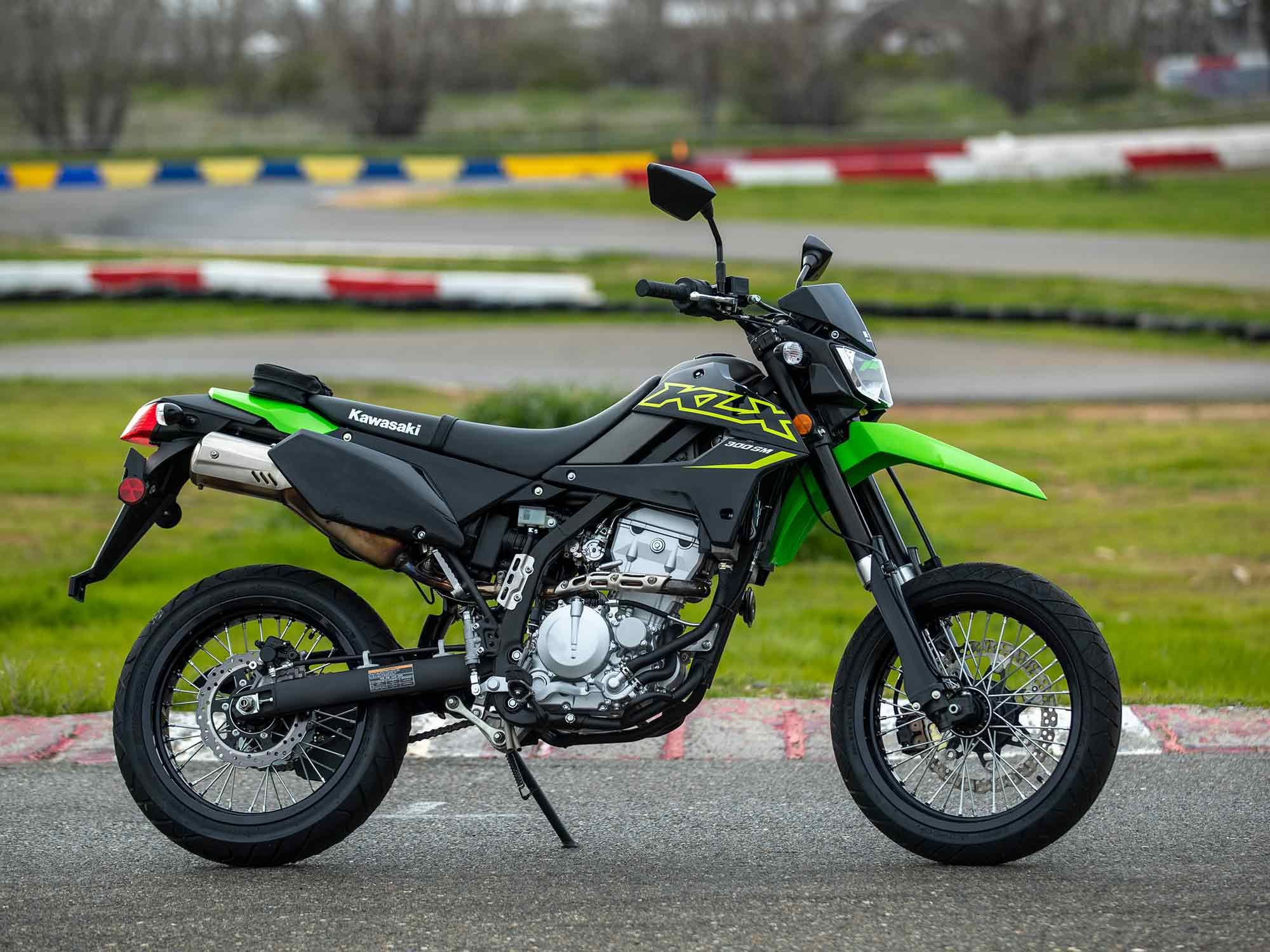
Supermoto-sized 17-inch wheels, shorter suspension, and a larger front brake differentiate the KLX300SM from its dual sport sibling. (Kevin Wing/)Engine-wise, the KLX300 retains the 61.2mm stroke of its 249cc predecessor, but uses a 6mm-larger bore. Its four-valve head shares the same cam profiles as the KLX300R. The fuel-injected liquid-cooled DOHC four-stroke 292cc single-cylinder engine churns out ultra-linear delivery from bottom revs to its 10,500 rpm limit. Power is accented with a whisper of top-end surge that comes in around 8,000 rpm and can be felt in the bottom gears of the six-speed gearbox. The chassis is a direct carryover from the KLX250 and features a lightweight perimeter steel frame and aluminum D-section swingarm. A 43mm inverted cartridge-style fork offers 16-way-adjustable compression damping and 10 inches of travel. Supporting the rear is a gas-charged piggyback reservoir shock offering preload adjustability and 30-way rebound damping adjustments to its 9.1 inches of rear wheel travel. Wheel size is a standard off-road combo of 21-inch front and 18-inch rear fitted with Dunlop D605 dual sport rubber.
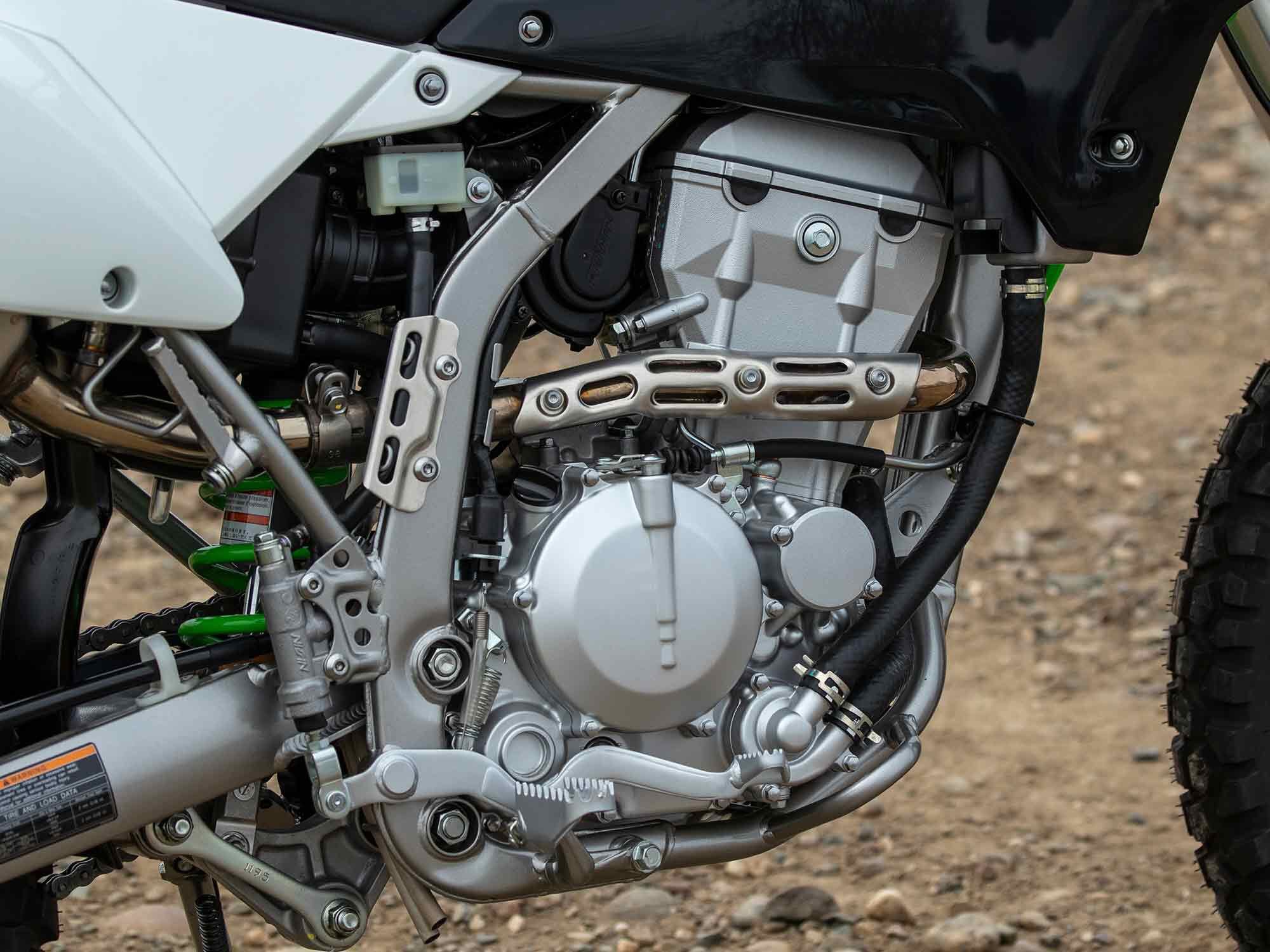
A 292cc four-stroke single powers both street-legal KLX300 models. (Kevin Wing/)I stand 5-foot-10 with a 32-inch inseam, and I found the KLX’s 35.2-inch unladen seat height does require a bit of a leg hike to mount. With the suspension compressed a few inches under my 185 pounds, my boot heels still hovered an inch off the ground with both feet down. Even so, I had little difficulty backing the light KLX out of a parking stall. Beyond that I rarely put both feet down, making traffic signals and trailside stops stable one-footed affairs.
Equipped with EFI and convenient electric start, the KLX proved hassle-free to cold start, a momentary bump of the thumb button effortlessly prodding the motor into a smooth idle. The bike’s compact battery doesn’t offer much surplus capacity, as discovered by a few riders in the group who repeatedly left the ignition key on during our frequent engine-off photo stops, but the KLX bump-started with ease.
The initial leg of our ride, along US Route 50, provided a positive impression of the bike’s freeway manners. The engine features a gear-driven counterbalancer that does an excellent job smoothing vibes, with only a light buzz detected in the bars and footrest, mildly gaining intensity when engine revs climb beyond 6,000 rpm. At an indicated 70 mph in top gear, the LCD bar-type tachometer registers 7,500 rpm. The KLX hums along contentedly at that pace and will pull upwards of 8,500 rpm on a level stretch; however, the assistance of a downhill grade or tailwind is needed to tap the remaining 2,000 revs in sixth.
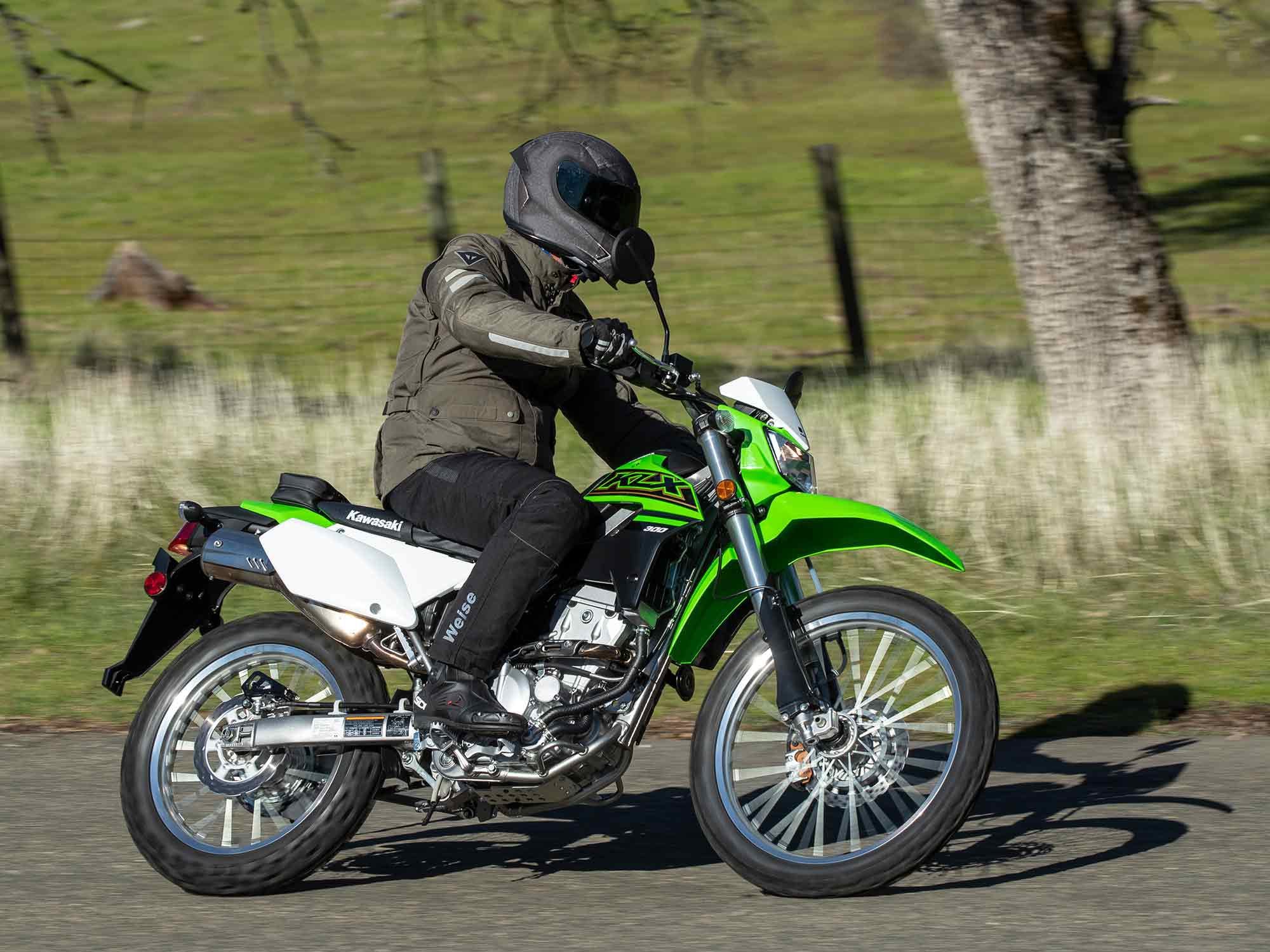
The KLX300′s cockpit is spacious and comfortable, and engine vibrations are well controlled via a gear-driven counterbalancer. (Kevin Wing/)The KLX’s upright riding position provides generous legroom, a relaxed feel, and a deeply padded urethane seat, a combination that suggests decent comfort range, though that couldn’t be confirmed on our fairly short 70-mile ride loop. I can say with certainty, however, that the airflow at head and shoulders level was without buffet, a credit to the stubby cowl above the headlight.
Venturing onto a narrow winding backroad, the nimble KLX tipped into corners with just a hint of steering input. I initially felt the bike was too willing to fall in when entering slow to medium speed bends, a sensation I became accustomed to after a few miles of curves. Its plush suspension soaks up road bumps and ripples with ease, yet offers good damping control, delivering a comforting sense of overall stability and composure. Its light-effort clutch and slick shift action made selecting the proper gear easy work, and there’s enough low-end torque available to pull cleanly out of corners when you choose to play it mellow.
When we left the pavement for a groomed gravel road, the chassis continued to track straight and true at speed whether seated or standing. Perching on the pegs felt natural, as the KLX300′s ergos are more akin to a full-size dual sport than small-displacement playbike. The road became more entertaining as rain-filled potholes of varying size provided a 50 mph slalom. The bike threaded through the larger water holes with ease and control; a total blast.
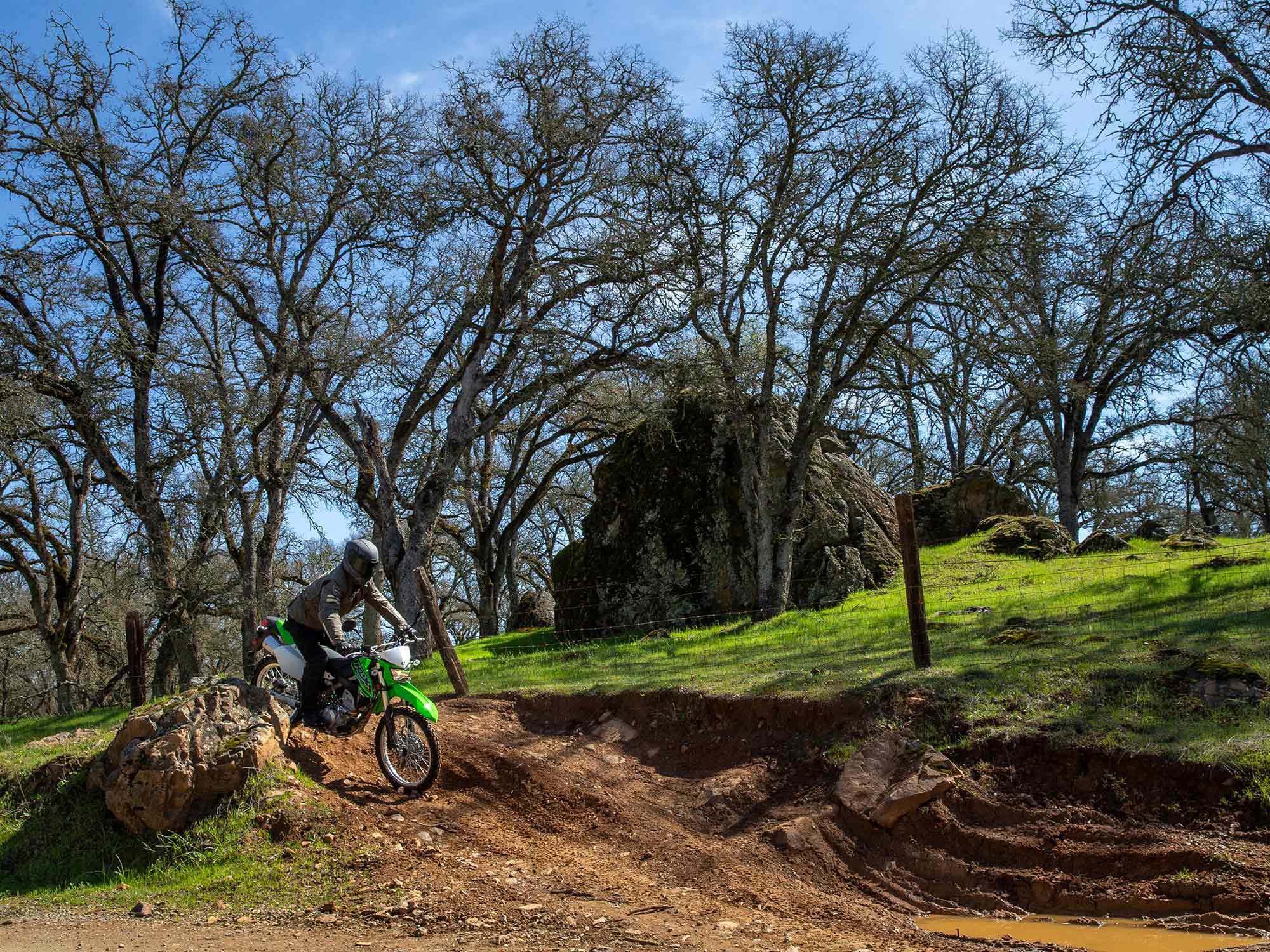
At a casual pace the KLX300 has great trail manners. (Kevin Wing/)Prairie City offered a variety of slower technical terrain, including rutted single-track climbs, rocky creek beds, loamy sand, berms, and whoops. Being a casual trail rider at best, I appreciated the mild-mannered KLX300 when shaking off years of off-road riding rust. Intuitive throttle response and predictable power delivery help maintain rear grip. The engine chugs smoothly at its 1,800 rpm idle speed in low gear, with no hesitation as the throttle is cracked open, making it all the better when picking a line through the cannonball-sized river rocks littering several of the trails. The suspension had no issue dealing with anything I was inclined to tackle, such as hopping a log, rolling the whoops, or catching a pitifully modest amount of air. Your dual sport aspirations may well be more demanding.
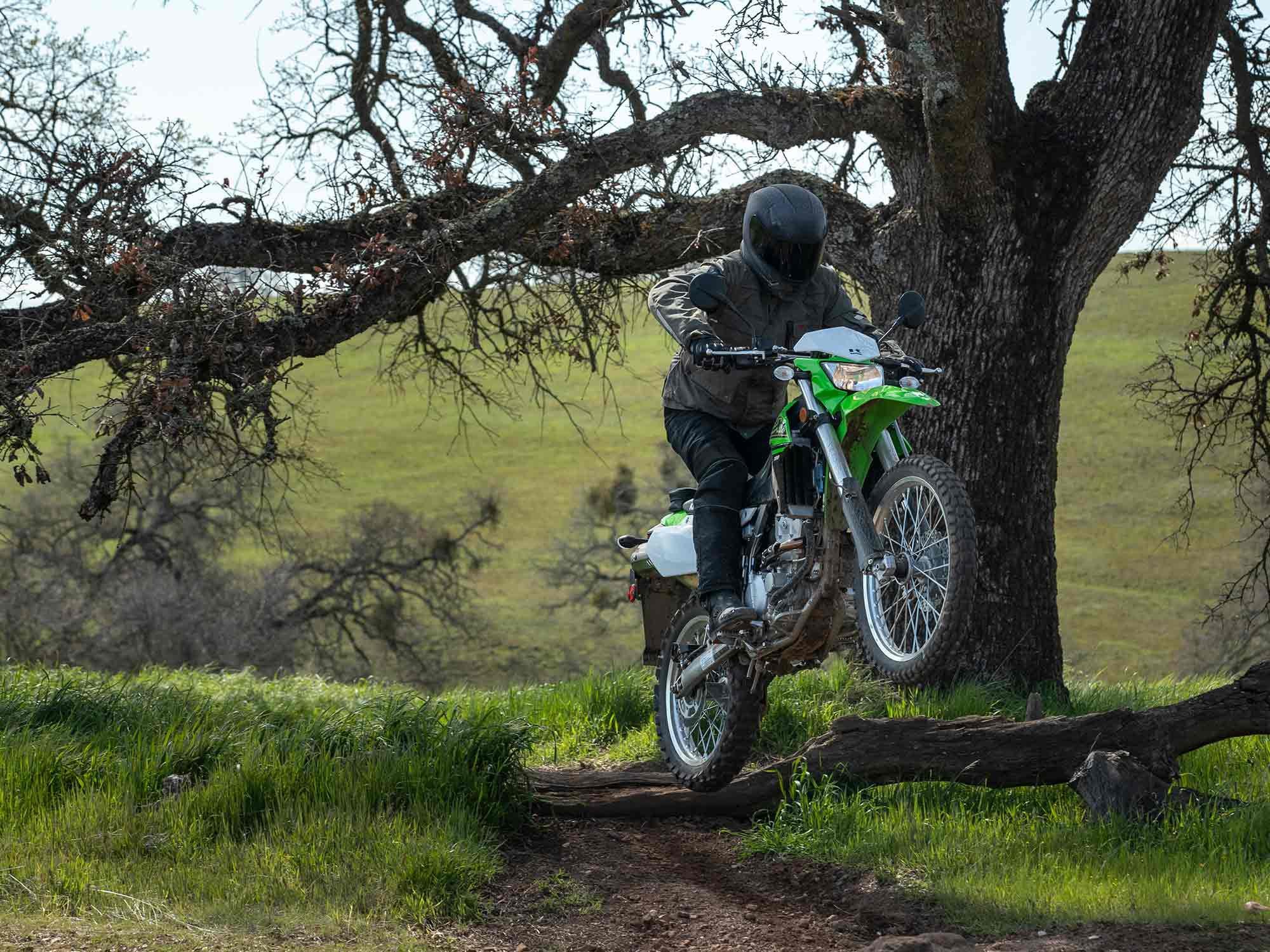
The KLX300′s suspension handled small hops and jumps with ease; fast, aggressive riders will most likely find the limits quickly. (Kevin Wing/)Being primarily a road rider, I immediately felt at home astride the KLX300SM for our supermoto play day. Its lowered suspension and 17-inch wheels amount to a 1.3-inch reduction in saddle height and allowed me a solid flat-foot stance. Cruising the freeway stretch at 70 mph registered a more relaxed 7,000 rpm on the tachometer due to a rear sprocket three teeth smaller than the KLX300′s. The SM also has rubber-topped footrests that effectively isolate what little vibration is felt through the dual sport’s dirt-style footrests. I also detected a slight reduction of vibes in the hand grips at any given rpm, something I assume can be attributed to a change of harmonic pitch with the SM’s inch narrower bar width. Or perhaps it’s the street-style mirrors? I digress.
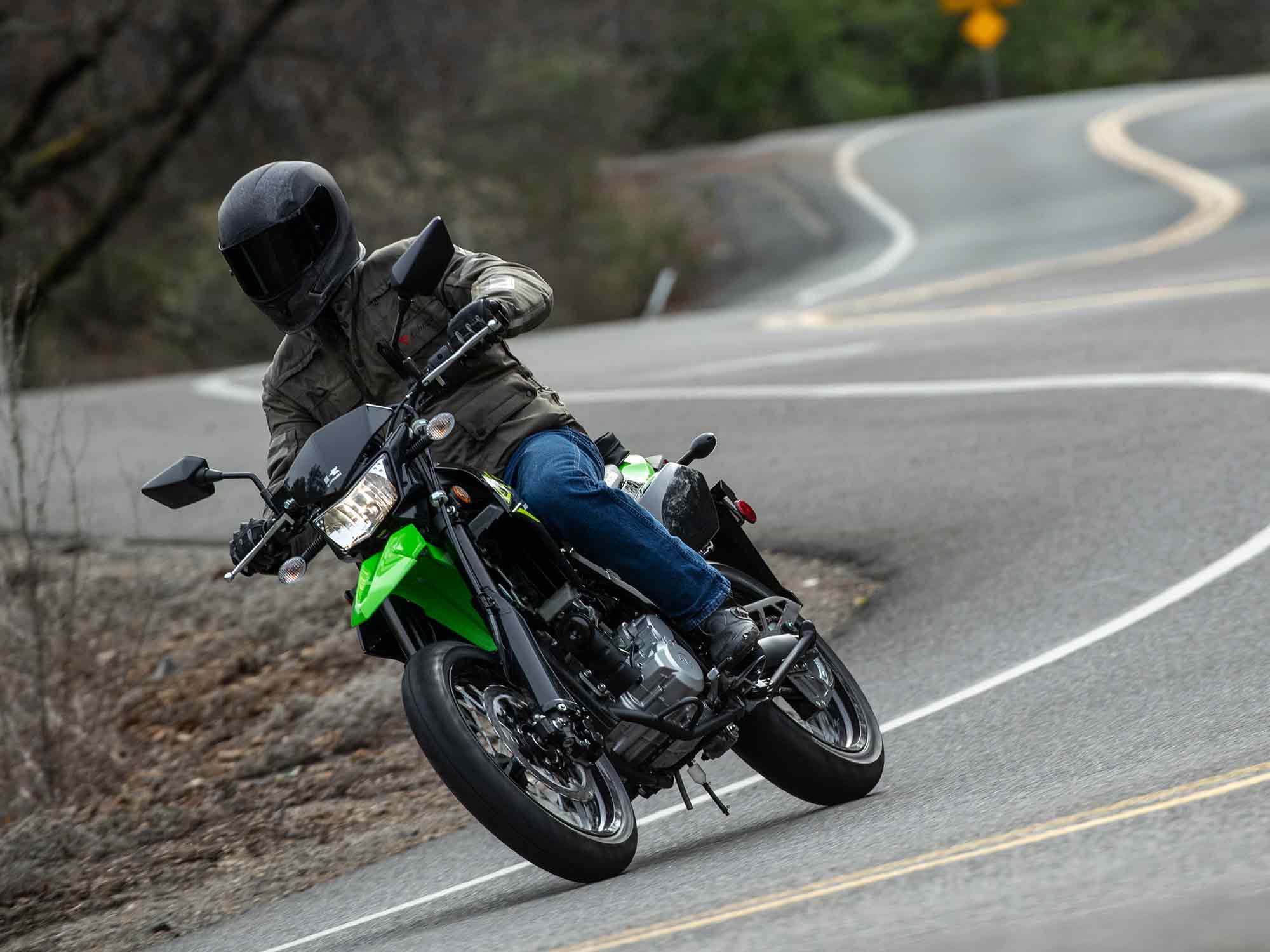
On the road the KLX300SM’s firmer springs and 17-inch wheels give more road feel and less weight transfer during acceleration and braking. (Kevin Wing/)Traveling a few of the same backroads as the previous day offered an interesting contrast in chassis feel. Compared with its dual sport sibling, the suspension spring rate of the SM is 39 percent firmer up front and 23 percent firmer at the rear. The result is dramatically greater tactile feel for the road surface, as in “dang, this road is kinda rough,” along with reduced fore-aft chassis motion when accelerating, and particularly so when applying a handful of front brake. The SM’s steering is very neutral and light in effort without the tippy feel I experienced the previous day. Despite the reduction in rake and trail, the sense of straight-line stability at speed hasn’t been compromised.
A highlight of the event was leathering up and lapping the kart track. A mix of foot-out moto-style in the circuit’s tightest hairpins and knee-dragging in the faster bends proved a fun and effective way to rip it up. I came away impressed with the level of grip offered by the IRC Road Winner tires, which allowed peg-scratching cornering lean without a slip or slide. The SM’s larger-diameter (and 1mm thicker) floating front brake also impressed, offering fade-free stopping performance and a consistent firm lever feel. While many KLX300SM owners may not have access to a kart circuit, it doesn’t hurt to know the bike does have the potential.
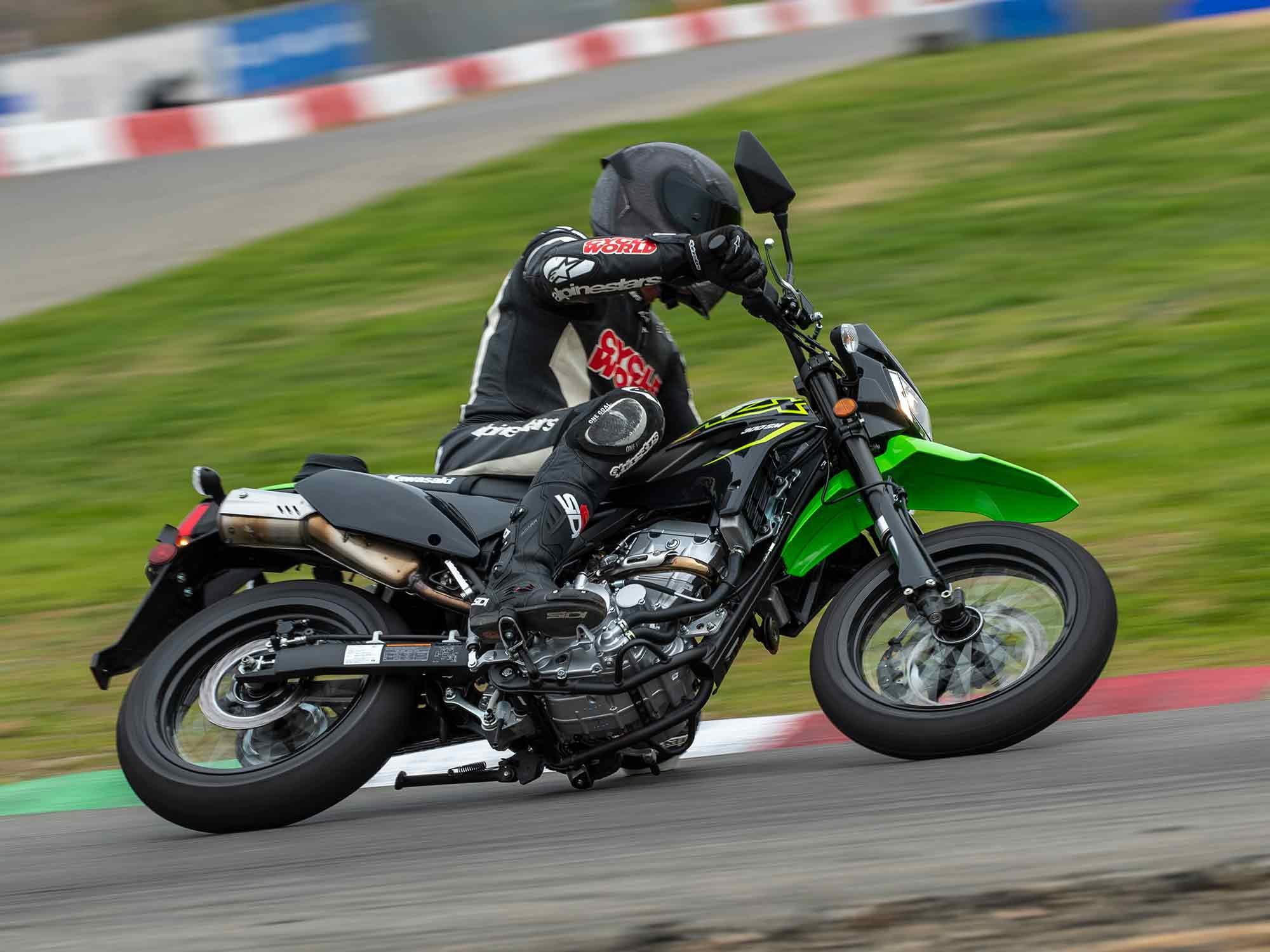
The KLX300SM was a blast on the karting track with fade-free braking and impressive grip from the IRC Road Winner tires. (Kevin Wing/)Which KLX300 model is the best choice for you will come down to riding priority. If off-road capability is in the cards, the choice is obvious; the dual sport provides that while still being an equally excellent economical commuter. But if dirt is an annoyance that you wipe off your shoes on the doormat before entry, the KLX300SM is a surefooted bet.
2021 Kawasaki KLX300 Specifications
MSRP: $5,599 Engine: 292cc DOHC liquid-cooled single Bore x Stroke: 78.0 x 61.2mm Transmission/Final Drive: 6-speed/chain Fuel System: DFI w/ 34mm Keihin throttle body Clutch: Wet, multiplate Engine Management/Ignition: CDI Frame: High-tensile steel, box-section perimeter Front Suspension: 43mm USD fork; compression adjustable; 10 in. travel Rear Suspension: Uni-Trak piggyback shock; preload and rebound adjustable; 9.1 in. travel Front Brake: 2-piston caliper,250mm petal disc Rear Brake: 1-piston caliper, 240mm petal disc Wheels, Front/Rear: Spoked; 21/17 in. Tires, Front/Rear: Dunlop D605; 21 x 3.0 in. / 18 x 4.6 in. Rake/Trail: 26.7°/4.2 in. Wheelbase: 56.7 in. Ground Clearance: 10.8 in. Seat Height: 35.2 in. Fuel Capacity: 2.0 gal. Claimed Wet Weight: 302 lb. Availability: Now Contact: kawasaki 2021 Kawasaki KLX300SM Specifications
MSRP: $5,999 Engine: 292cc DOHC liquid-cooled single Bore x Stroke: 78.0 x 61.2mm Transmission/Final Drive: 6-speed/chain Fuel System: DFI w/ 34mm Keihin throttle body Clutch: Wet, multiplate Engine Management/Ignition: CDI Frame: High-tensile steel, box-section perimeter Front Suspension: 43mm USD fork; compression adjustable; 9.1 in. travel Rear Suspension: Uni-Trak piggyback shock; preload and rebound adjustable; 8.1 in. travel Front Brake: 2-piston caliper, 300mm petal disc Rear Brake: 1-piston caliper, 240mm petal disc Wheels, Front/Rear: Spoked; 17/17 in. Tires, Front/Rear: IRC Road Winner; 110/70-17 / 130/70-17 Rake/Trail: 25.0°/2.8 in. Wheelbase: 56.5 in. Ground Clearance: 9.3 in. Seat Height: 33.9 in. Fuel Capacity: 2.0 gal. Claimed Wet Weight: 304 lb. Availability: Now Contact: kawasaki -
-
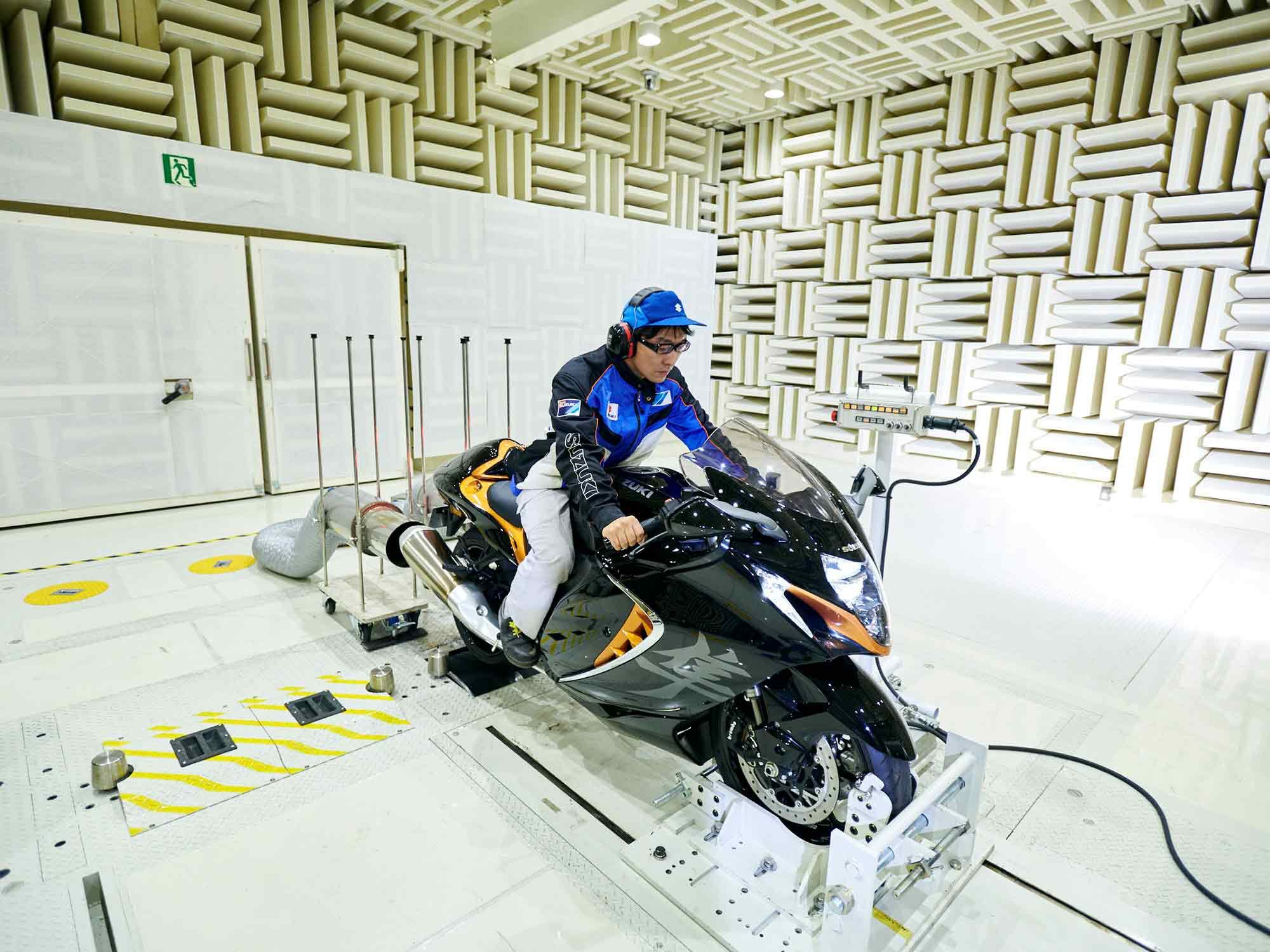
Euro 5 emissions regulations had much to do with the changes to the 2022 Suzuki Hayabusa (shown here during sound testing). (Suzuki/)The emissions reductions required by the new Euro 5 standards are the underlying reason for Suzuki updating the Hayabusa, thereby enabling its sales to continue. The reductions in comparison to Euro 4 are 12 percent in carbon monoxide (CO), 41 percent in unburned hydrocarbons (UHC), and 33 percent in nitrogen oxides (NOx), in effect from January 1, 2020.
The Gen 2 Hayabusa carried two exhaust catalysts, located forward at the header pipe junctions. The new Gen 3 Hayabusa adds downstream cats located in the mufflers. Contact between hot exhaust gas and the chemically active catalyst pushes chemical change in the desired directions: toward completing the combustion of UHC and carbon monoxide and reduction of smog-forming nitrogen oxides.
As in the previous model, to assist exhaust oxidation catalysts in their work of completing combustion of UHC and carbon monoxide to form carbon dioxide, extra oxygen is provided by Suzuki’s “PAIR” pulsed secondary air-injection system (this is equivalent to the “smog pumps” that were once common on auto engines).
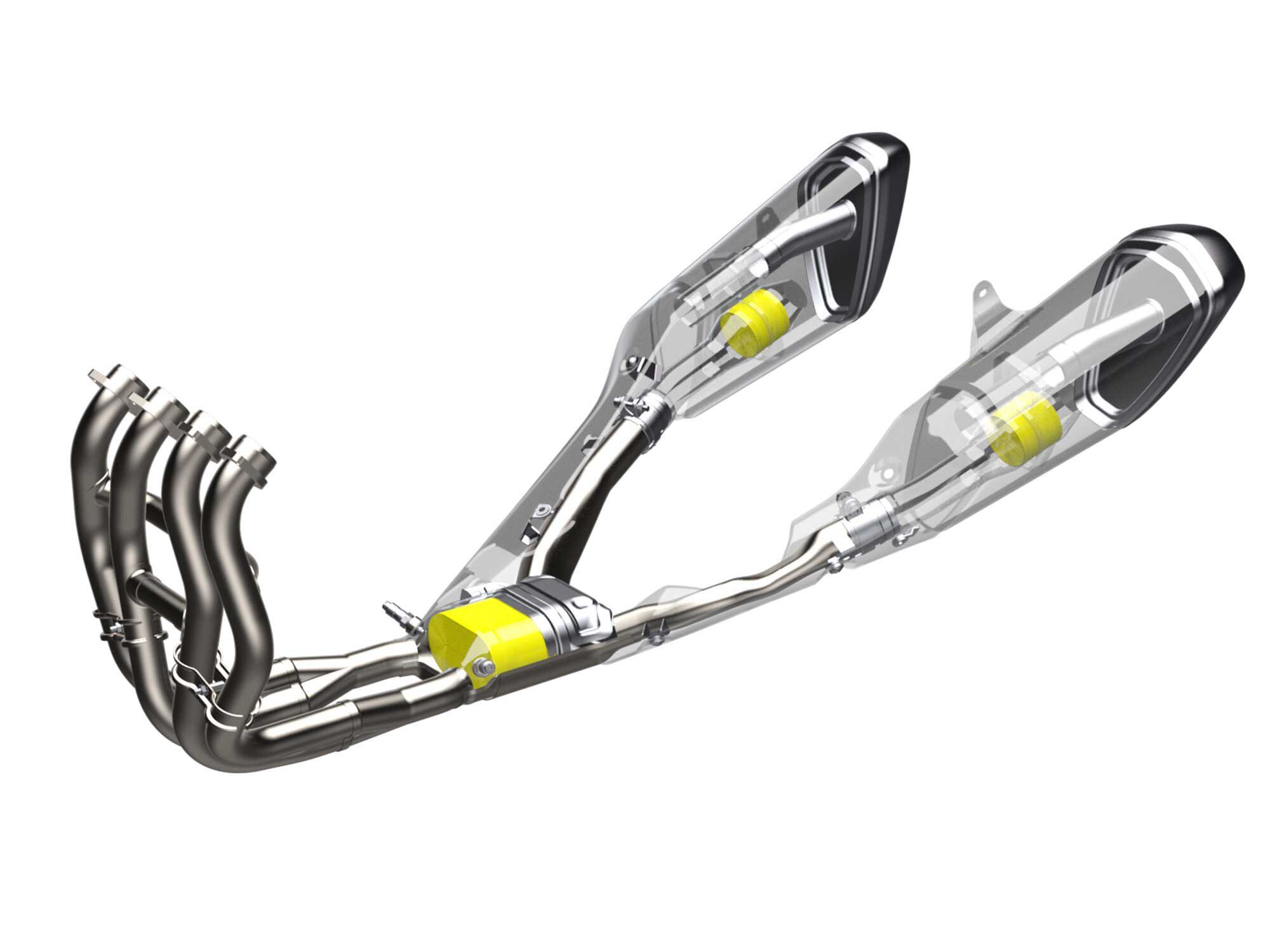
The 2022 Hayabusa features catalysts in its mufflers. (Suzuki/)For years, It was routine to give sportbike engines fairly long cam timings to boost cylinder filling at higher rpm, even though doing so allowed some mixture to be back-pumped at lower revs, resulting in reduced torque at bottom-to-mid rpm. Such long timings required considerable valve overlap.
Mixture control becomes more complicated during rapid changes of load. Additional control over engine fuel mixture during rapid load changes is provided by the Gen 3 Hayabusa’s throttle-by-wire system.
During the carburetor era it was possible for the rider to turn the throttle so fast that fuel could not keep up with air rushing into the engine. The result was a lean stumble. The CV carburetor of the 1980s overcame this by providing a secondary throttle slide whose opening was slightly delayed by venturi vacuum: No matter how quickly the rider snapped the throttle, the vacuum-controlled slide would maintain the venturi velocity necessary to keep adequate fuel flowing.
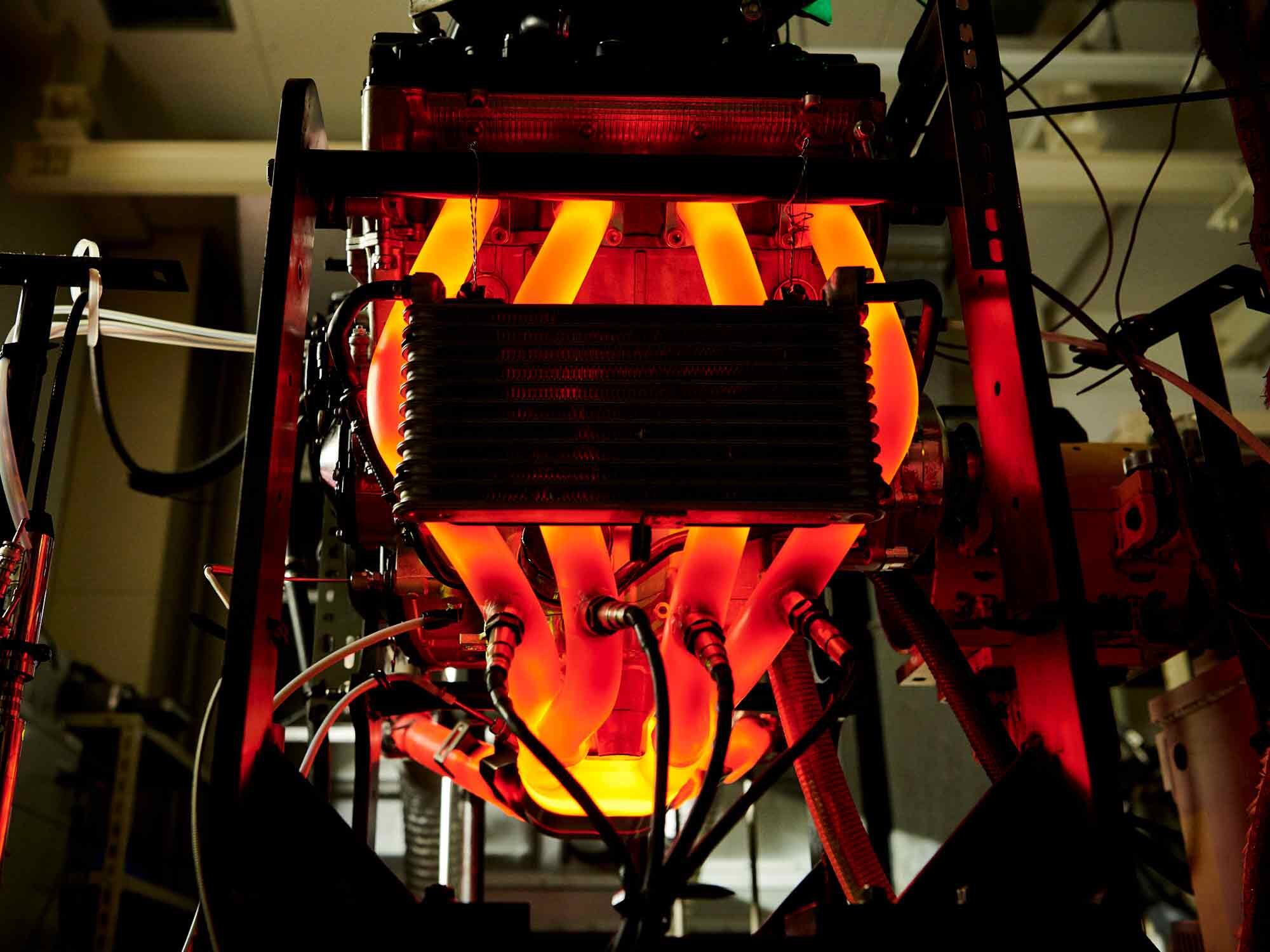
Contact between the hot exhaust gas and the catalytic converter (the brightest glowing area) completes the combustion of UHC and carbon monoxide and reduces smog-forming nitrogen oxide. (Suzuki/)When fuel injection arrived in the ’90s, the throttle butterfly in each cylinder’s throttle body was controlled directly by the rider via a steel throttle cable, so once again it became possible for the rider to open the throttle too fast. Suzuki’s solution was to place a secondary throttle plate, controlled by the ECU, in each throttle body. Mimicking the action of a CV carb’s secondary throttle, this plate would open at a rate that enabled the fuel system to keep up. This was called Suzuki Dual Throttle Valve (SDTV).
Updating to modern electronics, the Hayabusa now employs throttle-by-wire, a copper throttle “cable.” When the rider moves the throttle grip, an electronic sensor (the throttle position sensor, or TPS) reports its angle, and the ECU interprets this as a torque demand. It then opens the throttle and supplies fuel appropriate to that demand. The result is more accurate mixture control during rapid throttle movement. When mixture is correct—neither rich nor lean—fuel has the best chance of burning completely, thereby both boosting response and reducing emissions.
Previously each cylinder’s intake tract contained two injectors: a lower one beneath the rider-controlled throttle plate and an upper side injector aimed at the secondary throttle plate. In the 2022 throttle-by-wire Hayabusa, there is no secondary throttle plate, so the upper injector’s fuel jet is broken up by hitting a fixed metal plate whose surface is parallel to the airflow. On many bikes, the upper injectors, called “showerheads,” hover over each intake’s bellmouth. On the Hayabusa, where height is at a premium, the upper injectors are “side feeders” that spray at an angle through the sides of the intakes. Intake tract length has been increased by a half-inch. Suzuki states that fuel breakup against the fixed plate contributes a 2 percent gain to low- and midrange torque. The injectors are altered to produce a finer droplet size as well.
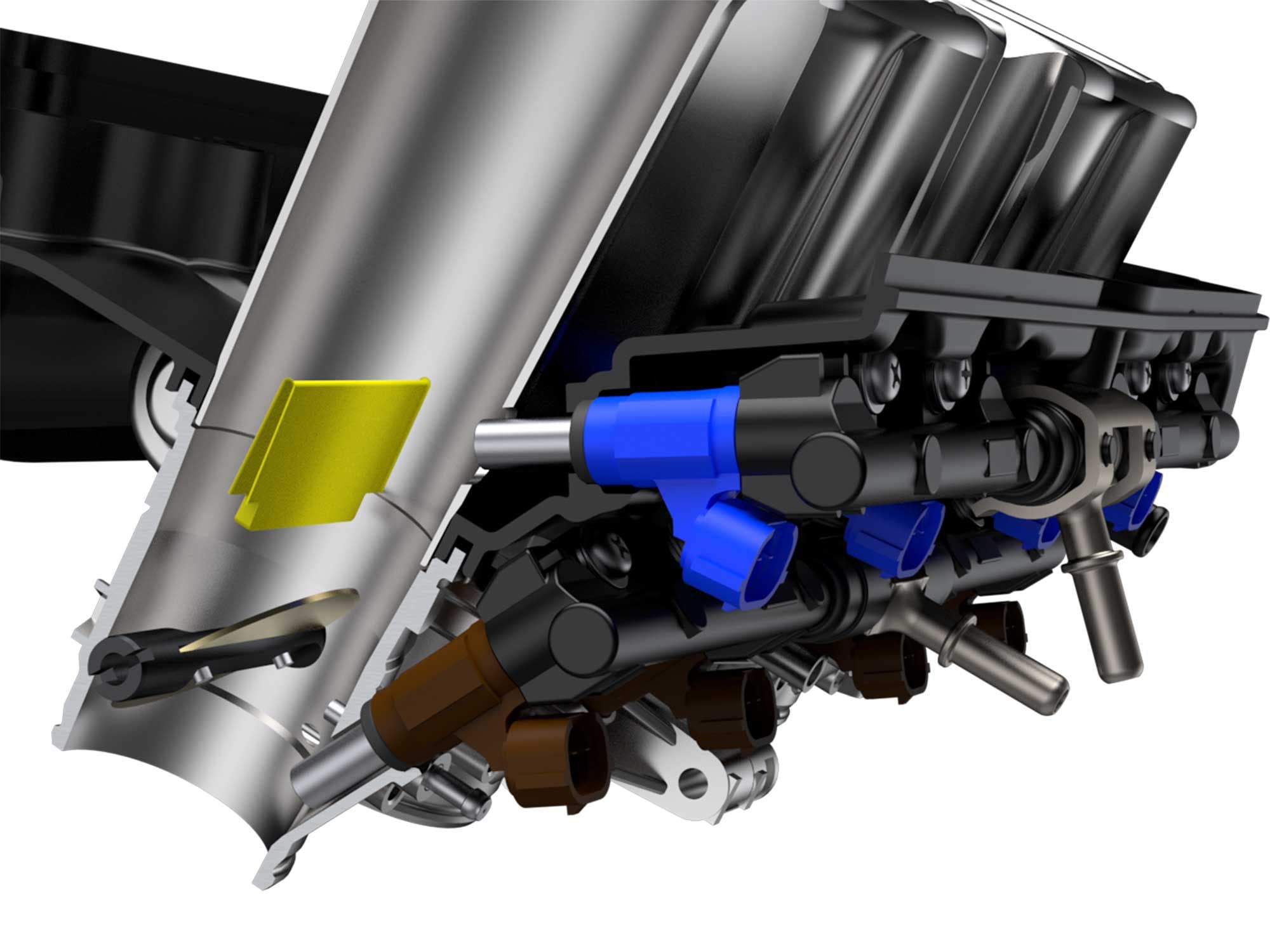
The 2022 Hayabusa’s upper fuel injectors spray against a fixed plate in the throttle body. (Suzuki/)How does fuel droplet size affect power, fuel consumption, and emissions? Any fuel system dependent upon the rapid evaporation of a spray produces a range of droplet sizes (the same is true of the liquid propellants injected into rocket engine thrust chambers). Depending on the size and number of the largest droplets produced, some fuel may not have time to evaporate and fully take part in combustion. Such unburned fuel, by slightly cooling combustion, reduces power and increases both fuel consumption and UHC emissions.
Detail Changes to Combustion Chambers
Suzuki’s provided press materials compare the Gen 2 and 2022 chambers. In Gen 2 there is a triangular cusp of squish area between the pairs of intake valves (squish is those parts of piston crown and head that come very close to each other at TDC, to rapidly “squish” out the mixture between them, forming fast jets that usefully accelerate combustion).
Air quality agencies dislike squish because it can act to cool or “quench” combustion by close proximity to cool metal surfaces, increasing the production of UHC. Rule of thumb in the past has been to devote 15 percent of four-stroke piston crown area to squish, but times have changed. When emissions requirements deny engineers one way to get what they need, they work to get the same effect by other means. A much stronger potential source of turbulence to speed combustion is the inrush of high-velocity mixture during the intake stroke, and the best way to prevent loss of that turbulence-producing velocity during the following compression stroke is by making the inside surfaces of head and piston crown as smooth as possible. The new Hayabusa’s reduced valve overlap requires fewer deep valve clearance notches in the piston crown.
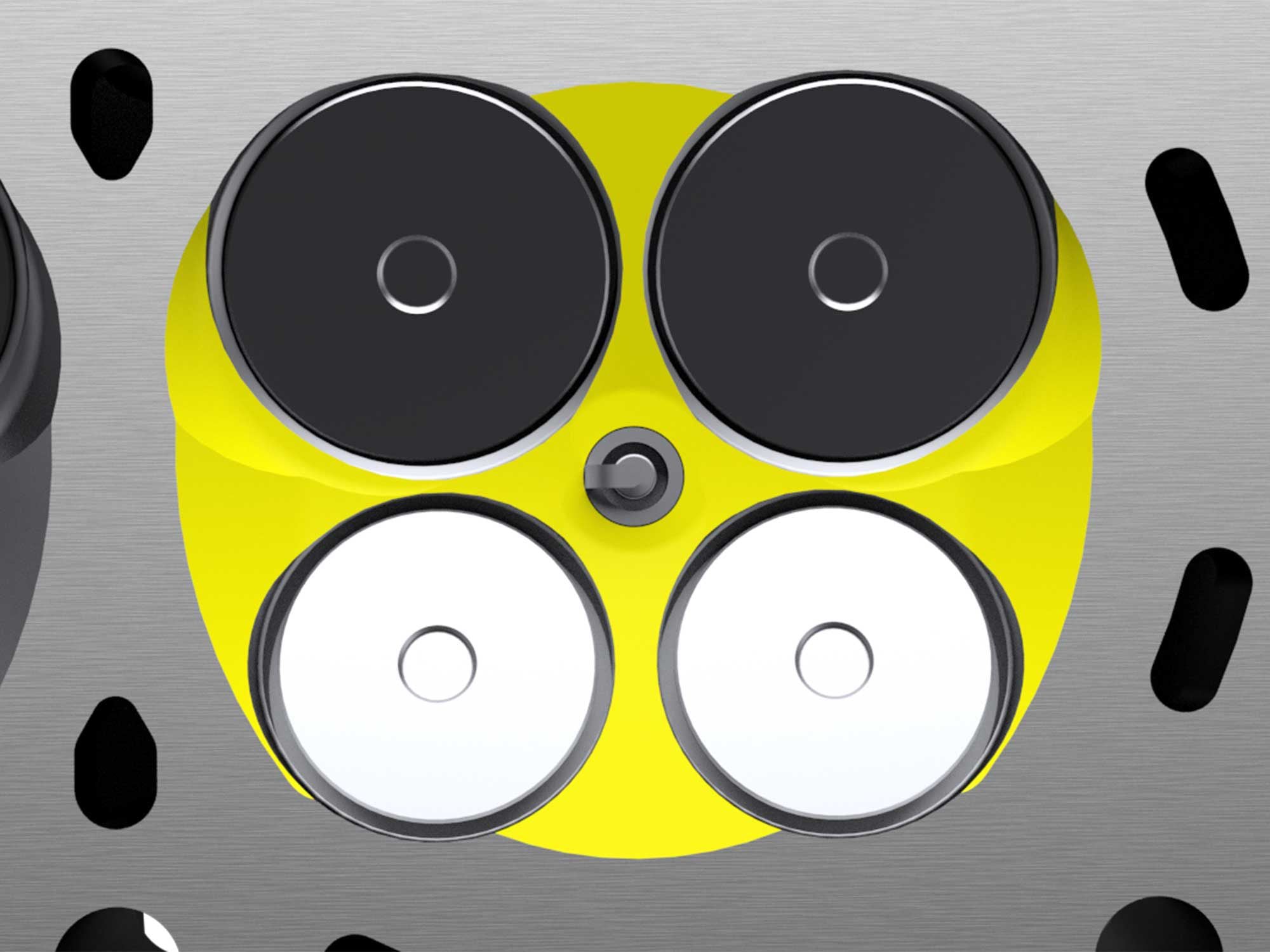
The third-generation Hayabusa combustion chamber. (Suzuki/)Suzuki found it could turn the loss of those squish cusps into increased “curtain area” to increase airflow at low valve lift. Curtain area is valve lift, multiplied times valve head circumference. Result: a flow gain of 5 percent at lower valve lifts. Also interesting is a 1mm reduction in throttle-body diameter, from 44 to 43mm, which slightly increases intake velocity. When change is forced upon you, exploit it as an opportunity.
Shorter Cam Timings Increase Valve Accelerations
Suzuki has increased exhaust valve lift to be essentially equal to intake lift and has somewhat reduced the number of degrees during which valves are open. Because both changes require more rapid valve accelerations, stiffer valve springs have been adopted. To carry the doubly increased load of these springs plus higher valve acceleration, cam lobes have been made wider so that the oil film between them and the valve tappets is not overloaded; the bigger the surfer, the bigger the board.
Sharp-eyed readers will see that to make the torque gains in the range of 3,300–7,000 rpm, some compromise has been necessary at higher rpm. A suite of changes to cam timing, possibly longer exhaust header pipe length, airbox resonance rpm range, and the lengthening of the intake tracts by half an inch, are probably responsible.
Altered Cam Timings Reduce UHC Emissions
Overlap is that time near TDC at the end of the exhaust stroke when the intake valves have already begun to open before top center, but the exhausts are still in the late stages of closing, slightly after top center. Valve overlap boosts performance because: 1) by allowing more time for valve opening and closing, valves can accurately follow cam contours without extremely stiff springs, and 2) if the exhaust pipes are properly dimensioned, a negative pipe wave can return to the cylinder to extract any residual exhaust gas above the piston and then travel past the partly open intake valves to begin the intake process early, even before the piston has begun to move downward on its intake stroke.
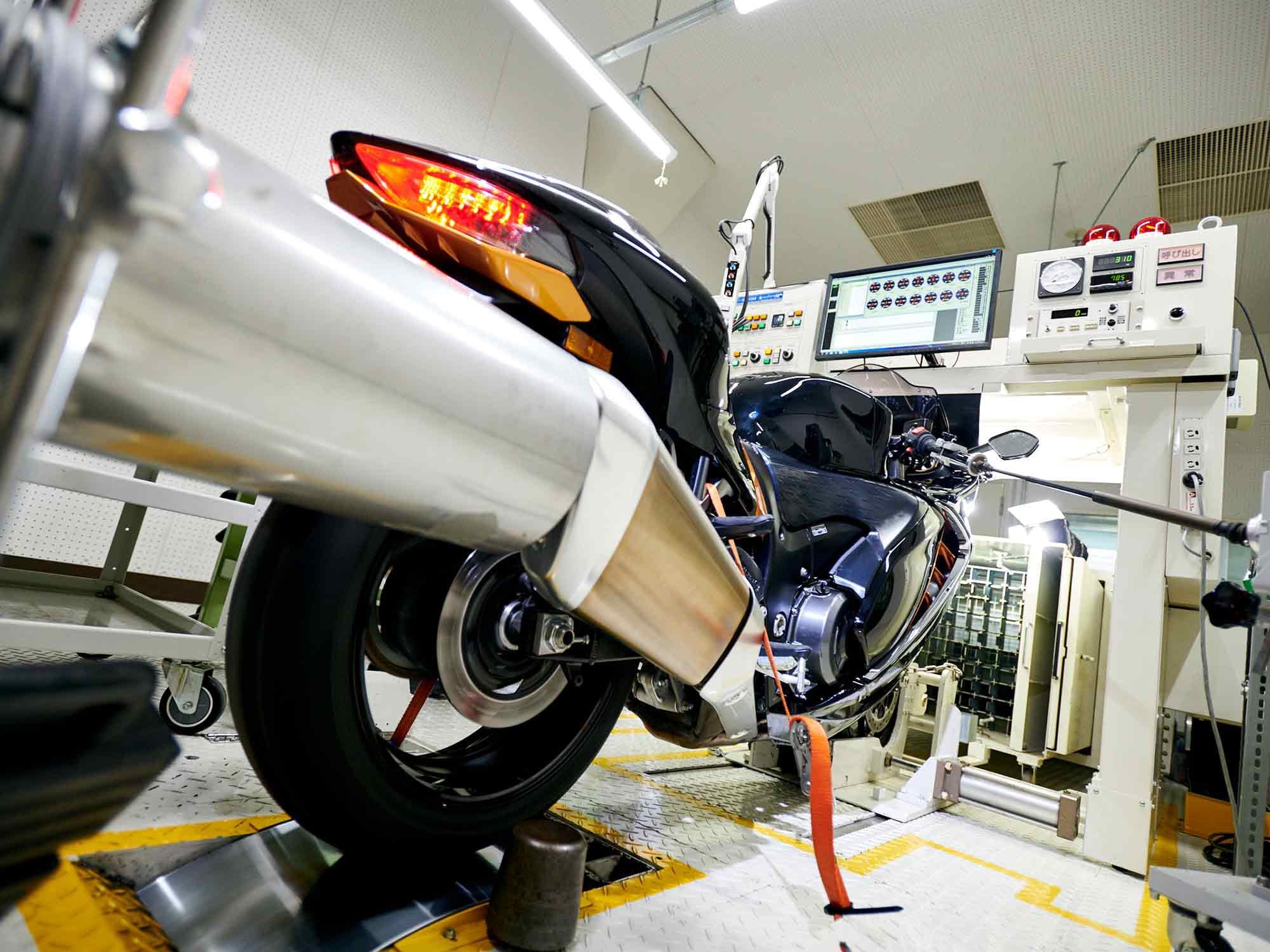
Cam timing was altered to reduce unburned hydrocarbon emissions on the 2022 Suzuki Hayabusa. (Suzuki/)This was more acceptable when motorcycle emissions standards were softer, but to pass Euro 5 some of that valve overlap had to go. That negative pipe wave that beneficially starts the intake process early can also suck fresh mixture from the intakes right into the exhaust pipe, creating detectable emissions of unburned hydrocarbons; even if the fuel injector hasn’t begun to spray yet, the intake ports always contain fuel vapor and droplets, and their walls are wet with fuel. As shown in Suzuki’s graphics, cam timings have been “scissored” just a bit, advancing the exhaust lobes and retarding the intakes in order to shorten valve overlap.
Reduction of valve overlap is an industry-wide trend, adopted to meet emissions standards. Done properly, it can also result in wider, more drivable torque; I have called this “emissions-driven torque flattening.” At Ducati, the low-overlap cams of its Diavel have given it the name “the 11°” because that is how little valve overlap it has. Even its super-performance V4 has only 26 degrees of overlap.
As you can see, some of the above changes are aimed at reducing emissions at their source in cylinder filling and combustion. These changes include shortened valve overlap, smaller fuel droplet sizes, improved transient mixture control, and reduced “quench” area (squish) between pistons and cylinder head.
Other changes, mainly the provision of two additional exhaust catalyst units, one in each muffler, seek to reduce emissions by “after-treatment,” altering the chemistry of the exhaust stream after spent combustion gas has left the cylinders.
In the bad old days of “sputter-and-stall” emissions controls on cars and bikes, many riders and drivers hoped to improve performance by removing or bypassing emissions devices. The coming of digital engine controls has allowed emissions technologies to be smoothly integrated such that throttle response and performance can remain excellent.
-
 1
1
-
-
-
Riding the 2021 Yamaha WR250F at Cahuilla Creek MX in Anza, California. (Mason Owens/)Every year a heavy focus is placed on motorcycle manufacturers’ newest motocross bikes as well as their cross-country racers and dual sports. However, sometimes it’s easy to overlook models that fall in between an off-road racebike, like the Yamaha YZ250FX, and a street-legal dirt bike such as the KTM 350 EXC-F. Although the Yamaha WR250F is not California green-sticker-eligible like some other manufacturers’ enduro models, it does qualify for a California red sticker like its YZ250FX counterpart.
Last year, Yamaha’s 250 four-stroke enduro model was granted many of the same updates the YZ250F received in 2019. The WR250F is unchanged mechanically for 2021. (Mason Owens/)Designed for trail riders and enduro racers alike, the WR250F received several updates last year, many of which were also given to the YZ250F in 2019. We did not get an opportunity to test the WR250F last year due to the pandemic, so we were extra excited to get our hands on the 2021 model, which is mechanically the same as last year’s bike. After weighing, measuring, and dynoing it, we took the WR250F to some of our favorite trails in SoCal’s high desert and ended our rides with an ear-to-ear grin.
Being that it’s an enduro bike, we would like to see the WR250F come with hand guards in stock trim. (Mason Owens/)2021 Yamaha WR250F Engine
While the WR250F has different ECU tuning than the YZ250FX and a Forestry Service-compliant spark arrestor-type muffler, the engine itself is the same as the YZ250FX. What’s different is the WR250F’s enduro-specific engine tuning, which naturally means the ignition and fuel-injection maps are designed for enduro riding and racing.
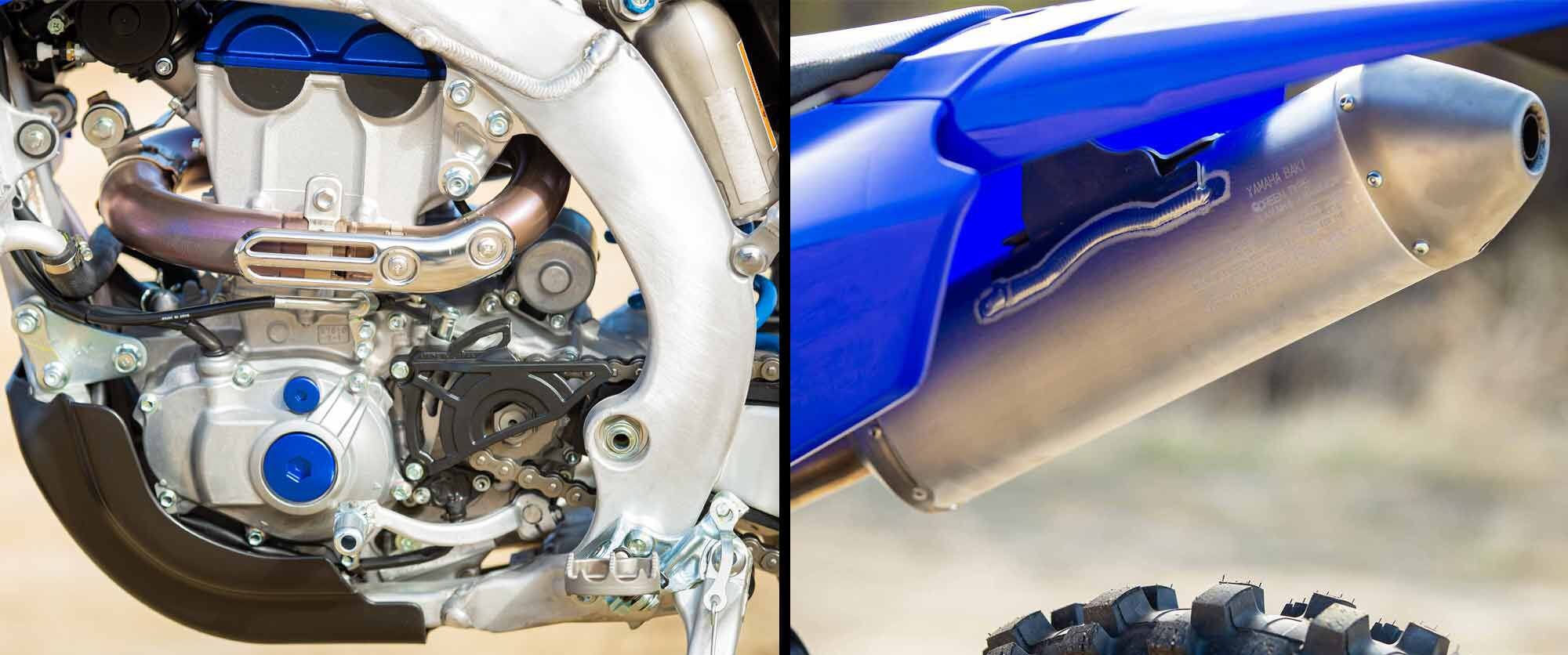
Aside from the ECU tuning and Forestry Service-compliant spark arrestor-type muffler, the WR250F’s engine package is the same as the YZ250FX’s. Our only gripe about the powerplant is that it’s a little hard to start when in gear. (Mason Owens/)What should be understood here is that because Yamaha designed the WR250F for enduro racing, the Tuning Fork guys made no attempt to make it a hybrid dual sport or, if you live in California, green-sticker-compliant. There is no carbon canister nor emission controls, which means you have a better-running enduro bike straight off the showroom floor. While the WR250F runs very well, its Forestry Service-compliant spark arrestor-type muffler causes its power output to be less than the YZ250FX and YZ250F, specifically 1.7 hp and 2.9 hp less at peak, respectively, than those two models.
The six-speed transmission is shared with the YZ250FX and offers optimized gear selection for technical terrain as well as wide-open fire roads. The first and second gears are particularly useful. In second gear, I was able to still get down to a very low speed without losing throttle response; yet I was able to carry that same gear much further than expected. Because of the surprisingly long second gear, the amount of shifting on tighter trails is noticeably reduced, as is the gap between second and third. As expected, fourth, fifth, and sixth gears have a little more of a noticeable gap on this wide-ratio gearbox.
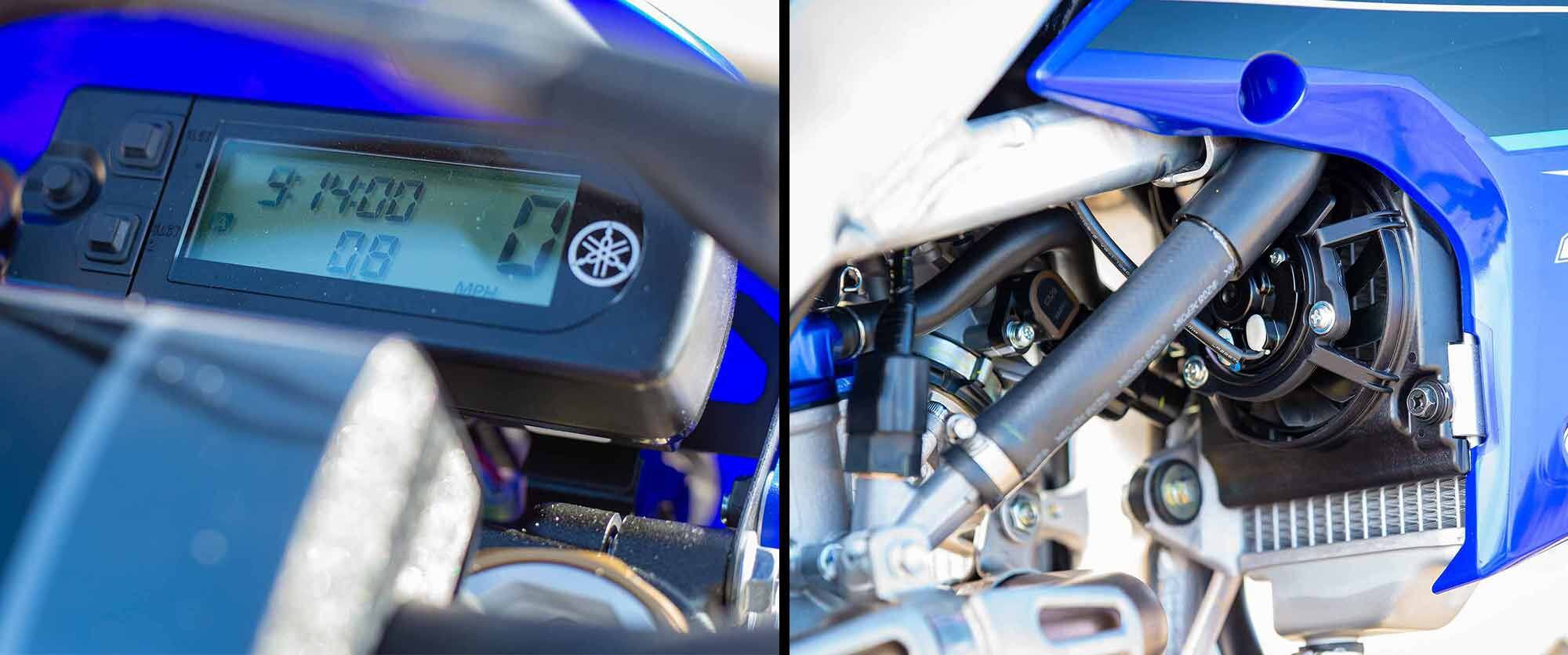
A couple of the WR250F’s enduro-specific features include a multifunction enduro meter and a radiator cooling fan. (Mason Owens/)The 2021 WR250F engine has received a clutch basket update for durability, and the overall performance remains very good. Even though the engine is slightly restricted, clutch fade is almost nonexistent due to good gear ratios and sufficient roll-on power to make abuse of the clutch unnecessary.
2021 Yamaha WR250F Suspension
The WR250F comes equipped with the same KYB Speed Sensitive System (SSS) coil-spring-type fork and KYB shock as the YZ250F, but with different valving and spring rates for enduro competition. Fork and shock travel are 12.2 inches and 12.5 inches, respectively. The fork is adjustable for compression and rebound damping, while the shock features spring preload, high-/low-speed compression, and rebound damping adjustability.
The WR250F is an incredibly comfortable ride. The suspension settings are noticeably softer in comparison to the motocross version, but still offer plenty of resistance to bottoming. The fork offers enough holdup under braking that you still have confidence to drive harder into corners in comparison to other models. While they are still plush enough in the initial part of the stroke, you can ride through rocky sections with comfort. The shock is well balanced in relation to the fork.
Although the WR250F’s engine is not quite the equal of the YZ250FX’s, it still makes plenty of usable power. (Mason Owens/)2021 Yamaha WR250F Chassis/Handling
Keeping in mind that last year’s WR250F was completely updated to the 2019–2020 YZ250F chassis design, no changes were made to the 2021 model. The WR250F shares the same frame, subframe, swingarm, and suspension as the highly rated YZ250F. The KYB SSS fork and KYB shock are some of the most highly praised stock suspension components available.
Some of the features differentiating the WR250F from its motocross-focused YZ250F counterpart include a larger 2.2-gallon fuel tank, which fits directly in place of the smaller motocross version without any unusual displacement of the bodywork; a radiator cooling fan, to assist in keeping the engine cool while negotiating tighter enduro-type trails; a full-coverage composite skid plate; an off-road-sized 18-inch rear wheel; Dunlop Geomax MX3S tires; a kickstand; a steel rear sprocket; and a sealed O-ring chain.
The KYB suspension settings are noticeably softer in comparison to the YZ250F but still offer plenty of resistance to bottoming. (Mason Owens/)Additionally, the WR has several enduro-specific features including fuel level and engine warning lights, a stylish front headlight, and a compact taillight. There is also a multifunction enduro meter that incorporates two tripmeters, a clock function, and a race mode featuring an average speed display and a timer.
How Does the 2021 Yamaha WR250F Ride?
This bike is about as close as you can get to the full-race motocross version while still checking almost all the enduro requirement boxes. There are zero changes to ergonomics, even with the larger fuel tank. It may be bigger, but it’s no wider, as the Yamaha designers found a way to extend the tank lower in the chassis. The headlight and taillight are both well thought out and stylish in design. The taillight also seems to be extremely durable in comparison to some models using a more street-legal assembly. Considering the restrictive spark arrestor-equipped muffler, the engine produces an impressive 36.1 hp on the dyno.
The WR250F’s engine power is certainly not equal to the YZ250FX or YZ250F, but it still makes plenty of usable power. The combination of gear ratios, engine settings, and rear sprocket size are well matched. First-gear crawling is very low, perhaps not two-stroke first-gear crawling low, but still impressive. Second gear is also usable down to almost the lowest possible speeds; the surprising part was how long it seemed to pull. I was able to make good use of second gear in single-track and did not have to shift nearly as often as expected, impressive for an enduro-tuned 250F powerband. Clicking up to third on flowing trails was also very good; keeping the revs up helped with recovery in some of the G-out sections where the rear suspension was a little softer. In fourth and higher, the bike ran clean with plenty of power for the two-track and fire-road sections.
The WR250F’s chassis offers amazing comfort while not giving up too much performance. (Mason Owens/)The WR250F has the same sitting-in-the-bike feel as the motocross version. It also feels very planted, and because of the softer suspension, corners well without losing any of the Yamaha trademark stability. For me, a slightly taller seat would be nice; luckily, several aftermarket options are available. Also, if you are 6 feet tall or more, consider moving the handlebar mounts into the forward holes with the mounts facing rearward, which might help open up the cockpit.
I rode this bike on two separate days at different locations and made zero adjustments. Straight off the showroom floor, I was able to ride the WR250F to 90 percent of my comfort zone and enjoy every minute of it. The most impressive thing was how well the whole package performed. We already know the YZ250F is at the top of its class; Yamaha has injected that DNA into its WR250F enduro racer.
If you want more performance from the WR250F, Yamaha offers a line of Genuine Yamaha Technology Racing (GYTR) performance products featuring more than 50 items including a fully loaded GYTR performance cylinder head assembly, high-compression piston, and performance exhaust system. If you plan on racing the WR250F, you will most likely want to purchase an aftermarket muffler; if you do so, keep in mind that GYTR offers a performance ECU, programmable via the Yamaha Power Tuner app, which requires the GYTR Communication Control Unit (CCU) to connect to your phone.
We already know the YZ250F is at the top of its class, and Yamaha has injected that DNA into its WR250F enduro racer. (Mason Owens/)Gearbox
Helmet: Shoei VFX-EVO
Goggle: Scott Prospect
Jacket: Alpinestars Session Race
Jersey: Alpinestars Techstar Venom
Gloves: Alpinestars Techstar
Pant: Alpinestars Techstar Venom
Boots: Alpinestars Tech 7
2021 Yamaha WR250F Tech Spec
PRICE $8,599 ENGINE 250cc, DOHC, liquid-cooled, single-cylinder four-stroke TRANSMISSION/FINAL DRIVE 6-speed/chain MEASURED HORSEPOWER 36.1 hp @ 12,000 rpm MEASURED TORQUE 17.9 lb.-ft. @ 8,100 rpm FRAME Aluminum bilateral beam FRONT SUSPENSION KYB Speed-Sensitive System (SSS) coil-spring fork, compression and rebound damping adjustable; 12.2 in. travel REAR SUSPENSION KYB shock, spring preload, high-/low-speed compression and rebound damping adjustable; 12.5 in. travel FRONT BRAKE Nissin 2-piston caliper, 270mm disc REAR BRAKE Nissin 1-piston caliper, 245mm disc WHEELBASE 58.3 in. MEASURED SEAT HEIGHT 37.6 in. FUEL CAPACITY 2.2 gal. MEASURED WEIGHT 254 lb. wet AVAILABLE Now CONTACT yamahamotorsports.com -
-
Triumph introduced the 2021 Tiger 850 Sport as a replacement for the base-model 900, distinguishing itself from the rest of the lineup as a more affordable and approachable middleweight adventure machine. The 850 Sport received slight revisions, as well as a price reduction to $11,995. Good stuff.
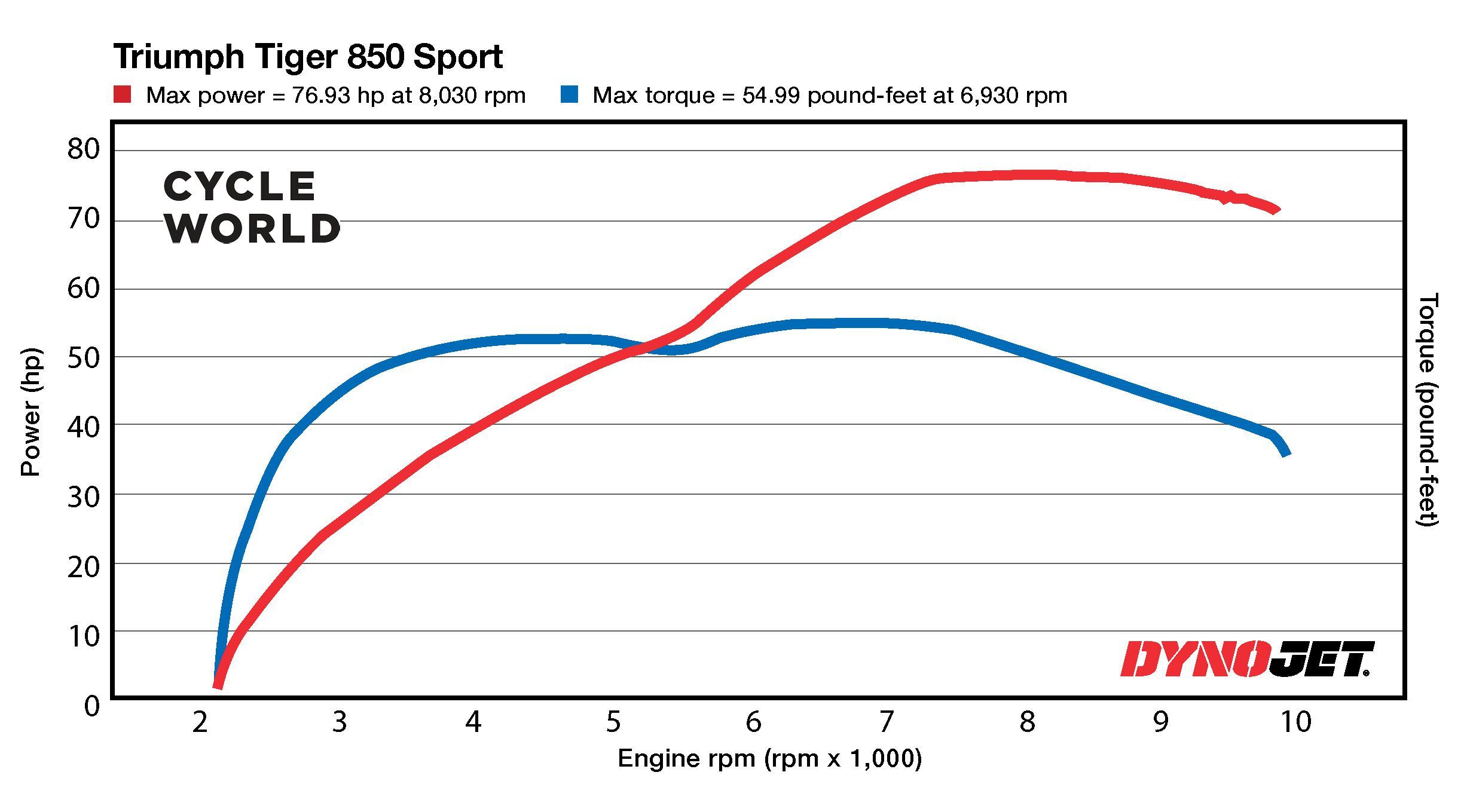
Triumph 2021 Tiger 850 dyno (Robert Martin/) The Tiger 850 Sport uses an identical 888cc, T-plane crankshaft, DOHC inline-triple engine as the 900 family, but with dedicated ECU settings. According to Triumph officials, the ECU tune is said to deliver usable torque lower at lower rpm while providing a friendlier, linear power delivery.
Ahead of an upcoming test, we strapped the Tiger 850 Sport to our in-house Dynojet 250i dyno, recording horsepower and torque measurements. The Tiger recorded a peak 76.93 hp at 8,030 rpm and 54.99 pound-feet at 6,930 rpm. Analyzing the curves, we see roughly 90 percent of usable torque is available from 3,500 rpm to 8,000 rpm, which makes for a seriously flexible a powerplant. Likewise, the power curve is incredibly smooth and linear.
-
Hello Alan1234,
Welcome to The Motorbike Forum. Please feel free to browse around and get to know the others. If you have any questions please don't hesitate to ask.
Why not tell us a bit about yourself too.
-
Traffic survival depends upon conspicuity so we added a deceleration light to our helmet to alert following traffic to our slowing intentions. Brake Free’s battery-powered 100-LED light supplements our brake lights in an effort to catch the attention of inattentive drivers. Watch the video to get Nick’s report.
-
-

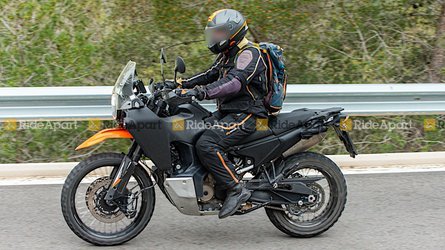
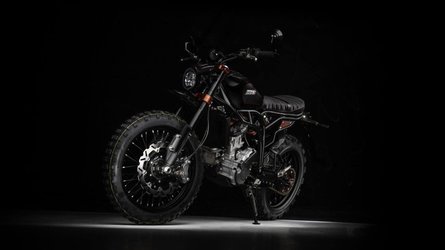
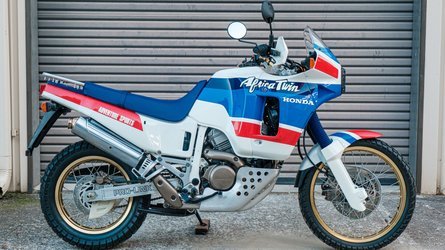
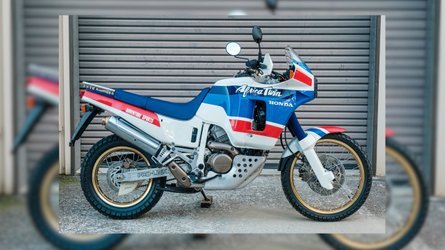
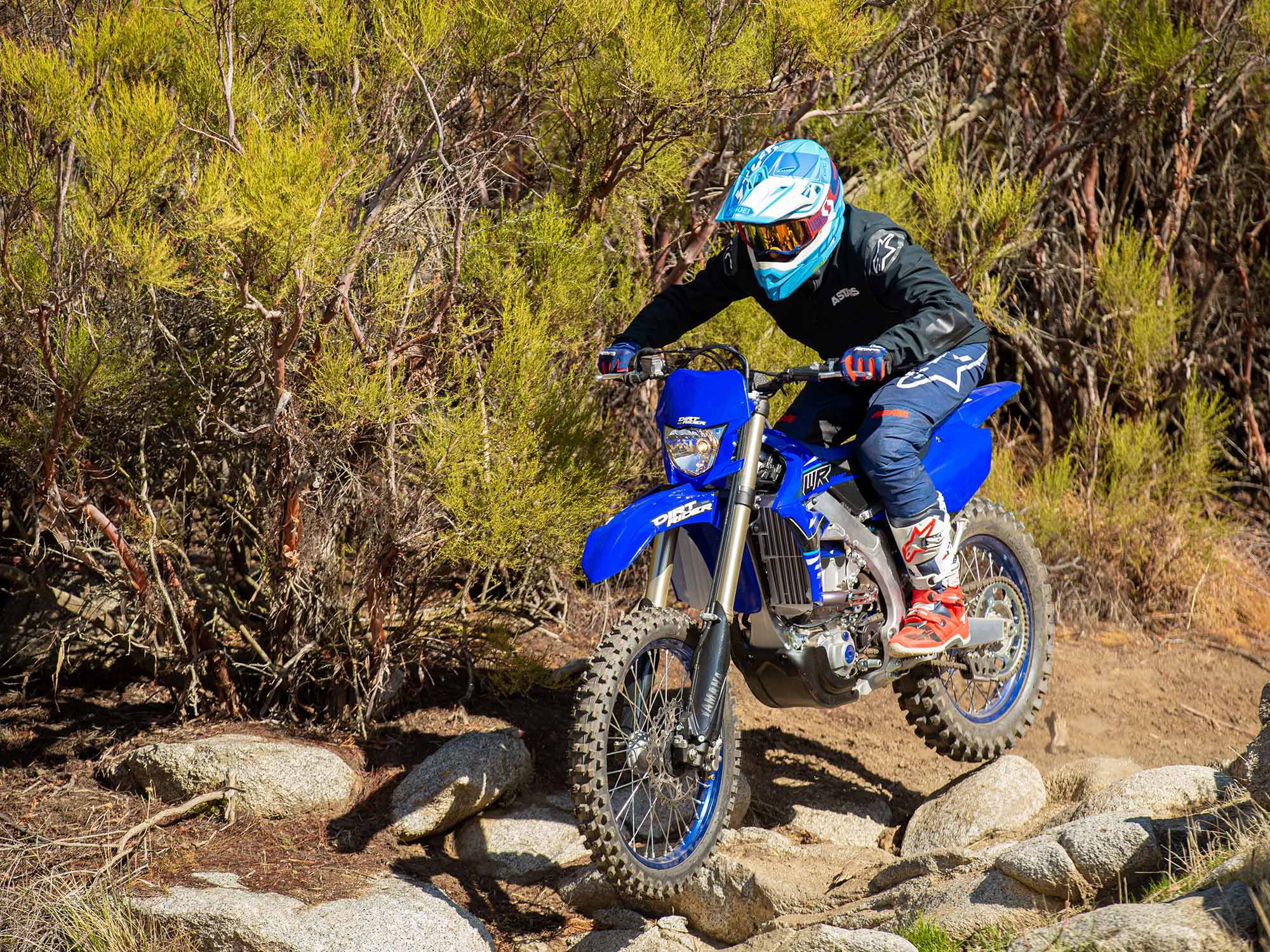
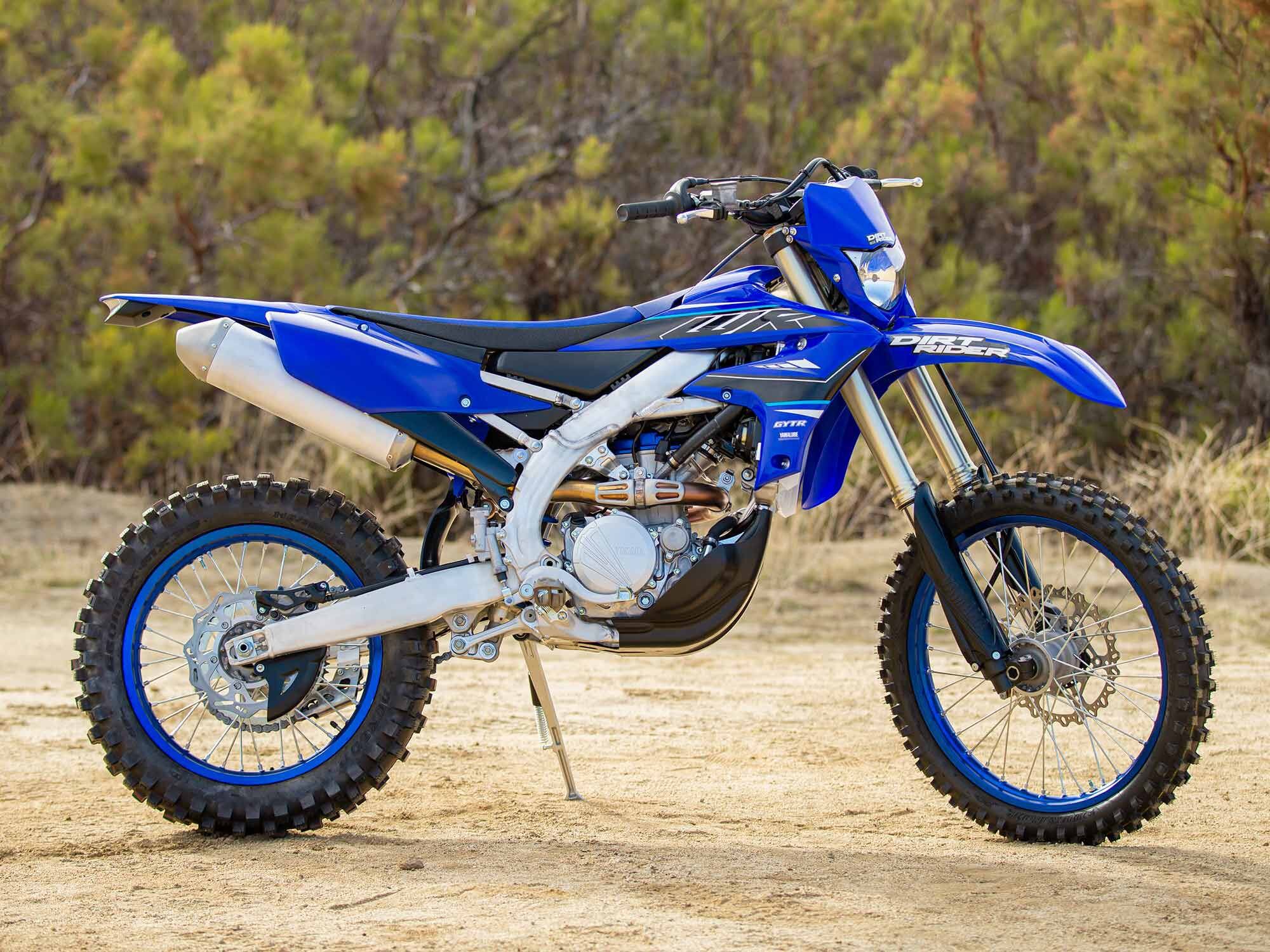
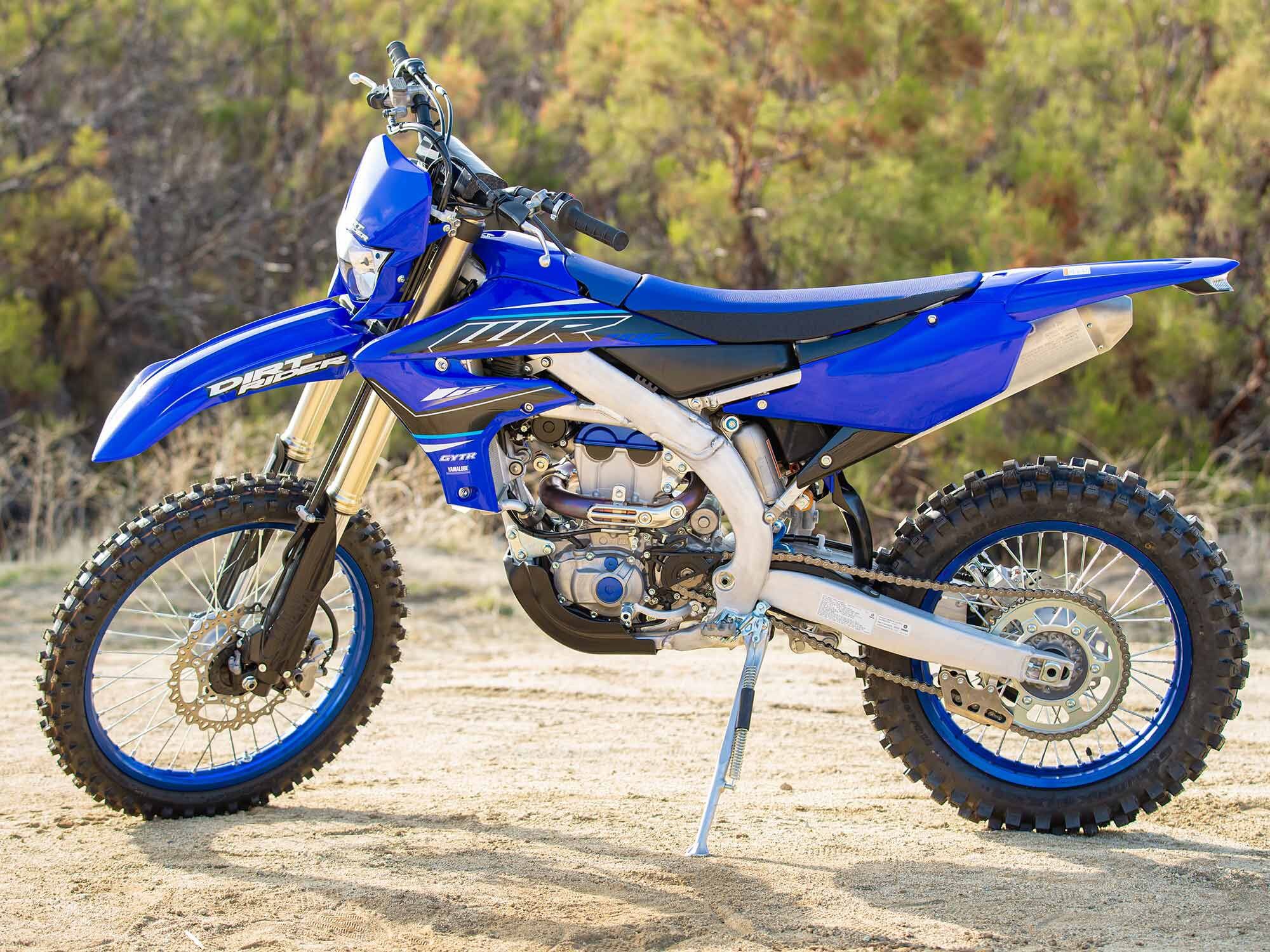
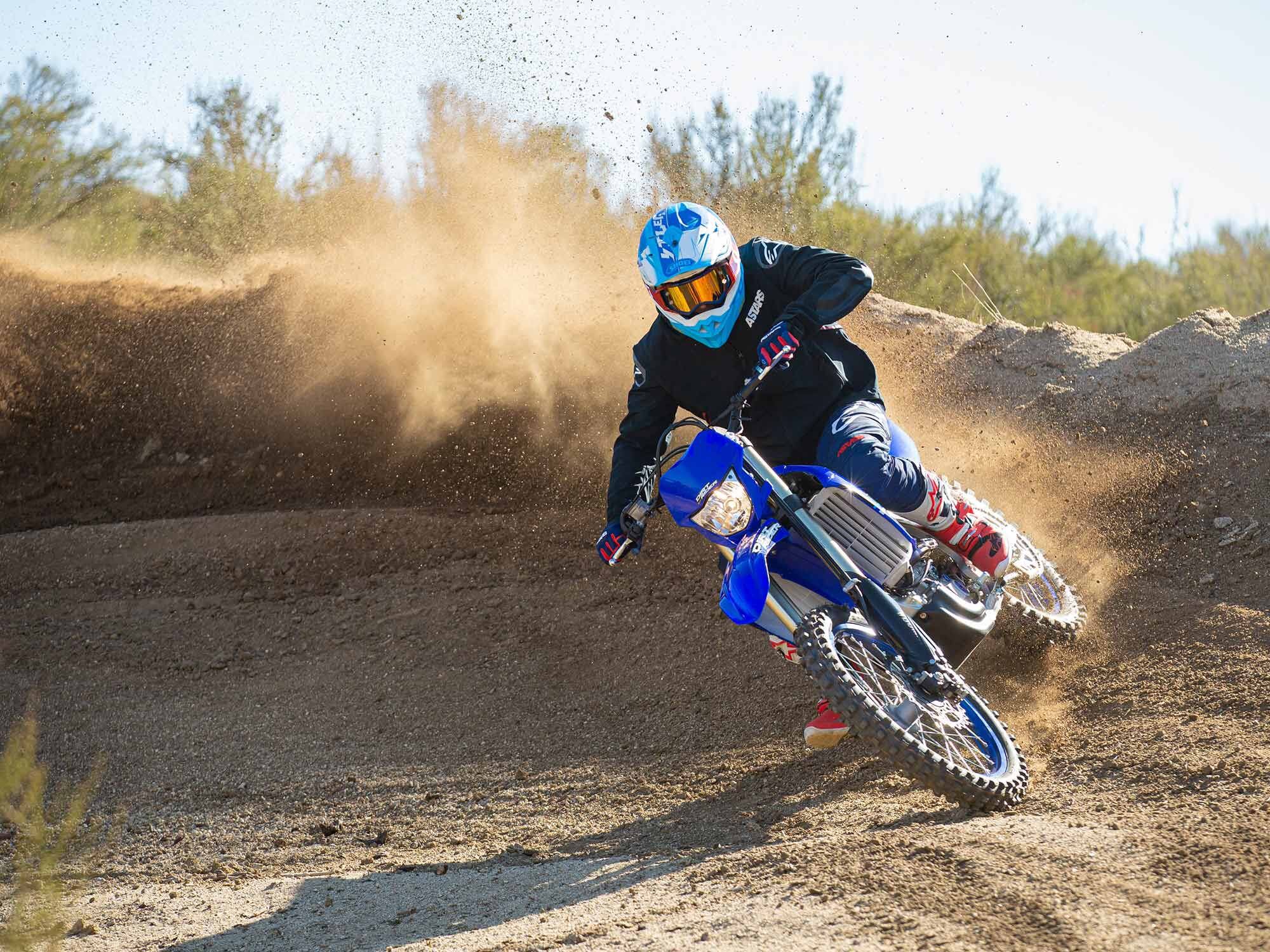
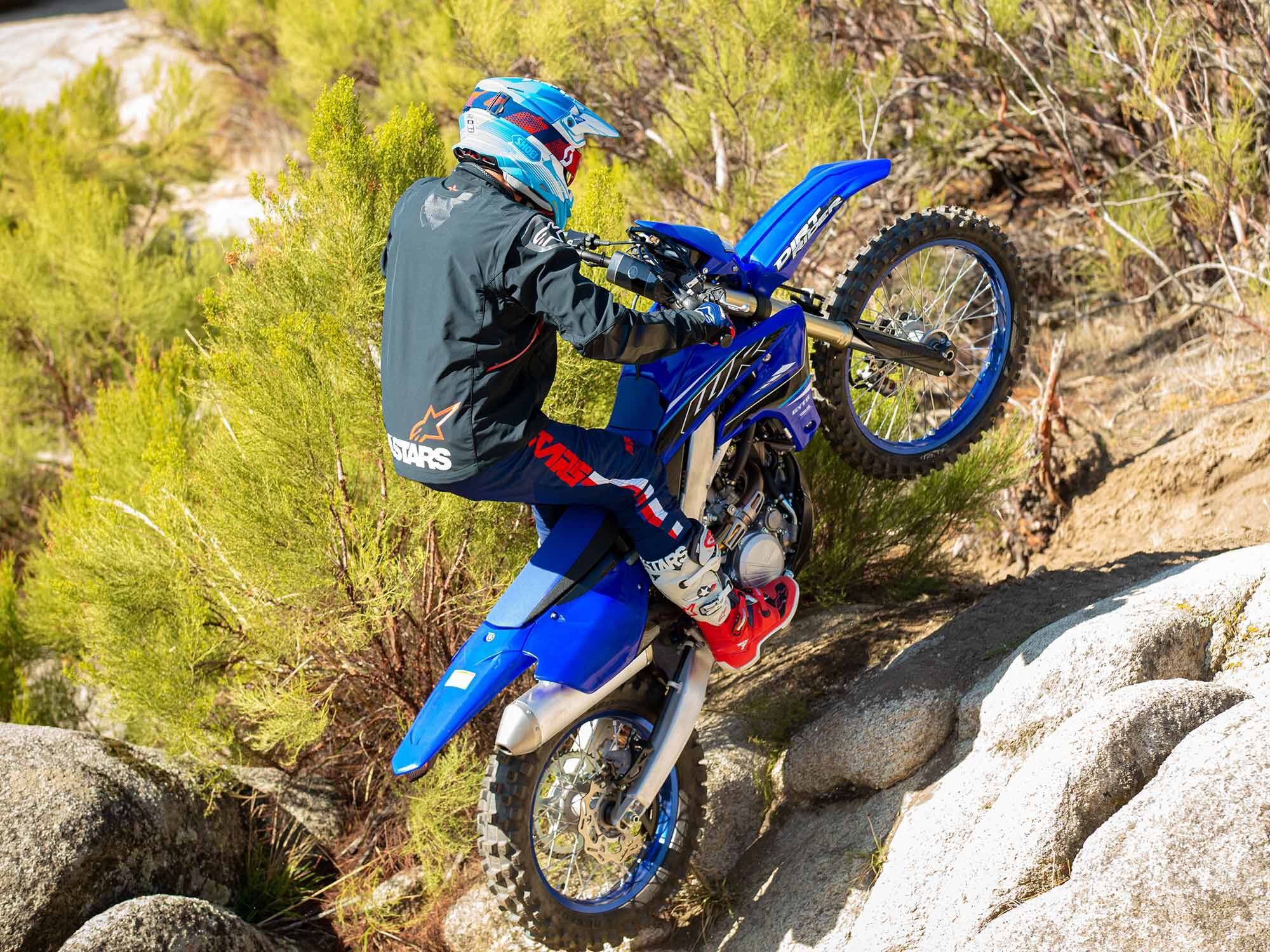
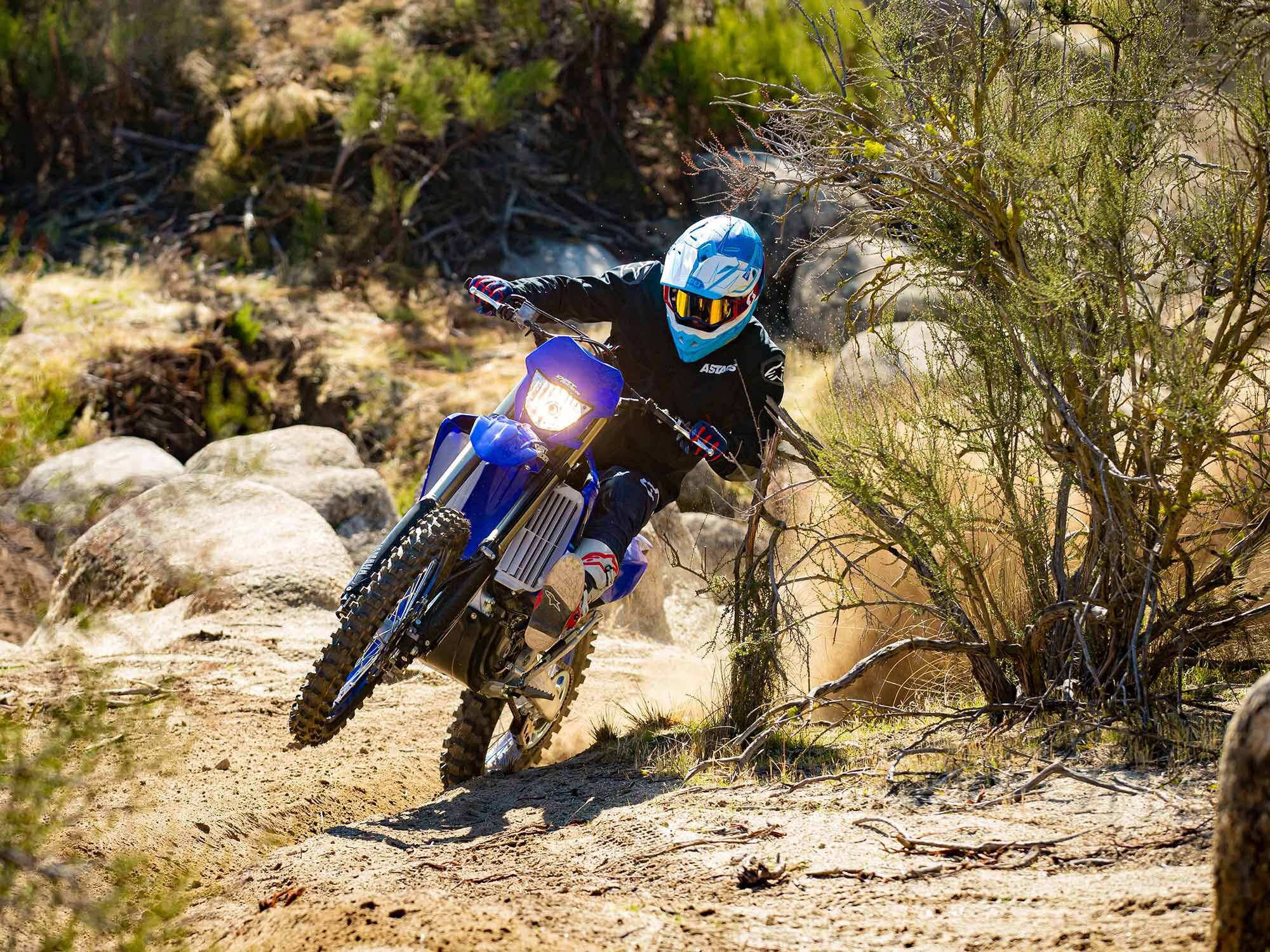
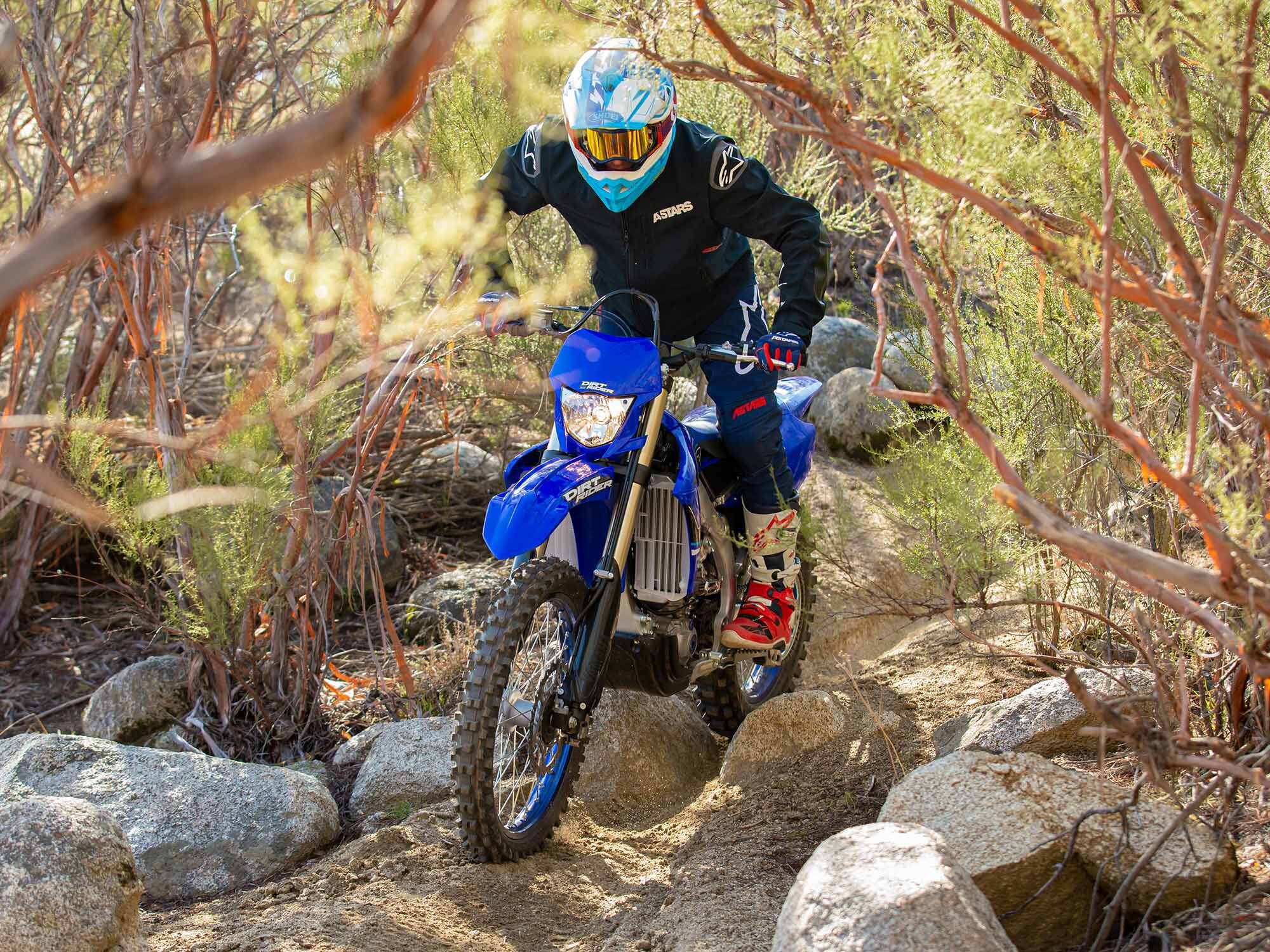
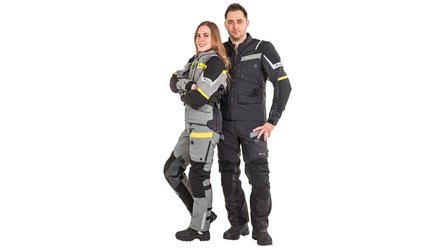
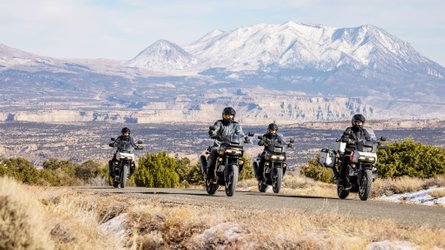
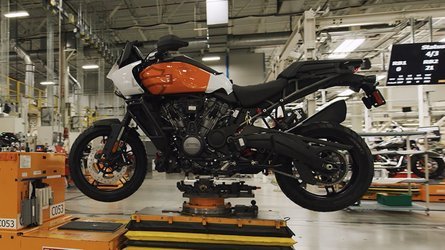
Welcome sh50Bandit
in Newbies
Posted
Hello sh50Bandit,
Welcome to The Motorbike Forum. Please feel free to browse around and get to know the others. If you have any questions please don't hesitate to ask.
Why not tell us a bit about yourself too.